We checked out of our Osaka hotel this morning and left behind another collection of empty saké bottles. Not sure what the cleaners might make of this, but I had fun! Today, we were leaving the Chuo Ward and heading to Osaka Station to put the bulk of our luggage into storage and head off for what we were hoping would be a seriously serene and very Japanese, traditional onsen (hot spring) experience in a ryokan (inn) in a town called Takatsuki. Takatsuki is a town about the size of Toowoomba and roughly half-way between Osaka and Kyoto. But not before we did a spot of shopping at Osaka Station… it might sound odd to be shopping at a train station, but this particularly large station has two massive 13 and 11 floor shopping malls above it complete with food courts, restaurant halls, outdoor garden recreation areas – you name it. We have been wondering what Japan’s unemployment rate is like lately, (currently a seasonally adjusted 2.3%) because we keep seeing people doing jobs that just don’t really exist at home… from elevator attendant, to gift wrappers, to doormen and taxi management staff. In one store I had four people assisting me to buy some chopsticks! Everywhere feels overstaffed, it makes you wonder how companies are making any money.
Today, we were leaving the Chuo Ward and heading to Osaka Station to put the bulk of our luggage into storage and head off for what we were hoping would be a seriously serene and very Japanese, traditional onsen (hot spring) experience in a ryokan (inn) in a town called Takatsuki. Takatsuki is a town about the size of Toowoomba and roughly half-way between Osaka and Kyoto. But not before we did a spot of shopping at Osaka Station… it might sound odd to be shopping at a train station, but this particularly large station has two massive 13 and 11 floor shopping malls above it complete with food courts, restaurant halls, outdoor garden recreation areas – you name it. We have been wondering what Japan’s unemployment rate is like lately, (currently a seasonally adjusted 2.3%) because we keep seeing people doing jobs that just don’t really exist at home… from elevator attendant, to gift wrappers, to doormen and taxi management staff. In one store I had four people assisting me to buy some chopsticks! Everywhere feels overstaffed, it makes you wonder how companies are making any money. We did a bit of shopping and decided to stop for a nice lunch before taking our train out to Takatsuki. The food in any large shopping mall or department store here is always confectionary, groceries and take out style food in the basement levels and more intimate cafes and restaurants on the uppermost levels – seems a bit counter-intuitive to me, if you can’t find anything that takes your fancy, you find yourself traversing up to 12 floors of escalators to find the other food outlets.
We did a bit of shopping and decided to stop for a nice lunch before taking our train out to Takatsuki. The food in any large shopping mall or department store here is always confectionary, groceries and take out style food in the basement levels and more intimate cafes and restaurants on the uppermost levels – seems a bit counter-intuitive to me, if you can’t find anything that takes your fancy, you find yourself traversing up to 12 floors of escalators to find the other food outlets.
We chose a restaurant specialising in beef dishes – and were pretty confident it was going to be good because there was a line 20 deep waiting to get in.
Mackerel ‘cooked’ in vinegar and salt.
 Fried tofu in some delicious but unknown sauce.
Fried tofu in some delicious but unknown sauce. Beef three ways, beef stew, beef nibblets of some sort and seared beef tongue. It was really good.
Beef three ways, beef stew, beef nibblets of some sort and seared beef tongue. It was really good.
 After lunch we made our way to the trains – yet again – and head out to the Sansuisan Ryokan in Takatsuki. We had an uneventful train ride, though there was a pretty serious cockup at the other end. We had requested a shuttle from the hotel to get us out to the onsen but were given no details where the shuttle bus meet-up point was. When we called up about it, we encountered some pretty serious language barriers and couldn’t make out what was going on. We ended up giving up and hopping a cab to get there, and on arrival were greeted by someone who told us that ‘someone else had taken our shuttle who was booked in for tomorrow night not tonight’. I kinda thought that missing the shuttle a lesser cock-up than turning up to a fully booked hotel on the wrong day and having to go away again… but it has made me determined to learn some useful Japanese before I come back here again. “Please”, “Thank you”, “Excuse me”, “How much is this, please?” and “Two sakes please” is just not enough to get by when the logistics start going pear-shaped.
After lunch we made our way to the trains – yet again – and head out to the Sansuisan Ryokan in Takatsuki. We had an uneventful train ride, though there was a pretty serious cockup at the other end. We had requested a shuttle from the hotel to get us out to the onsen but were given no details where the shuttle bus meet-up point was. When we called up about it, we encountered some pretty serious language barriers and couldn’t make out what was going on. We ended up giving up and hopping a cab to get there, and on arrival were greeted by someone who told us that ‘someone else had taken our shuttle who was booked in for tomorrow night not tonight’. I kinda thought that missing the shuttle a lesser cock-up than turning up to a fully booked hotel on the wrong day and having to go away again… but it has made me determined to learn some useful Japanese before I come back here again. “Please”, “Thank you”, “Excuse me”, “How much is this, please?” and “Two sakes please” is just not enough to get by when the logistics start going pear-shaped.
We did, however, arrive safely and close enough to on time, so let’s call that a win. We were shown to our room and immediately treated to green tea and a rundown on which onsens were open for men, and which ones were open for women, and a discussion on how they would swap in the morning and to please check before entering any onsens! Some yakutas (light indoor/summer kimono style gowns) and slippers were provided for our use during our stay, and I did some quick googling to make sure we didn’t screw up on any onsen etiquette! There is a great article here on ryokan and onsen etiquette, which I found pretty useful and took a bit of the mystery out of what to expect and how not to look like a boorish foreigner!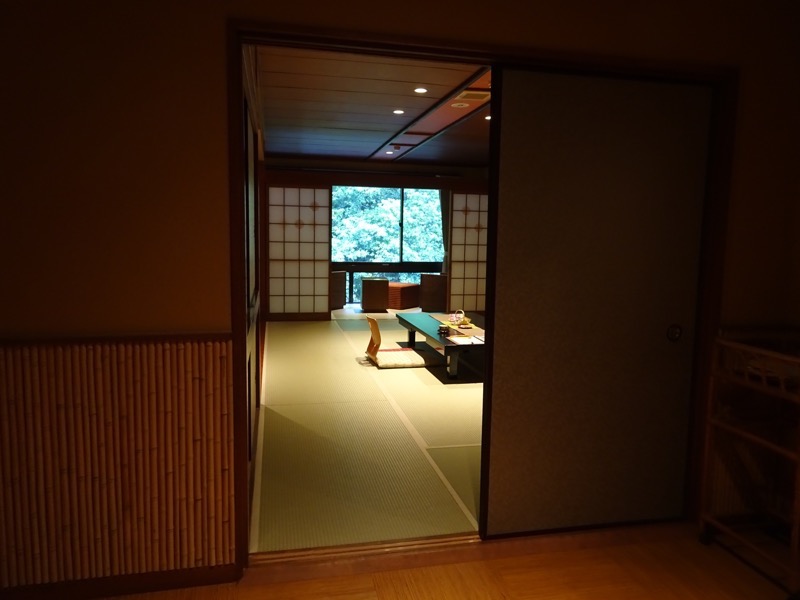 Our room made up for day use – later while we were dining someone would come in and set out futons for us… this seems like a great plan, as the room can accommodate one or half a dozen if needs be – none of this Western hotel ‘family room with four beds’ required type thing. The tatami mats are lovely to walk on, and it’s socks or bare feet only once you step up into the room.
Our room made up for day use – later while we were dining someone would come in and set out futons for us… this seems like a great plan, as the room can accommodate one or half a dozen if needs be – none of this Western hotel ‘family room with four beds’ required type thing. The tatami mats are lovely to walk on, and it’s socks or bare feet only once you step up into the room.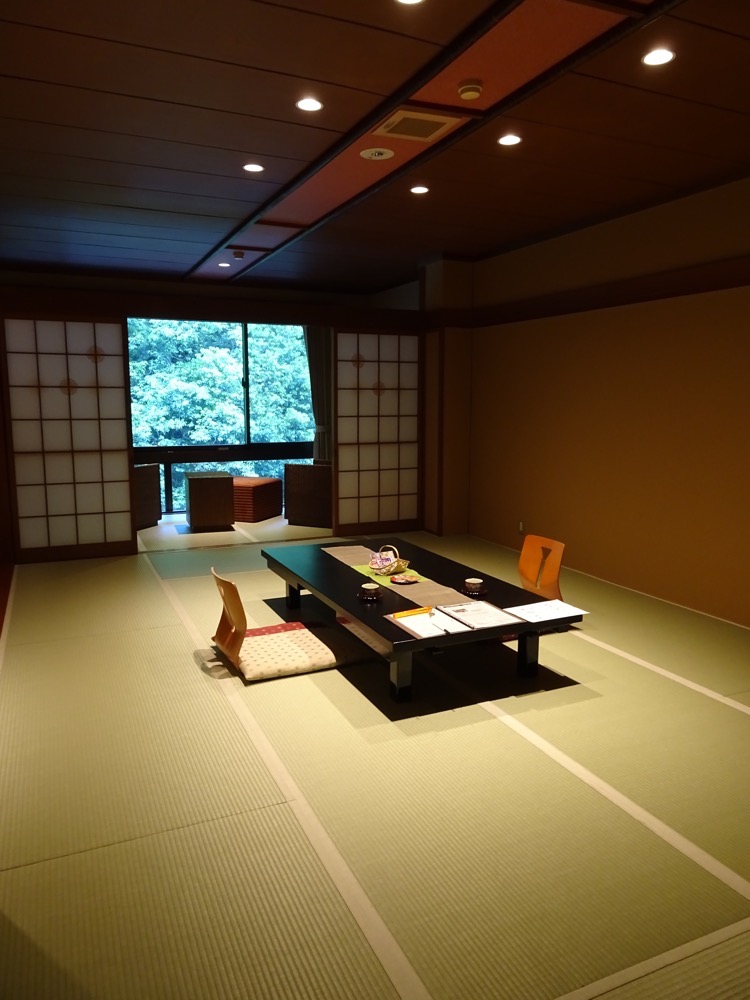
 Our room had a view over the river and we could hear the moving water babbling outside the window all night. We also saw many great cranes flying in and around the gorge. It was truly very peaceful and relaxing after coming from the hustle and bustle of Osaka!
Our room had a view over the river and we could hear the moving water babbling outside the window all night. We also saw many great cranes flying in and around the gorge. It was truly very peaceful and relaxing after coming from the hustle and bustle of Osaka!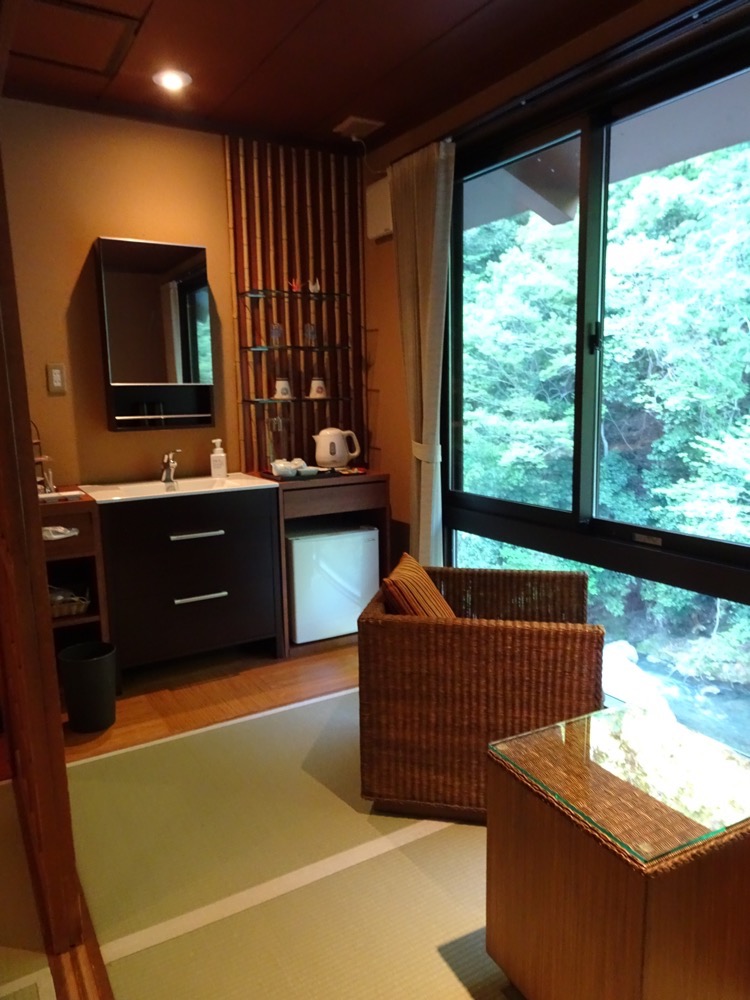
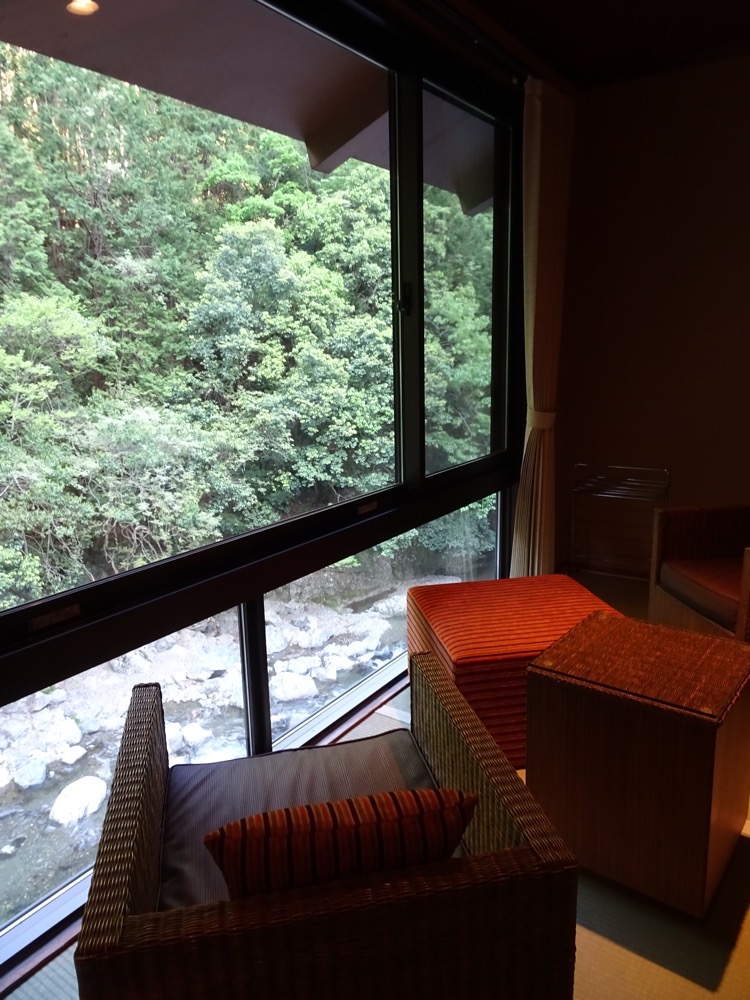
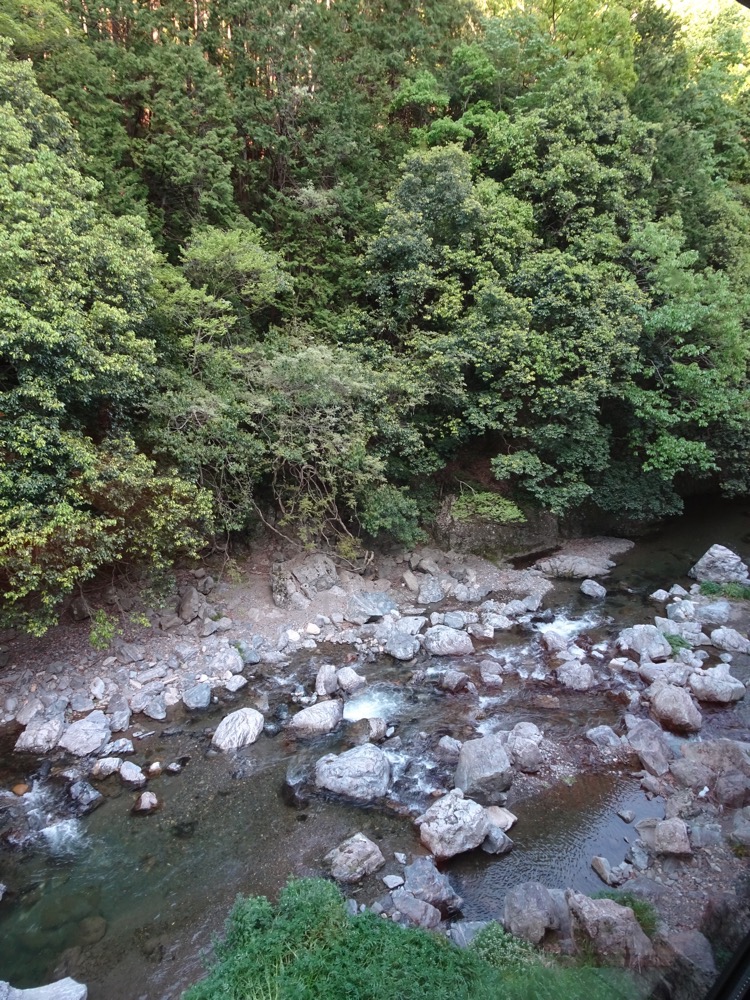

After we had oriented ourselves and had some tea, I went out to check out the facilities, in particular, the outdoor onsen which was accessible from the same floor as our room and currently marked for women’s use… there is no photography allowed in the onsens as nude bathing is mandatory, but when I arrived there, it was unoccupied, so I took a number of photos, from the lovely canopy of Japanese maples that provided privacy and shade to the lovely natural looking rock pool.

 I was quite concerned about the general ‘no tattoos’ policy that applies in most public baths throughout Japan (tattoos being associated with Yakuza – organised crime gangs who would use the bathhouses to conduct business) but the host who greeted us waived away my concerns and said ‘Tattoo – no problem, no problem’… I was still a bit apprehensive, as he had only seen the bee on my ankle, not the large Asian style dragon tattoo on my left shoulder!
I was quite concerned about the general ‘no tattoos’ policy that applies in most public baths throughout Japan (tattoos being associated with Yakuza – organised crime gangs who would use the bathhouses to conduct business) but the host who greeted us waived away my concerns and said ‘Tattoo – no problem, no problem’… I was still a bit apprehensive, as he had only seen the bee on my ankle, not the large Asian style dragon tattoo on my left shoulder! With the women’s outdoor onsen empty, I raced back inside to change and come out for a nice private bath. I got showered (as is custom before getting in the baths) and dressed in my yakuta and by the time I got outside, there was a Japanese lady and a small boy who I presume was her son in the bath. Now, they modestly turned away as I slipped into the pool, but I was then faced with a dilemma – do I face them, leaving the poor lady to repeatedly remind her young not to stare at the big boobied (some gestures are universal regardless of language barriers!) or do I turn my back to her and display my large back tattoo? Oi! Within minutes the issue was quickly negated as she decided to remove herself and her son from the onsen… I hope I didn’t chase them out, but I have a feeling I did.
With the women’s outdoor onsen empty, I raced back inside to change and come out for a nice private bath. I got showered (as is custom before getting in the baths) and dressed in my yakuta and by the time I got outside, there was a Japanese lady and a small boy who I presume was her son in the bath. Now, they modestly turned away as I slipped into the pool, but I was then faced with a dilemma – do I face them, leaving the poor lady to repeatedly remind her young not to stare at the big boobied (some gestures are universal regardless of language barriers!) or do I turn my back to her and display my large back tattoo? Oi! Within minutes the issue was quickly negated as she decided to remove herself and her son from the onsen… I hope I didn’t chase them out, but I have a feeling I did.  After they left I had this little paradise all to myself for about half an hour – I wish it was longer, but I found the water temperature was just a bit too hot for me at 42℃, and I literally couldn’t stay in any longer. I made a mental note to take some cold water to the private bath we had booked for after dinner, which is the only way that men and women can bathe together.
After they left I had this little paradise all to myself for about half an hour – I wish it was longer, but I found the water temperature was just a bit too hot for me at 42℃, and I literally couldn’t stay in any longer. I made a mental note to take some cold water to the private bath we had booked for after dinner, which is the only way that men and women can bathe together.
While I was in the outdoor onsen, Mr K was using one of the indoor onsens that was designated for men’s use at that time. He said that onsen was very busy and had a more modern and formal change room with lockers etc, and a tiled bathing area.
After our first foray into Japanese style same-sex bathing onsens, we got dressed in our yakuta and went down for our 7:30pm dinner reservation. The dinner is a set menu that is included in our room rate, they merely enquired as to whether we had any allergies and then we were in their hands for the meal. Our meal was exquisitely presented, everything on its own individual little dishes, served with the appropriate sauce, pickle or condiment. First course consisted of some sort of green tofu served with wasabi, some mollusc of unknown genus, a very mysterious but tasty fern frond and some pickles. In the little jar on the bottom right was some shrimp on a very tasty bean paste concoction.
Our meal was exquisitely presented, everything on its own individual little dishes, served with the appropriate sauce, pickle or condiment. First course consisted of some sort of green tofu served with wasabi, some mollusc of unknown genus, a very mysterious but tasty fern frond and some pickles. In the little jar on the bottom right was some shrimp on a very tasty bean paste concoction.
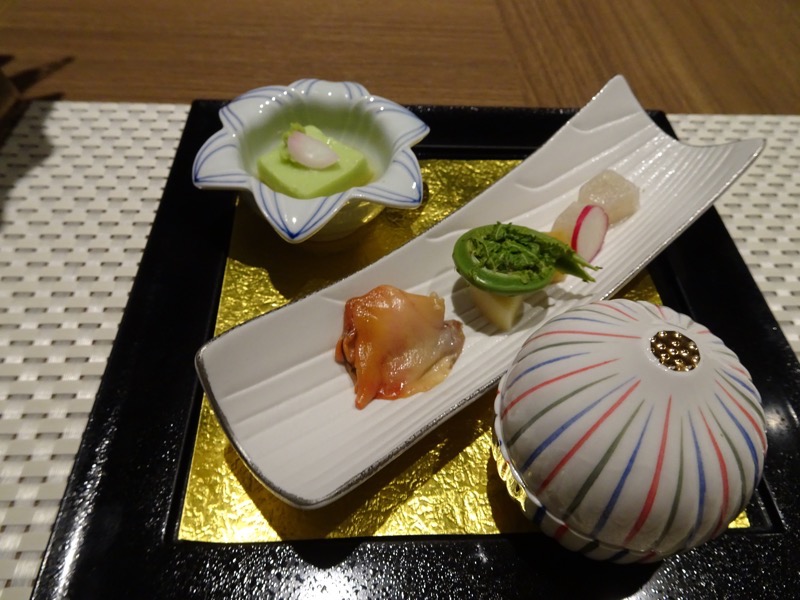 Off to our sides were individual steamboat chicken dishes, with mushroom and vegetables making a very tasty broth.
Off to our sides were individual steamboat chicken dishes, with mushroom and vegetables making a very tasty broth.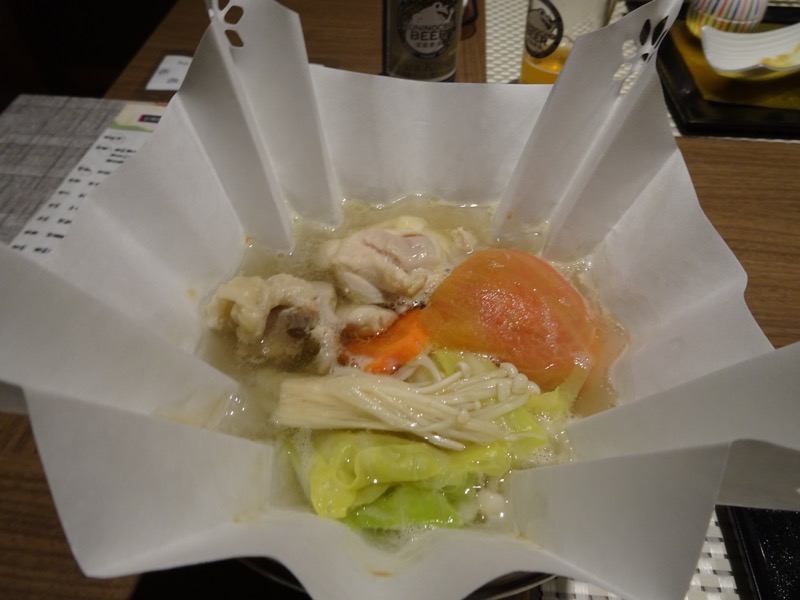
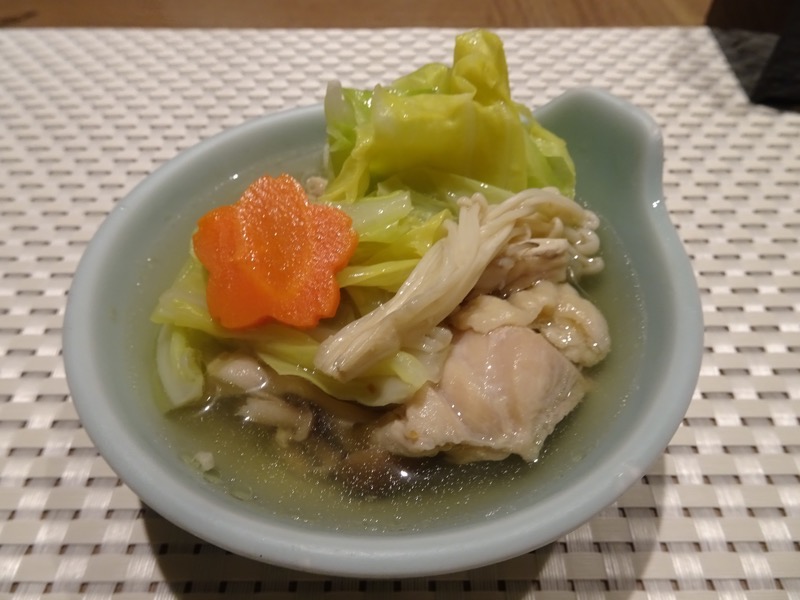
 Of course, I ordered some sake, and Mr K tried a local beer. Next course was some sashimi, with tuna, mackerel, salmon and shrimp.
Of course, I ordered some sake, and Mr K tried a local beer. Next course was some sashimi, with tuna, mackerel, salmon and shrimp.
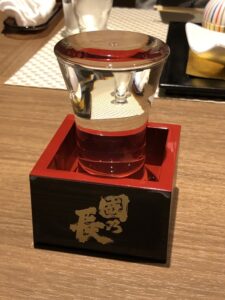

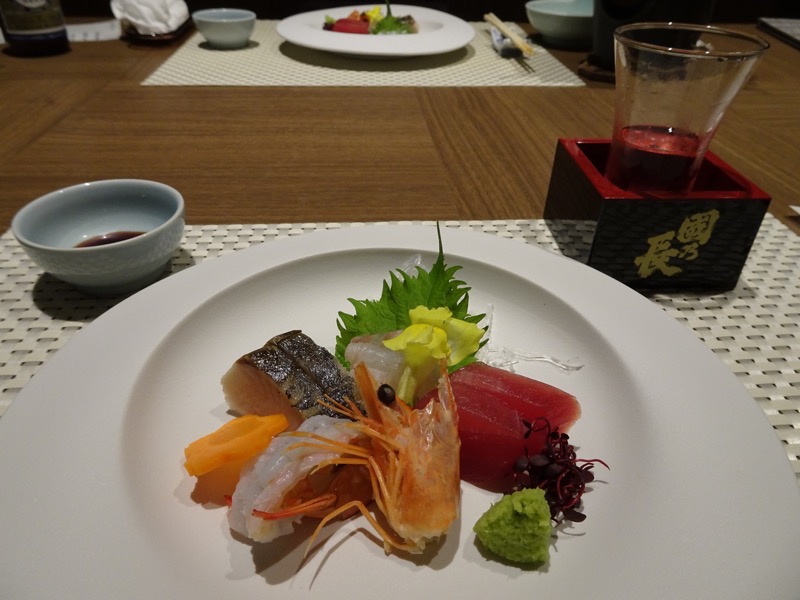 Followed by a yam cake with fish on it cooked in a cherry blossom broth… very unusual.
Followed by a yam cake with fish on it cooked in a cherry blossom broth… very unusual.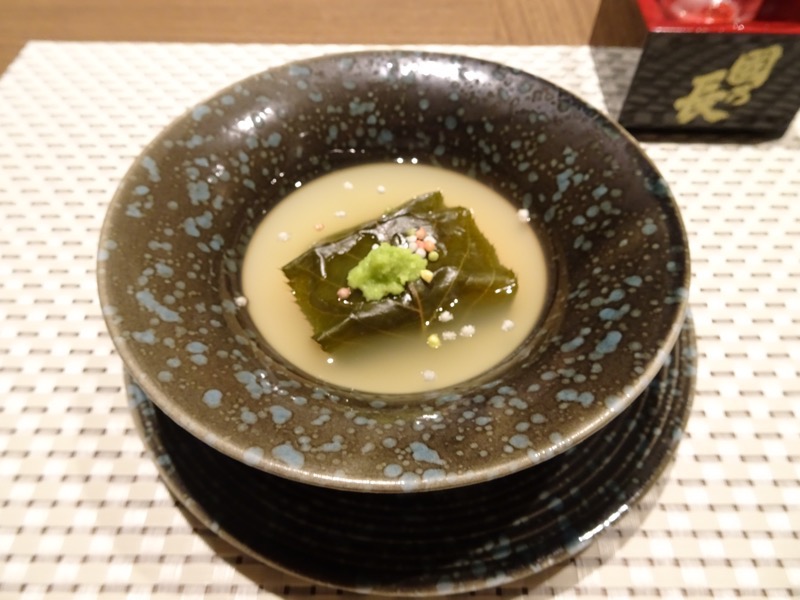 At this point I wasn’t quite sure when the little meals were going to stop coming – the next dish was a baked trout with vegetables and miso flavours.
At this point I wasn’t quite sure when the little meals were going to stop coming – the next dish was a baked trout with vegetables and miso flavours.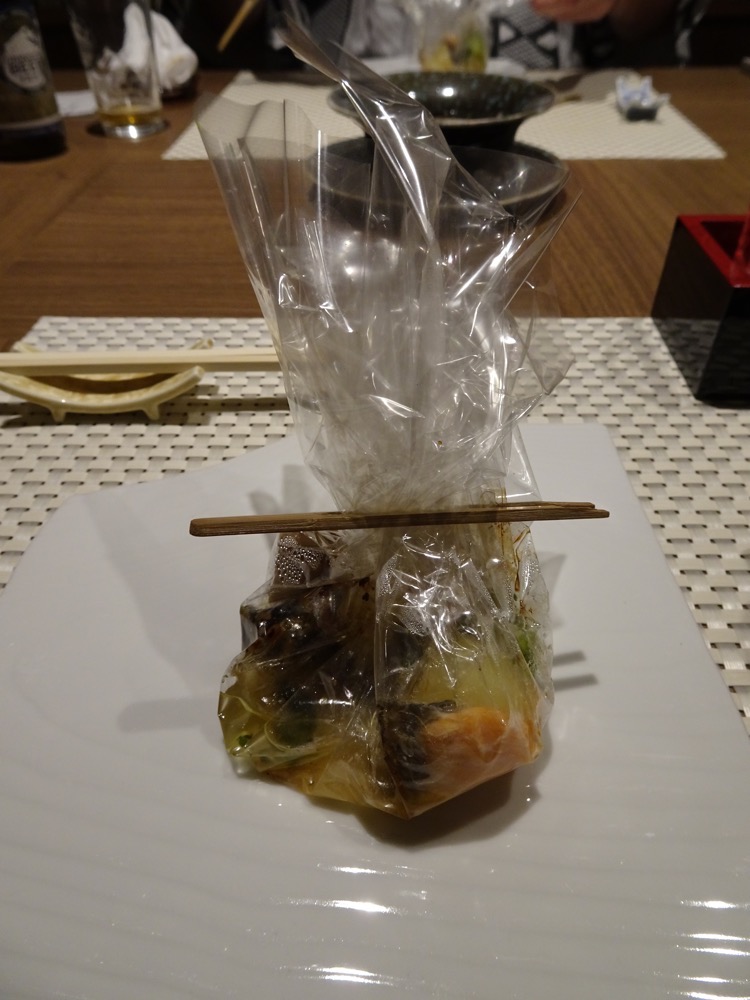
 After that, our chef brought out thin sliced, rare roast beef also served with some unique sauce that I couldn’t for the life of me tell you what it was.
After that, our chef brought out thin sliced, rare roast beef also served with some unique sauce that I couldn’t for the life of me tell you what it was.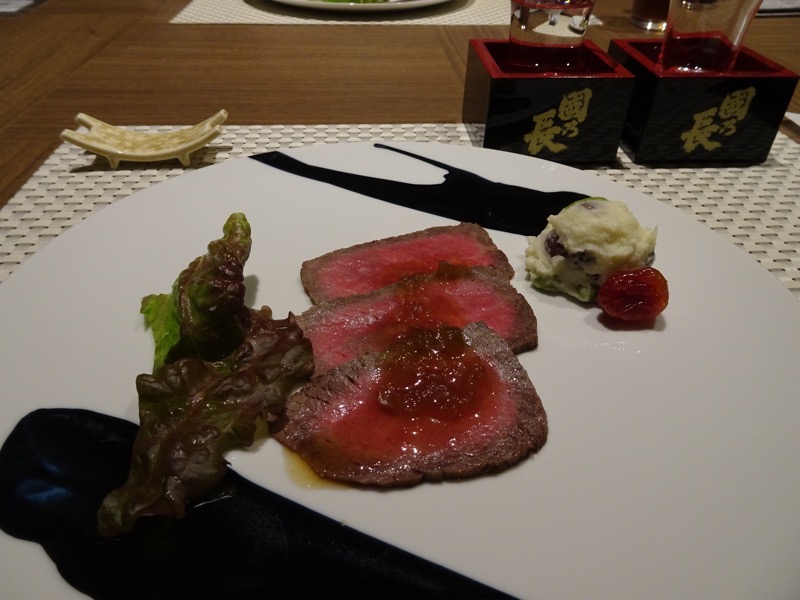 THEN… a soba noodle dish served with tempura seafood.
THEN… a soba noodle dish served with tempura seafood. 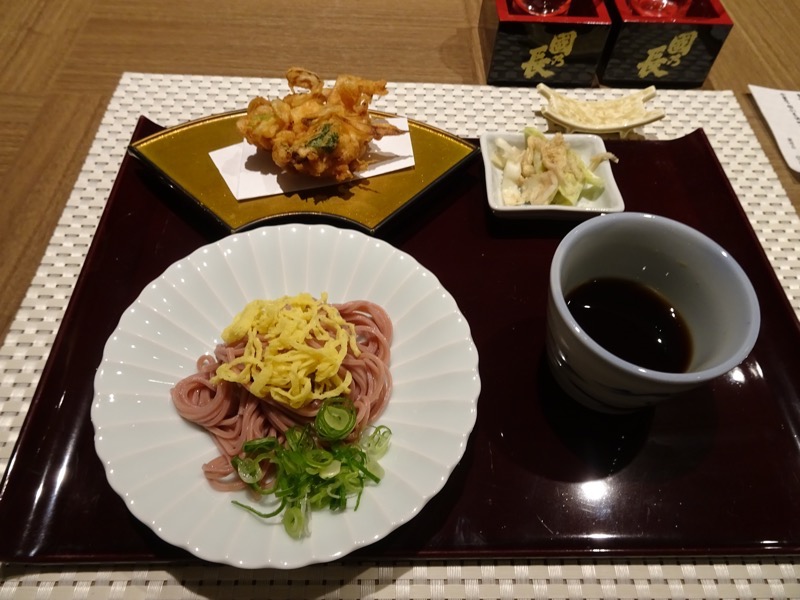 And finally a sake flavoured blancmange, with yuzu jelly and strawberry served with black tea for afters. This is traditional Japanese ‘all evening dining’, where you have roughly the same amount of food you would have in an ordinary meal, but it is continually being brought out in small meticulously presented portions over the course of several hours. The meal was delicious, and even though the courses seemed to just keep coming, we both felt we had an elegant sufficiency.
And finally a sake flavoured blancmange, with yuzu jelly and strawberry served with black tea for afters. This is traditional Japanese ‘all evening dining’, where you have roughly the same amount of food you would have in an ordinary meal, but it is continually being brought out in small meticulously presented portions over the course of several hours. The meal was delicious, and even though the courses seemed to just keep coming, we both felt we had an elegant sufficiency. 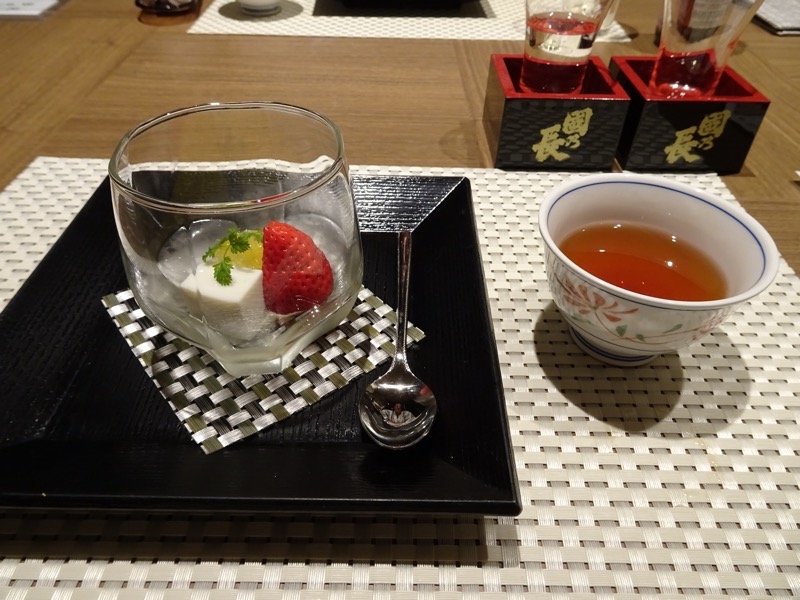
After dinner, we returned to our room to find the hotel staff had transformed our day quarters into a sleeping room. Futons were laid out and we had the hardest pillows you could possibly imagine – they were heavy as, and if I didn’t know better, I’d say they are full of grain as they had the texture of a wheatpack.
 We went for the first of two visits to the private baths – these needed to be booked in advance and cost JPY3000 on top of our room rate, but it was totally worth it. Mr K and I were able to relax in the bath and chat with each other – it’s a totally different experience to using the large sex-segregated onsens and the conditions are just idyllic… right beside the river you can see out across the gorge and listen to the burbling cascades below and hear the occasional birds calls. My only lament is that I found the water a bit too hot for my liking (which is weird because I usually LOVE really hot showers). The website says the water from the natural springs is at around 56-60C, but presumably, have cooled somewhat by the time they reach the baths dependent on ambient temperatures. But it was okay, I just found I kept getting out and dousing myself in cold water Nordic style to cool down so I could hop back in! It’s my Scando/Viking genes I think!
We went for the first of two visits to the private baths – these needed to be booked in advance and cost JPY3000 on top of our room rate, but it was totally worth it. Mr K and I were able to relax in the bath and chat with each other – it’s a totally different experience to using the large sex-segregated onsens and the conditions are just idyllic… right beside the river you can see out across the gorge and listen to the burbling cascades below and hear the occasional birds calls. My only lament is that I found the water a bit too hot for my liking (which is weird because I usually LOVE really hot showers). The website says the water from the natural springs is at around 56-60C, but presumably, have cooled somewhat by the time they reach the baths dependent on ambient temperatures. But it was okay, I just found I kept getting out and dousing myself in cold water Nordic style to cool down so I could hop back in! It’s my Scando/Viking genes I think! 
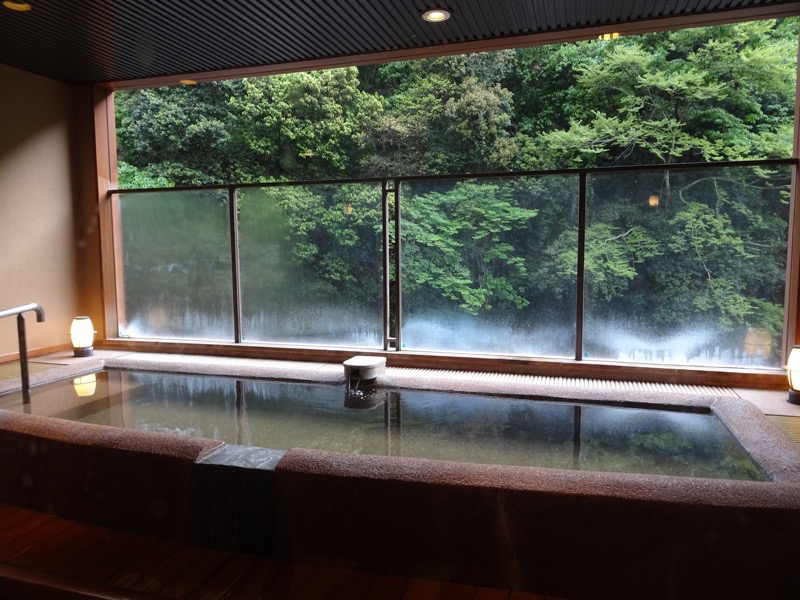
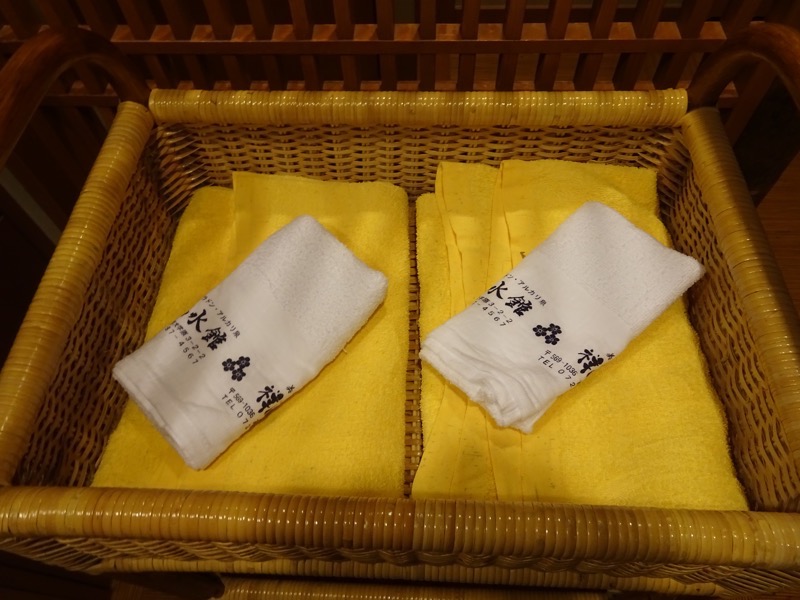 Showering space to get clean and wash your hair etc before hoping in the onsen bath. The round drum looking bucket is for filling up and dumping (cold?) water over yourself.
Showering space to get clean and wash your hair etc before hoping in the onsen bath. The round drum looking bucket is for filling up and dumping (cold?) water over yourself.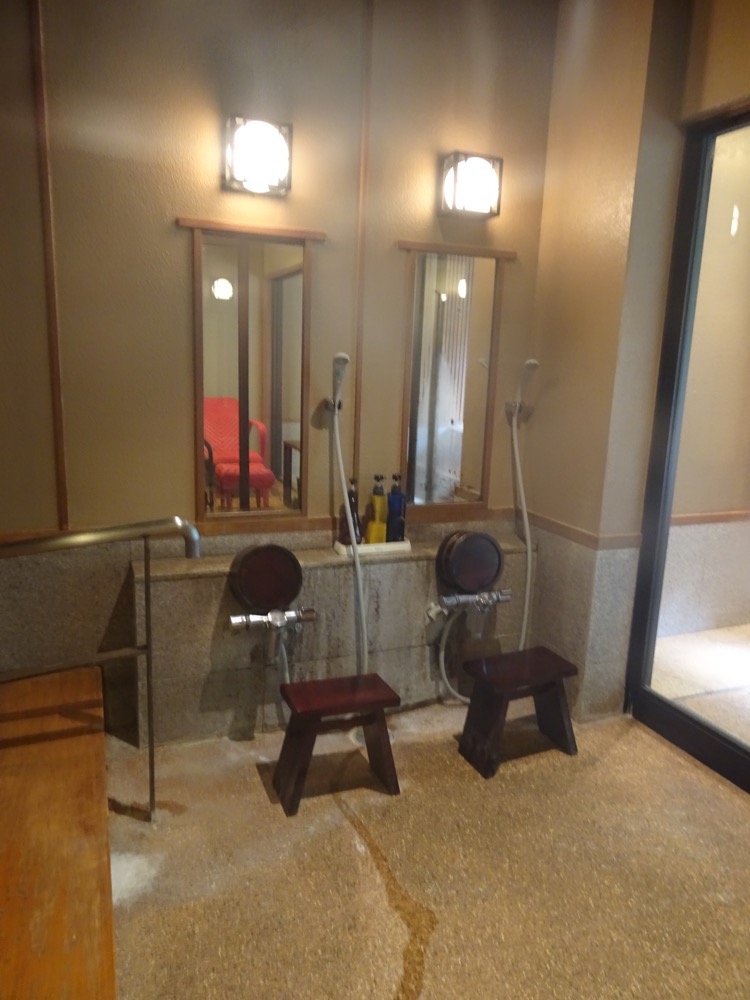 We had a second private bath booked for first thing in the morning and it was lovely and fresh in the open air bath – all the muscle tension just seeped away.
We had a second private bath booked for first thing in the morning and it was lovely and fresh in the open air bath – all the muscle tension just seeped away.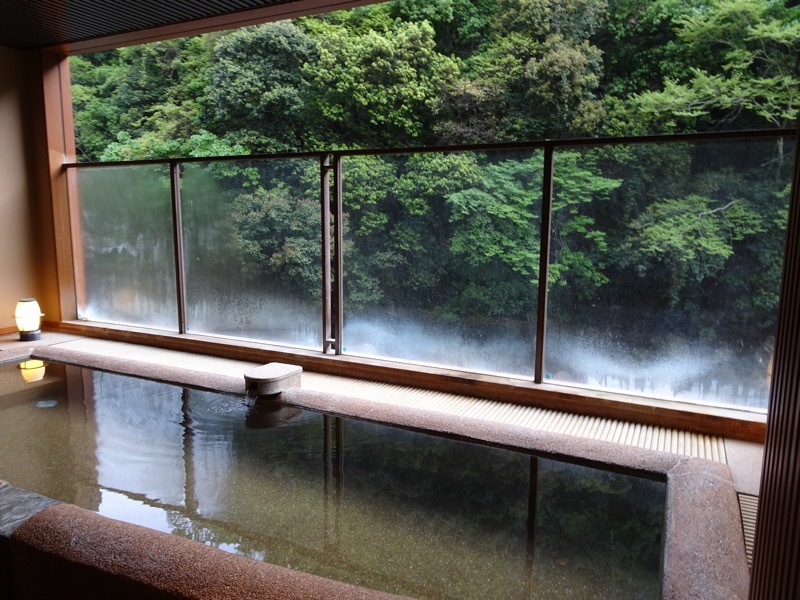 After our morning bath, we dressed and eventually made our way down to breakfast. There was a large buffet with a mixture of Japanese and some western food offerings.
After our morning bath, we dressed and eventually made our way down to breakfast. There was a large buffet with a mixture of Japanese and some western food offerings.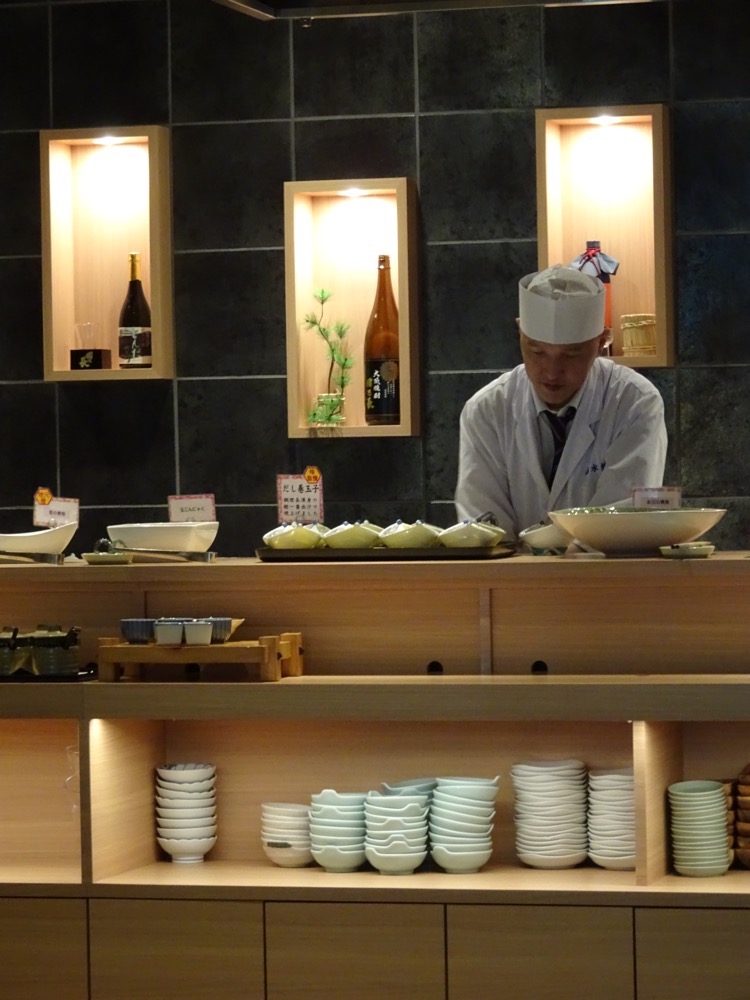
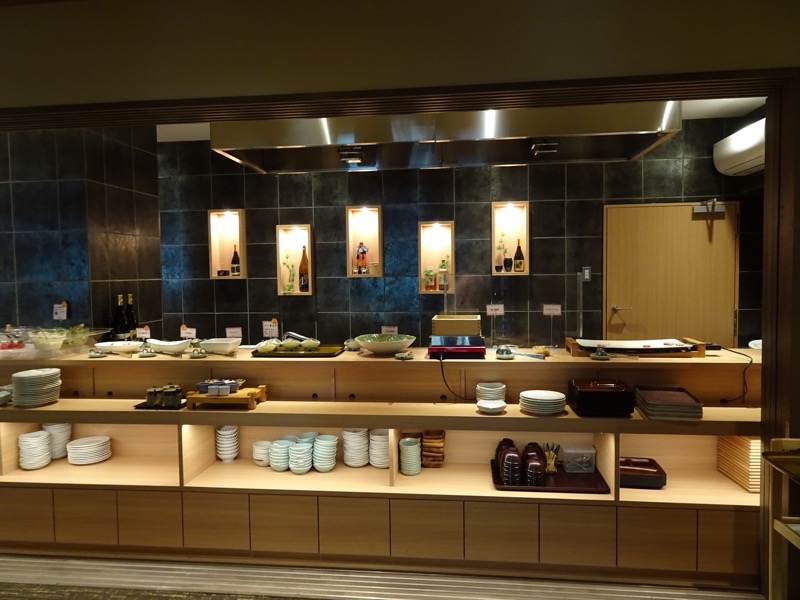
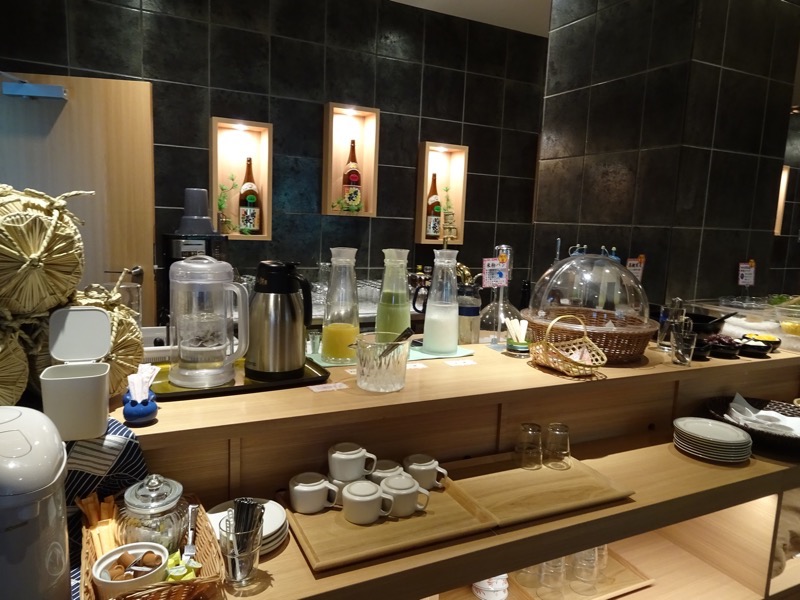 Again our meal was presented in beautiful lacquered boxes and small dishes for each individual little morsel…
Again our meal was presented in beautiful lacquered boxes and small dishes for each individual little morsel…
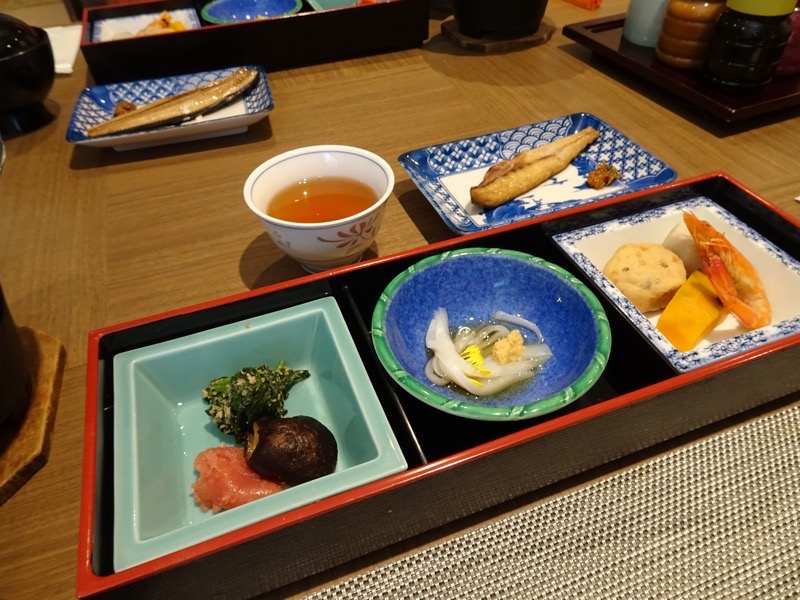 From left to right, fish roe, mushrooms, some baby spinach type leaf thing, marinated squid, boiled tofu, shrimp, yam and something I didn’t recognise, and a serve of black tea and mackerel.
From left to right, fish roe, mushrooms, some baby spinach type leaf thing, marinated squid, boiled tofu, shrimp, yam and something I didn’t recognise, and a serve of black tea and mackerel. On the side was another steamboat with tofu and light vegetables, served with soy and spring onions.
On the side was another steamboat with tofu and light vegetables, served with soy and spring onions.
I have a feeling Japanese fine dining was invented by someone who doesn’t like their food to touch!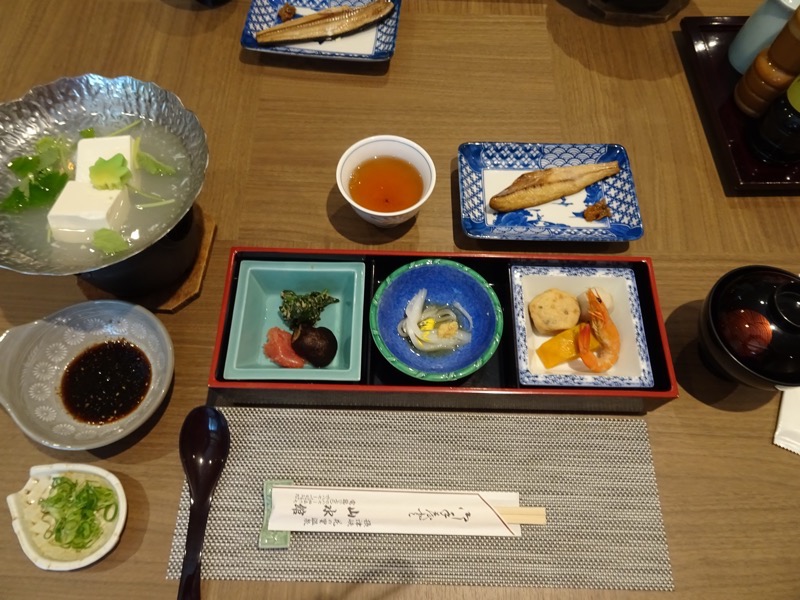
We checked out of the Sansuikan ryokan and went into Takatsuki to check out the Festa 1000 – the Children’s Day Carp Kite Festival that is held each year to encourage the future well being of the city’s children. We discovered Takatsuki has it’s own cute little mascot and lots of carp kites.
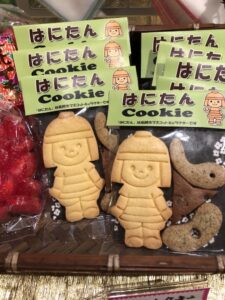


 Then we took the train back to Osaka and we found some green spaces at Osaka Station to kill some time before our flight tonight (not this space though – it was too busy and noisy).
Then we took the train back to Osaka and we found some green spaces at Osaka Station to kill some time before our flight tonight (not this space though – it was too busy and noisy).  Kansai airport was decked out in wisteria which reminds me I need to find the huge wisteria tunnels that Japan is known for – if they’re anywhere near as spectacular as the cherry blossom groves, it will definitely be worth the trains and hassle to go find them next time we are in Japan.
Kansai airport was decked out in wisteria which reminds me I need to find the huge wisteria tunnels that Japan is known for – if they’re anywhere near as spectacular as the cherry blossom groves, it will definitely be worth the trains and hassle to go find them next time we are in Japan. Kansai airport has two Pokemon Store and sooo many restaurants.
Kansai airport has two Pokemon Store and sooo many restaurants.

 Thankfully the lovely people who checked us into our flight let us know there are stuff all restaurants once you go through security, so we stayed outside to have dinner. We ended up having okonomiyaki at a restaurant called Boteju which I’m only recording here because it had the best okonomiyaki we’ve ever had (across three trips to Japan) and it was highly unexpected for an airport restaurant – but then I found out they had been in Osaka since 1945 and have quite the reputation so if I had done my homework I should not have been surprised…
Thankfully the lovely people who checked us into our flight let us know there are stuff all restaurants once you go through security, so we stayed outside to have dinner. We ended up having okonomiyaki at a restaurant called Boteju which I’m only recording here because it had the best okonomiyaki we’ve ever had (across three trips to Japan) and it was highly unexpected for an airport restaurant – but then I found out they had been in Osaka since 1945 and have quite the reputation so if I had done my homework I should not have been surprised… 
 Finally, we were heading home on a blissfully empty plane! Some earplugs and valium and maybe I’ll arrive home in a half decent state. This flight was booked on QFF points, so I am thinking with three seats to myself and the ability to lay down and sleep all night for barely $70 in taxes – this flight probably represents the best value for travel $$$ I have ever spent!
Finally, we were heading home on a blissfully empty plane! Some earplugs and valium and maybe I’ll arrive home in a half decent state. This flight was booked on QFF points, so I am thinking with three seats to myself and the ability to lay down and sleep all night for barely $70 in taxes – this flight probably represents the best value for travel $$$ I have ever spent!

Highlights of this trip were definitely the cherry blossoms at Hirosaki Castle, the Miyako Odori spring dances in Kyoto and the lovely ryokan in Takatsuki – but we have seen so many wonderful things in Japan and enjoy every moment here. I love the people, and the gentle courtesy they extend during everyday transactions, and the accompanying artfulness that is applied to even simple day to day tasks. I also love the culture, art and history, it’s so diverse from Western European culture. And we really love Japanese food culture – the restaurants, noodle bars, street food and izakayas all have a different dining experience to offer and we always enjoy trying new things.
So another amazing trip is over, and with no travel plans on the horizon (#stayhome2019 has gone out the window), I am counting the stamps in my passport and wondering where I’ll end up next?


 The complex is huge, we had to go up about four stories to find our cinema. Mr K is into the popcorn as per usual and we found our seats without any problem – and then the waiting. Watching the ads (all in Japanese), watching the trailers (in a mix of Japanese and English), then the cinema etiquette PSAs (all in Japanese) and then the opening credits of the film… until finally some dialogue and SCORE! It’s in English! Phew!
The complex is huge, we had to go up about four stories to find our cinema. Mr K is into the popcorn as per usual and we found our seats without any problem – and then the waiting. Watching the ads (all in Japanese), watching the trailers (in a mix of Japanese and English), then the cinema etiquette PSAs (all in Japanese) and then the opening credits of the film… until finally some dialogue and SCORE! It’s in English! Phew!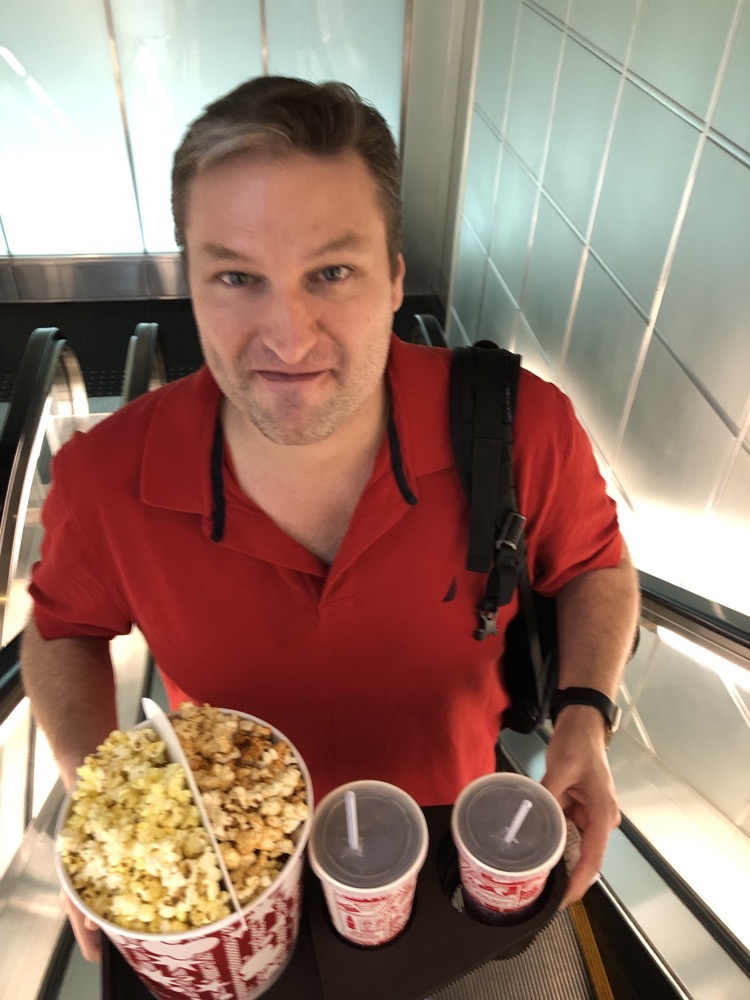 The movie was great fun btw – the story, the world, and the Pokemon were all very cleverly executed. I know a lot of people at home who are looking forward to seeing it and I am sure they won’t’ be disappointed.
The movie was great fun btw – the story, the world, and the Pokemon were all very cleverly executed. I know a lot of people at home who are looking forward to seeing it and I am sure they won’t’ be disappointed. Shopping for chopsticks and sunscreen and kites and find… sake heaven!
Shopping for chopsticks and sunscreen and kites and find… sake heaven!

 The variety of fish was incredible, several types of white fish, shrimps, crayfish, blowfish, shellfish and all sorts. The restaurant smelled like a seaside restaurant from the saltwater tanks and people seemed to be having a lot of fun fishing. I wanted to have some salmon and tuna though, so I didn’t have to fish for those. 🙂
The variety of fish was incredible, several types of white fish, shrimps, crayfish, blowfish, shellfish and all sorts. The restaurant smelled like a seaside restaurant from the saltwater tanks and people seemed to be having a lot of fun fishing. I wanted to have some salmon and tuna though, so I didn’t have to fish for those. 🙂 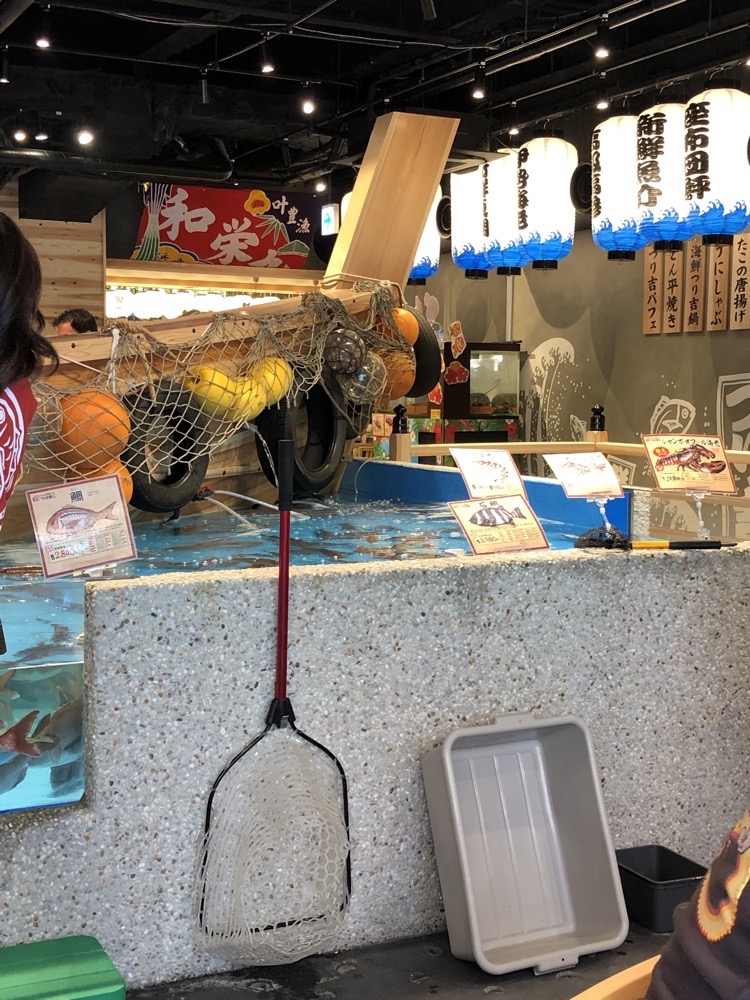
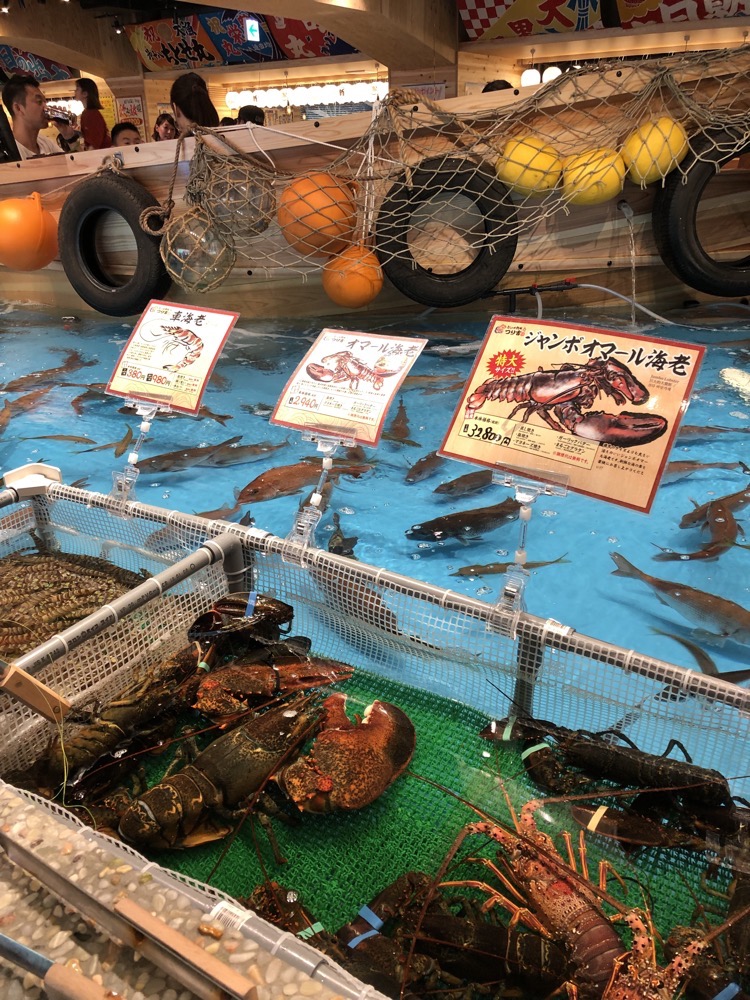

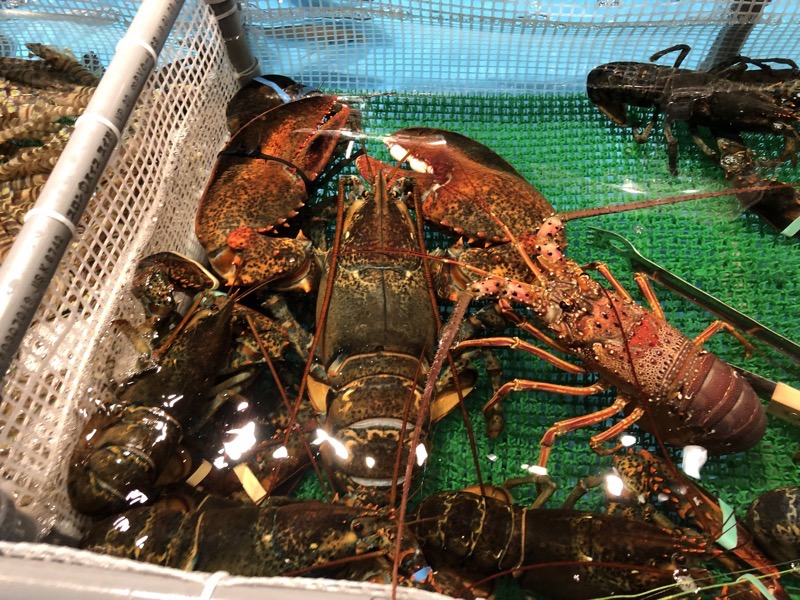
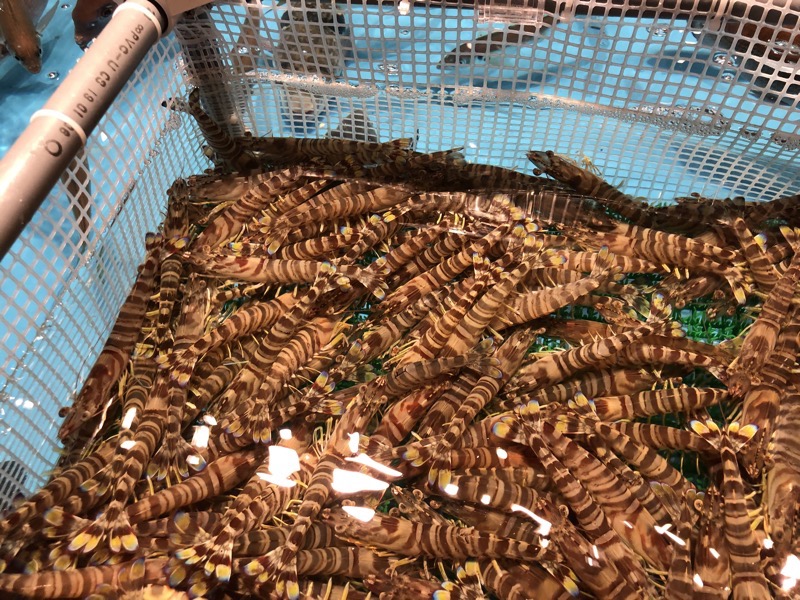
 After you catch your lunch, the sushi chefs will prepare it for you and voila! Fresh to the table.
After you catch your lunch, the sushi chefs will prepare it for you and voila! Fresh to the table.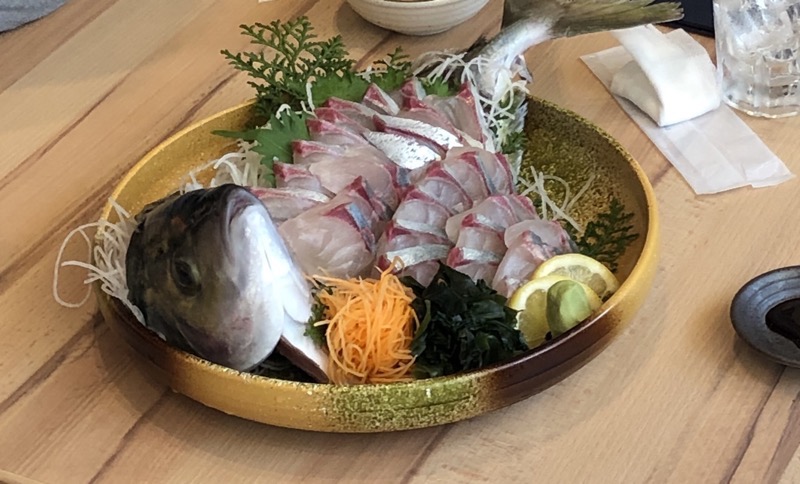
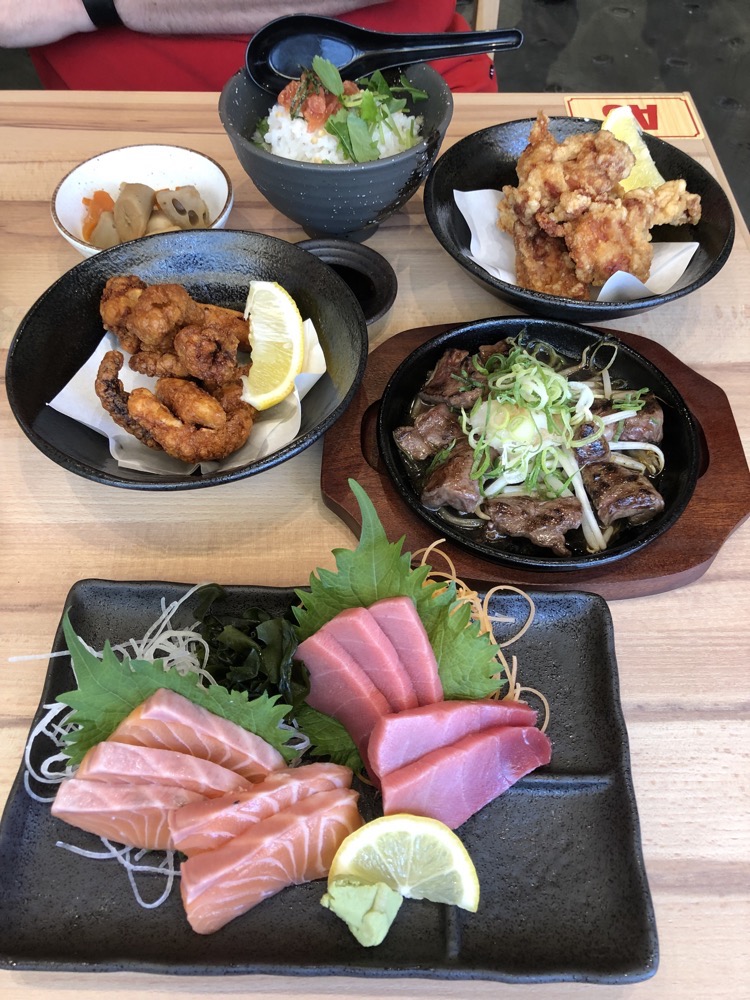 After lunch, we did a bit more shopping. Today we also went to a Kintetsu department store so I could have a bit more of a dig around the kimono and accessories department. This lovely ensemble below is JPY388,800, which is roughly AUD$4,986.00 – and I’m not so sure that includes all the accessories depicted.
After lunch, we did a bit more shopping. Today we also went to a Kintetsu department store so I could have a bit more of a dig around the kimono and accessories department. This lovely ensemble below is JPY388,800, which is roughly AUD$4,986.00 – and I’m not so sure that includes all the accessories depicted.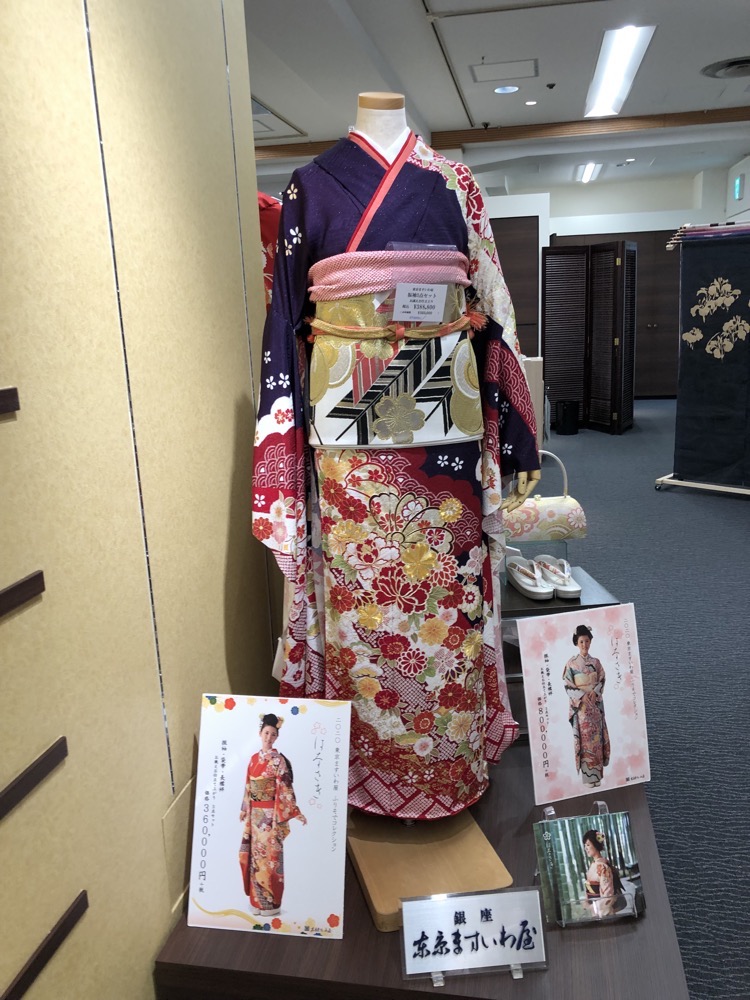
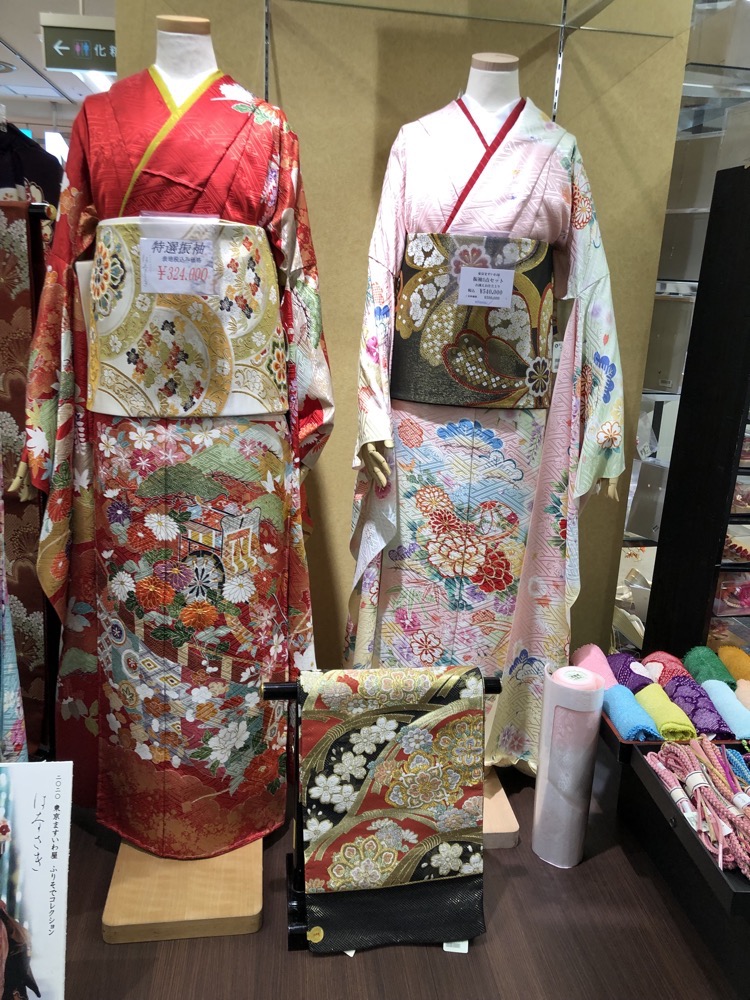 The fabrics are simply gorgeous, and while most of these modern fabrics are no double machine made, I can only imagine how much time and effort went into making elaborate kimono prior to industrialization.
The fabrics are simply gorgeous, and while most of these modern fabrics are no double machine made, I can only imagine how much time and effort went into making elaborate kimono prior to industrialization. I adore the hair ornaments which is what I really came up here to look for – by ‘up here’ I mean the 8th floor of the department store – seems most large department stores have a traditional dress section and it will usually be located in homewares, which will be above the two levels of food hall (one of which is confectionery), followed by cosmetics and perfume, then two floors of ladieswear, one floor of menswear, one of childrenswear and then onto the homewares etc. So if you want to look for these lovely kimono and accessories, you need to keep going up.
I adore the hair ornaments which is what I really came up here to look for – by ‘up here’ I mean the 8th floor of the department store – seems most large department stores have a traditional dress section and it will usually be located in homewares, which will be above the two levels of food hall (one of which is confectionery), followed by cosmetics and perfume, then two floors of ladieswear, one floor of menswear, one of childrenswear and then onto the homewares etc. So if you want to look for these lovely kimono and accessories, you need to keep going up.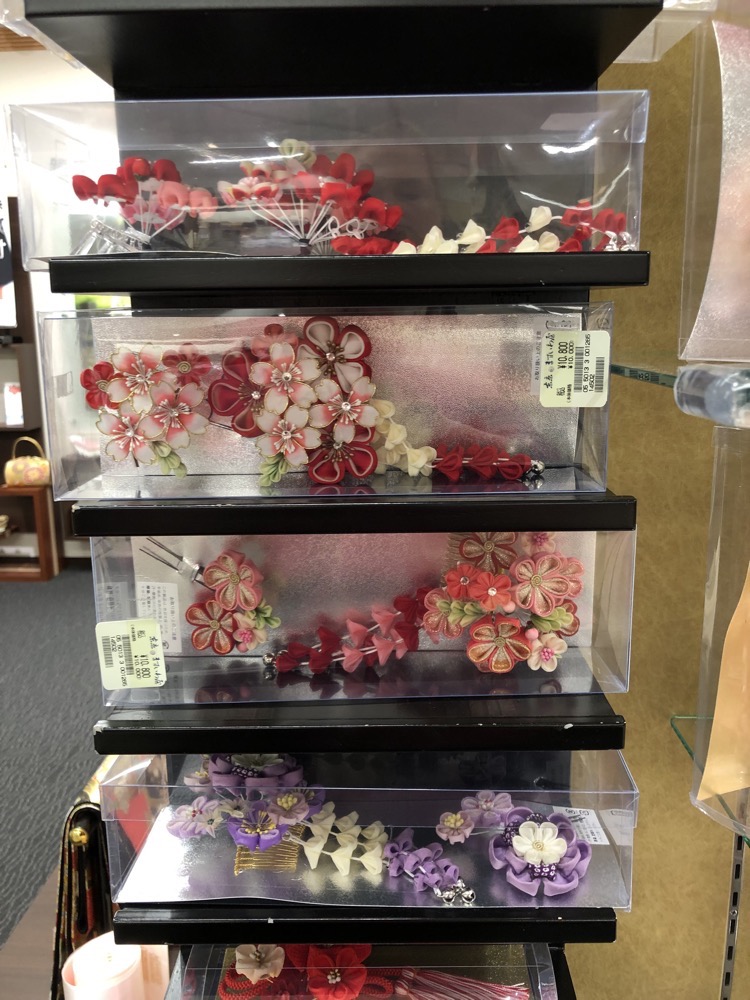
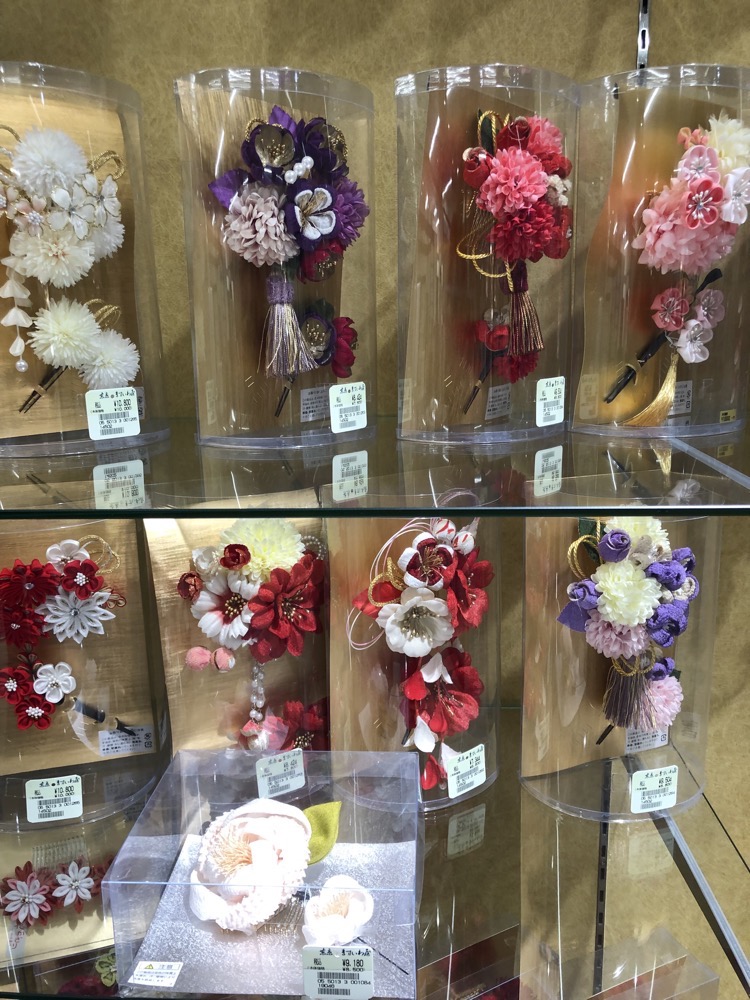
 Mr K about to chow down on his ‘Double Happiness Ramen Noodles’.
Mr K about to chow down on his ‘Double Happiness Ramen Noodles’.

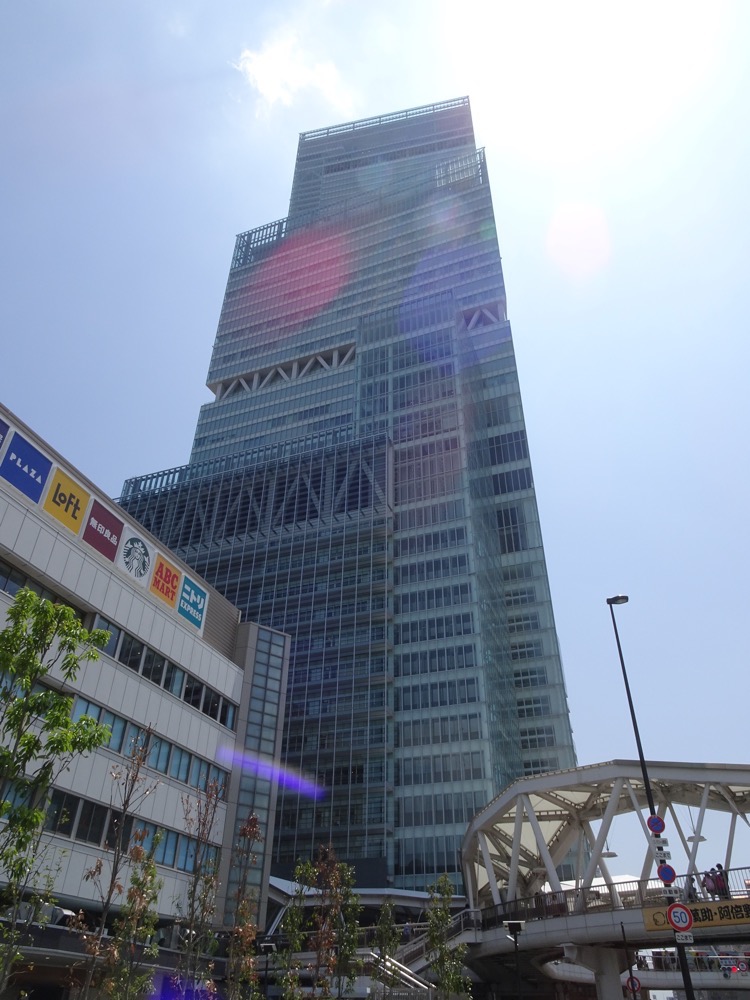
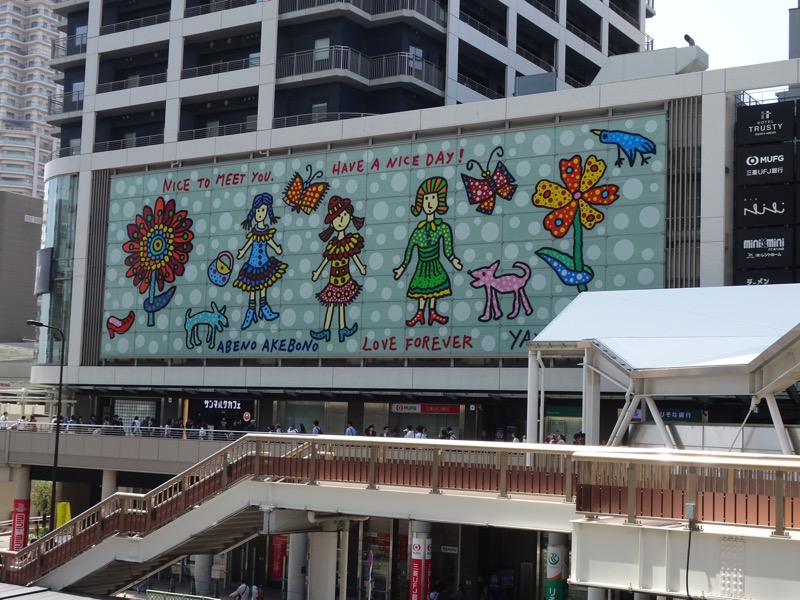 We wandered through the shops and while there is plenty of high-end shopping in this complex (Bvlgari, Louis Vuitton, etc), I particularly love the Kintetsu department stores for their kimono sections. Most upscale department stores will have an area that sells traditional yakuta and kimono and of course all the accessories – obis, ties, geta and zori sandals, Kinchaku Bags, traditional Tsumami Kanzashi hair ornaments, etc. They’re so delicate and have such a very particular design aesthetic.
We wandered through the shops and while there is plenty of high-end shopping in this complex (Bvlgari, Louis Vuitton, etc), I particularly love the Kintetsu department stores for their kimono sections. Most upscale department stores will have an area that sells traditional yakuta and kimono and of course all the accessories – obis, ties, geta and zori sandals, Kinchaku Bags, traditional Tsumami Kanzashi hair ornaments, etc. They’re so delicate and have such a very particular design aesthetic. 
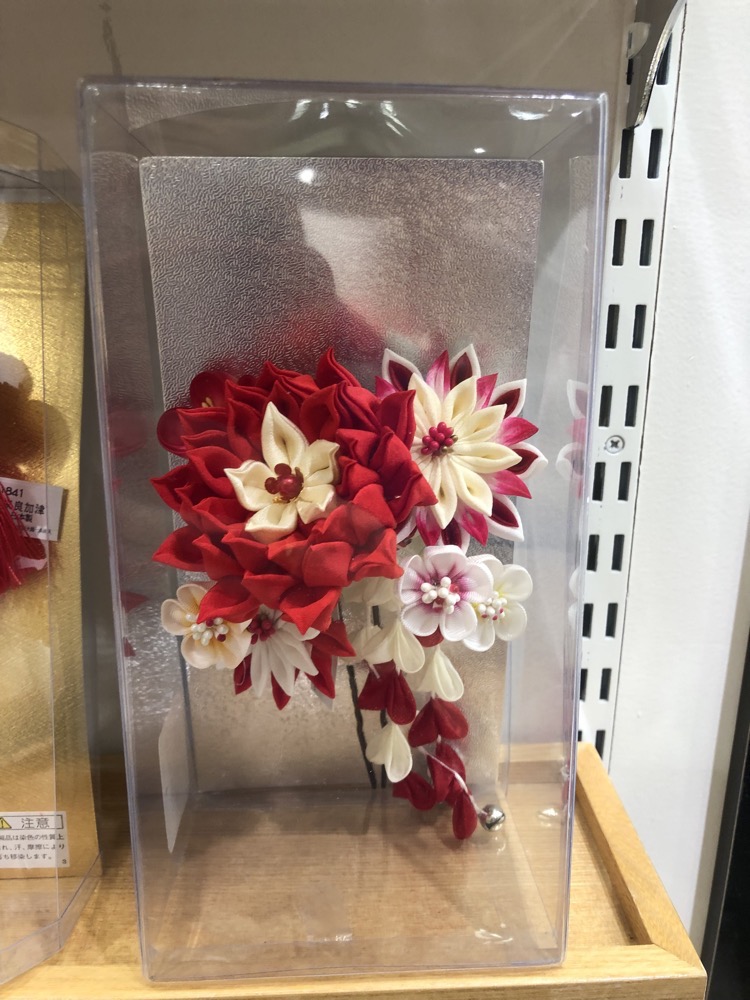

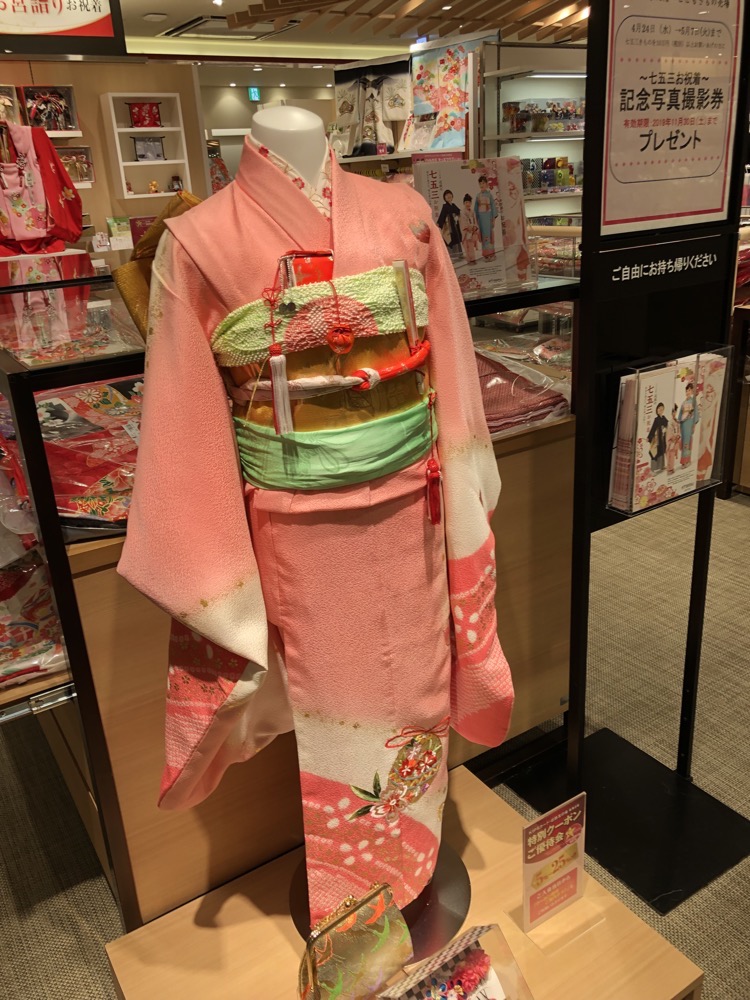
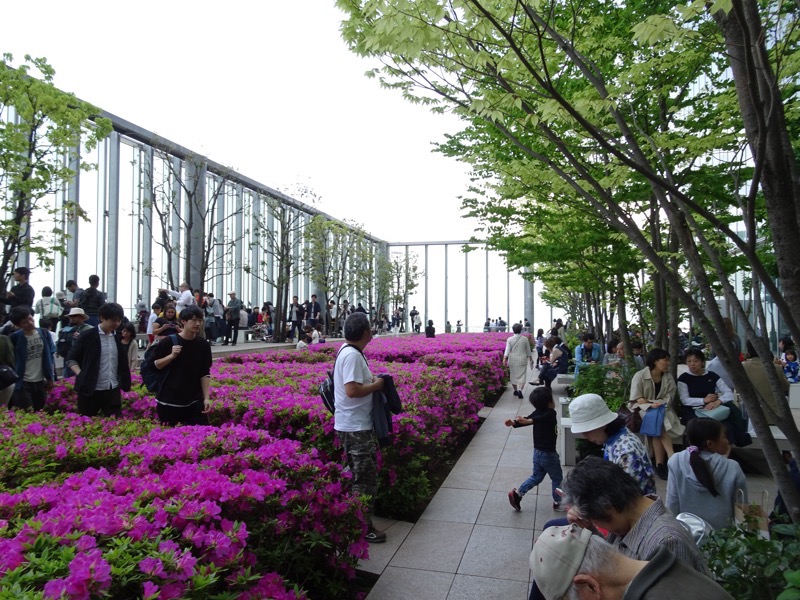 There’s still a long way up in this tower – it’s 70 something stories high, mostly hotel and office space.
There’s still a long way up in this tower – it’s 70 something stories high, mostly hotel and office space. And that there, is some dudes cleaning the windows!
And that there, is some dudes cleaning the windows!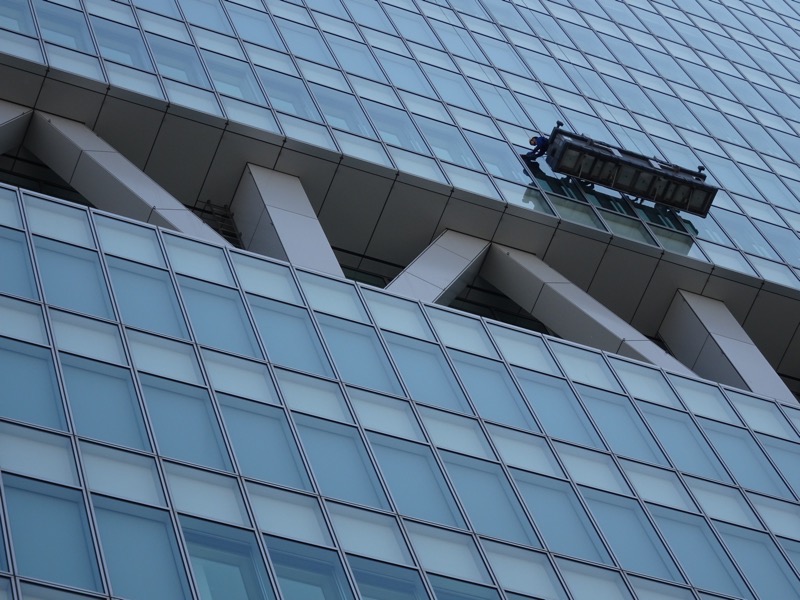
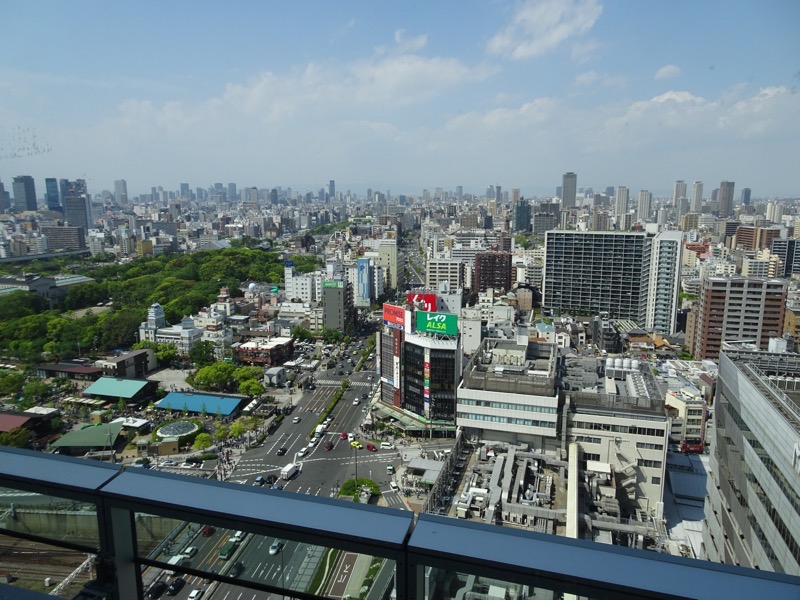
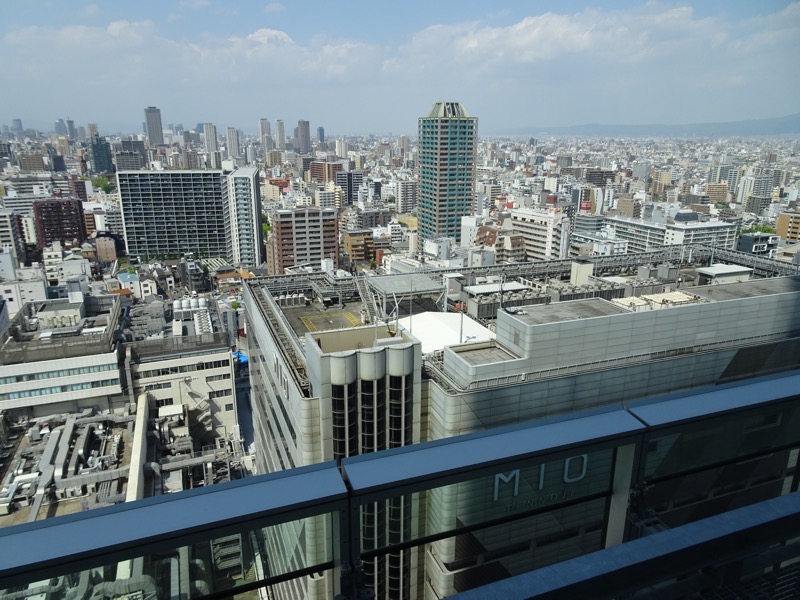
 We toyed with the idea of going all the way to the top of the tower to check it out, but of course, Golden Week strikes again and the place is pretty packed. Between the queue and the JP¥1500 per person to use the elevator (?!?) we decided not to.
We toyed with the idea of going all the way to the top of the tower to check it out, but of course, Golden Week strikes again and the place is pretty packed. Between the queue and the JP¥1500 per person to use the elevator (?!?) we decided not to.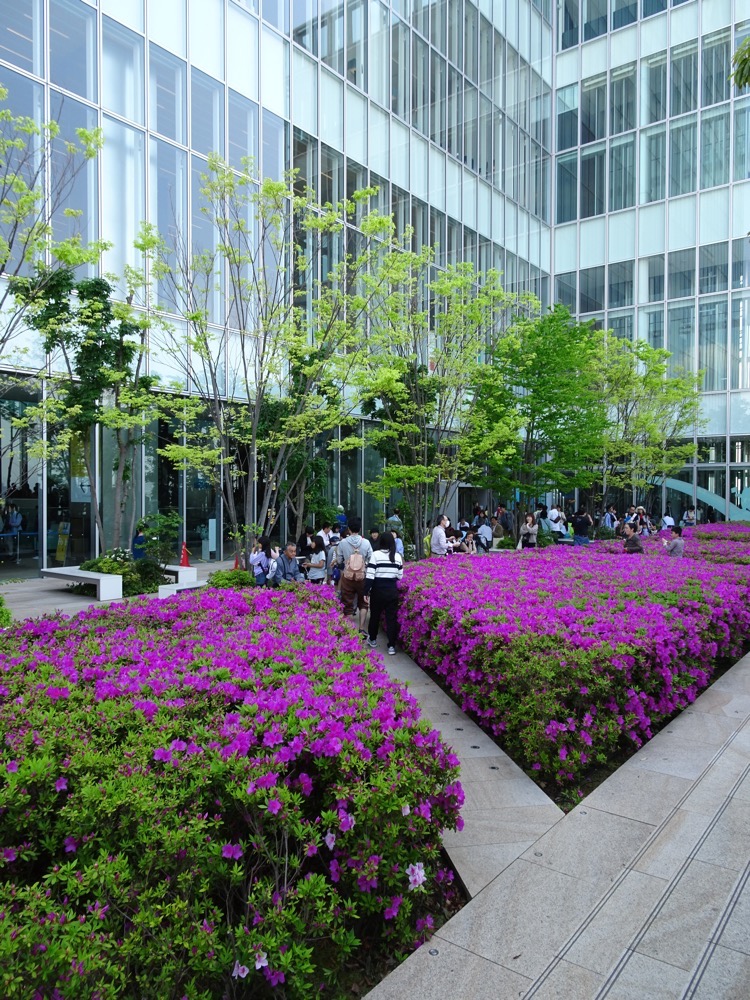
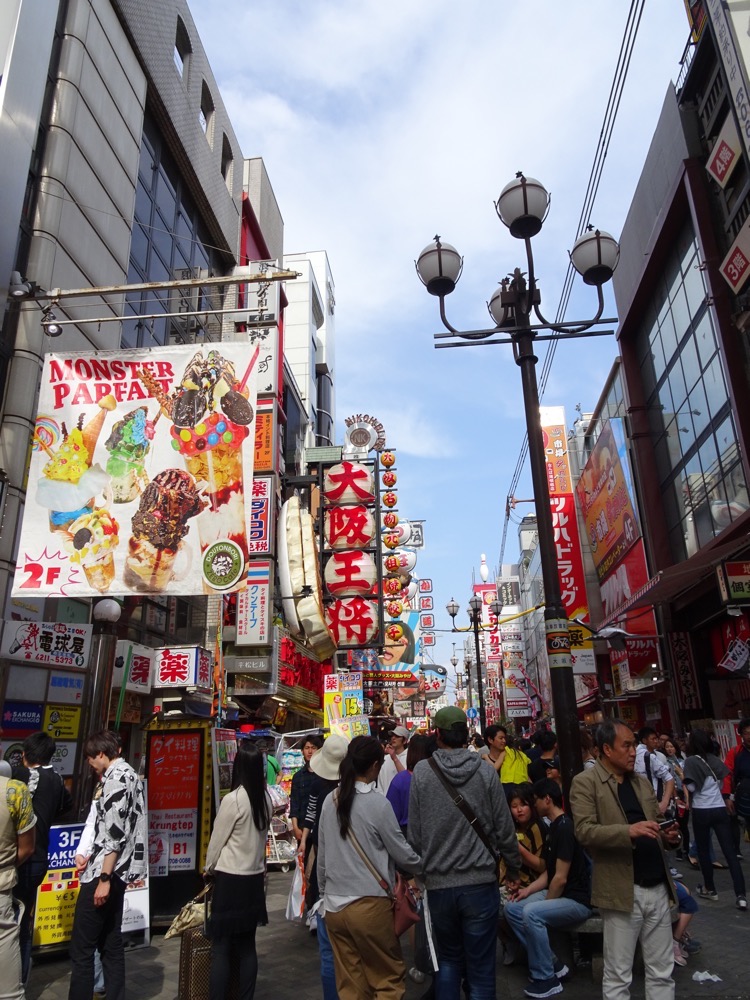
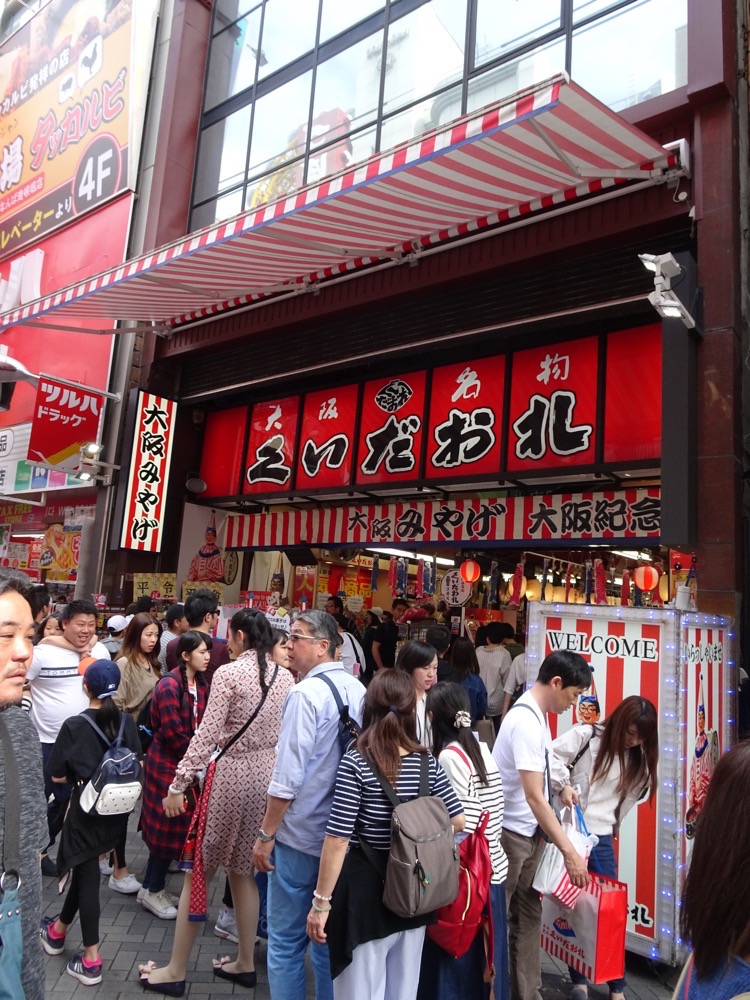 There’s also more than a slight obsession with takoyaki here… stalls of takoyaki everwhere, squid and takoyaki souvenirs all over the place. As a general rule, it is poor etiquette to be eating in public in Japan – seemingly the only ‘proper’ exclusion to that seems to be the standing around takoyaki street vendors eating your little balls of squidly goodness on a toothpick.
There’s also more than a slight obsession with takoyaki here… stalls of takoyaki everwhere, squid and takoyaki souvenirs all over the place. As a general rule, it is poor etiquette to be eating in public in Japan – seemingly the only ‘proper’ exclusion to that seems to be the standing around takoyaki street vendors eating your little balls of squidly goodness on a toothpick. 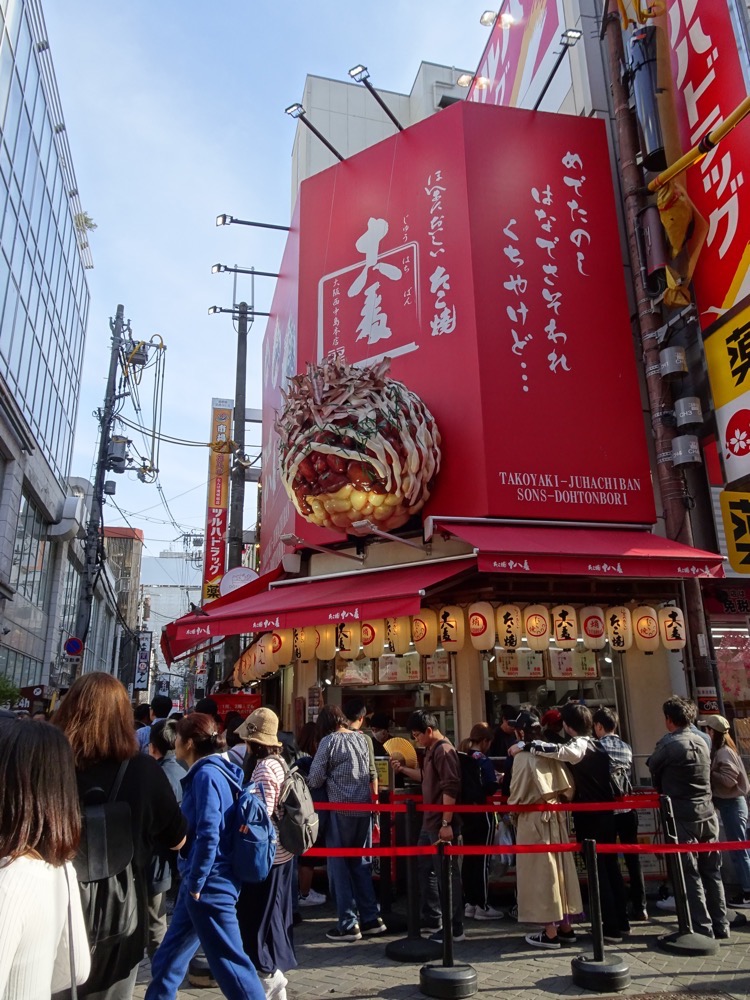
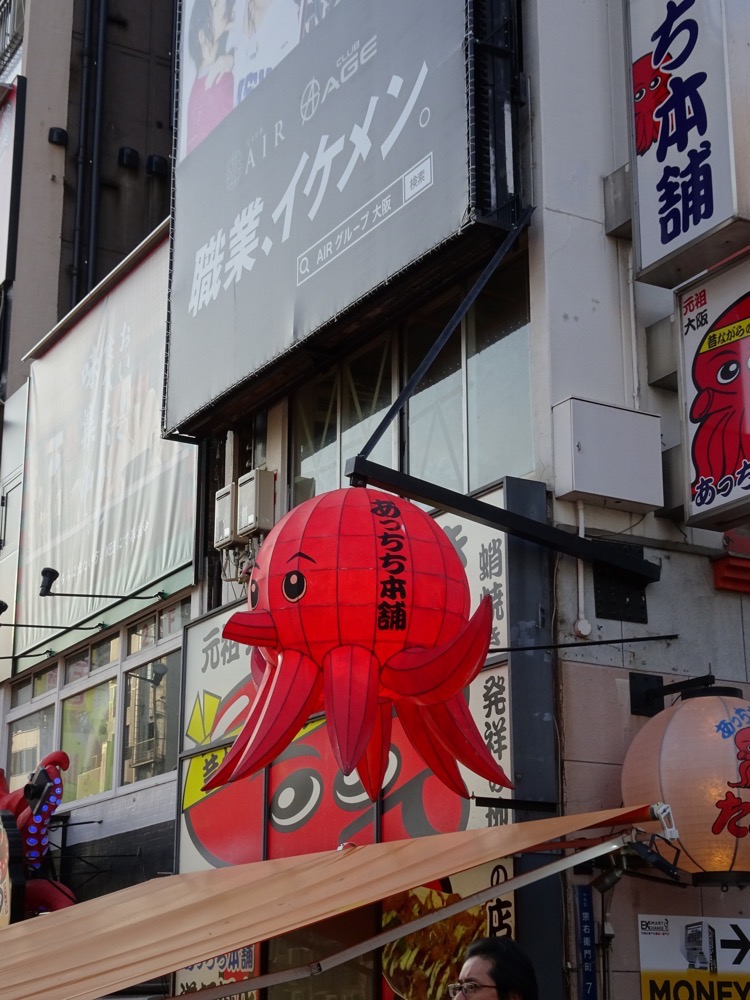
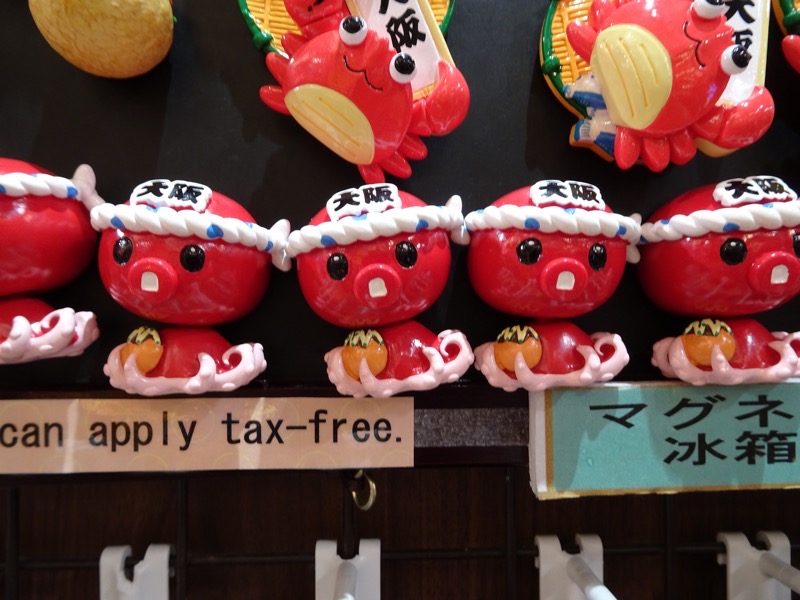 The narrow alleyways of shops and restaurants go off in every direction for miles.
The narrow alleyways of shops and restaurants go off in every direction for miles. 
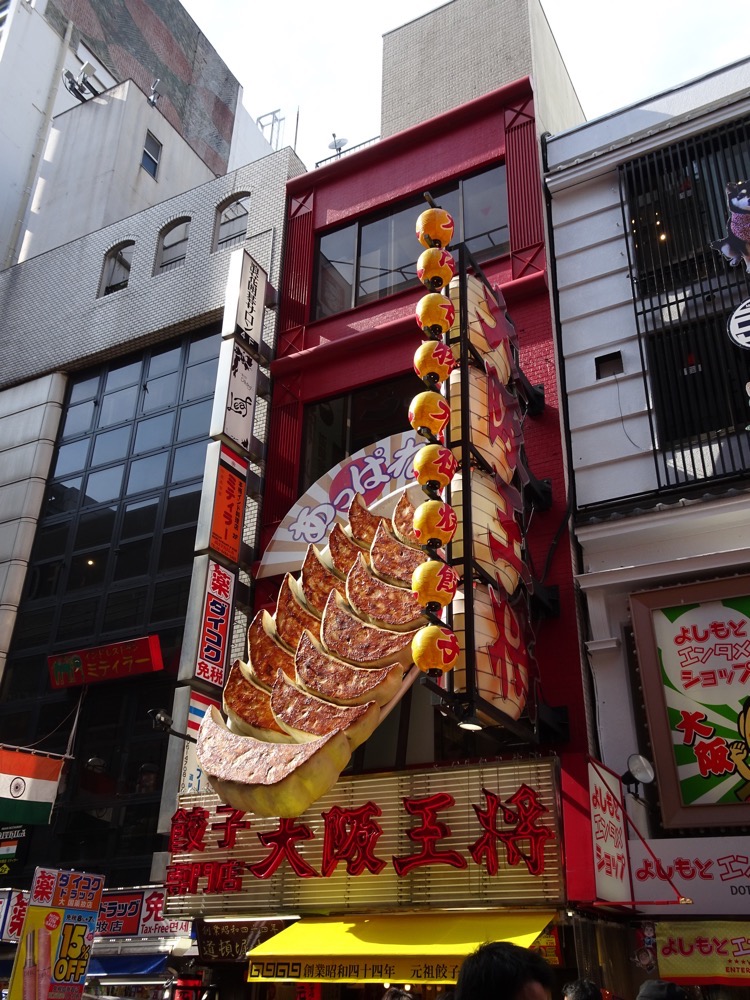
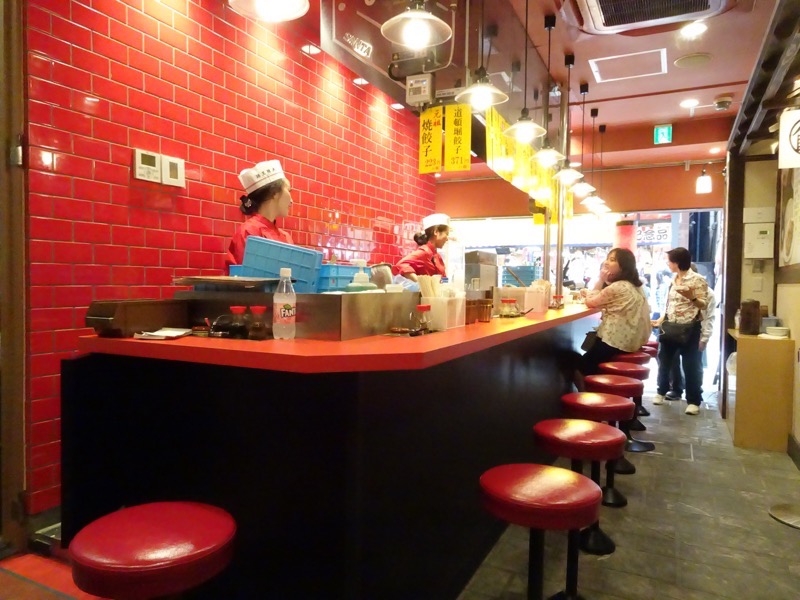 I can’t imagine how many thousands of gyoza these ladies made today… the place was filled to the brim and it was about 3pm.
I can’t imagine how many thousands of gyoza these ladies made today… the place was filled to the brim and it was about 3pm.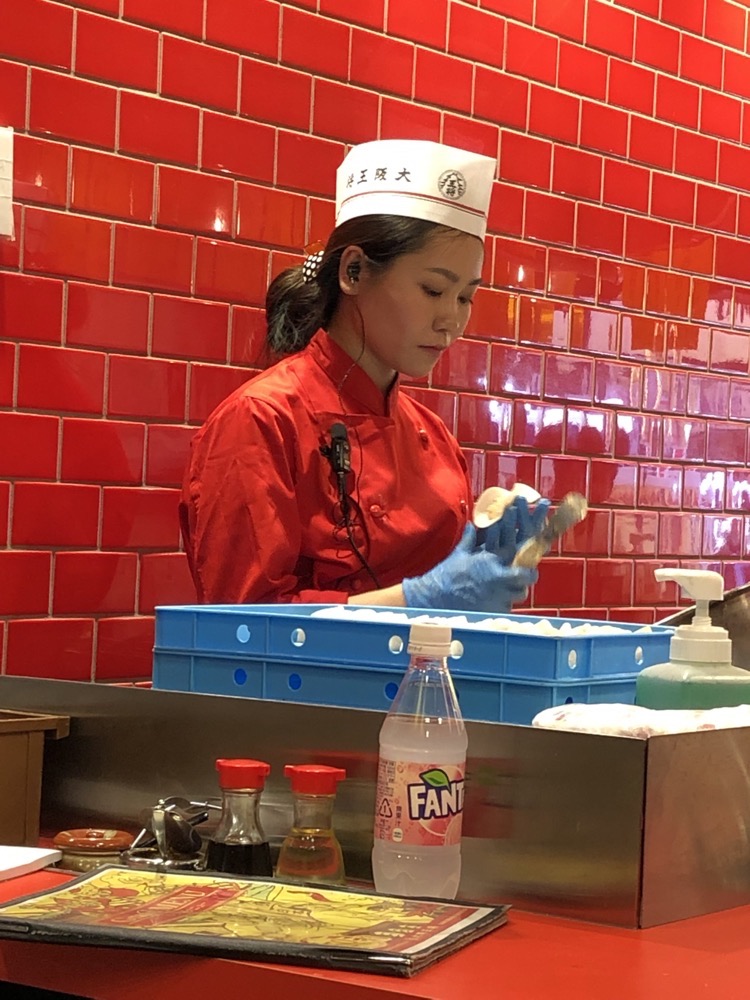
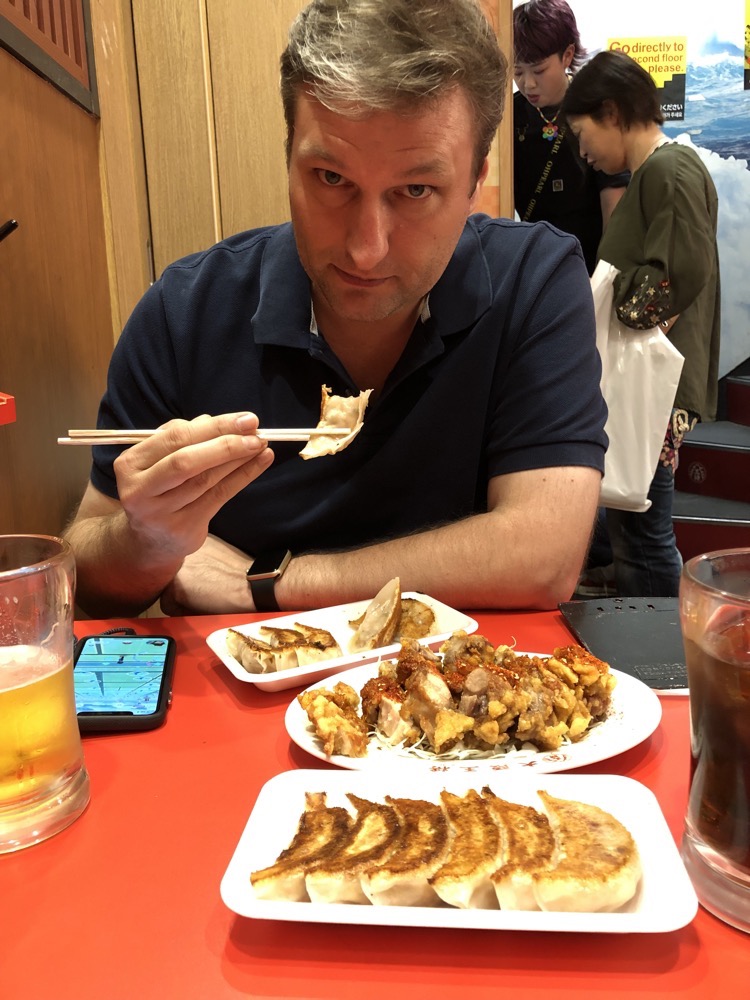 After the gyoza cravings had been quelled, we continued to wander the streets of Dontonburi, checking out the shops, looking in particular for liquor stores (how unlike us?!) and hunting for cool One Piece gifts to take home for #1 Son.
After the gyoza cravings had been quelled, we continued to wander the streets of Dontonburi, checking out the shops, looking in particular for liquor stores (how unlike us?!) and hunting for cool One Piece gifts to take home for #1 Son.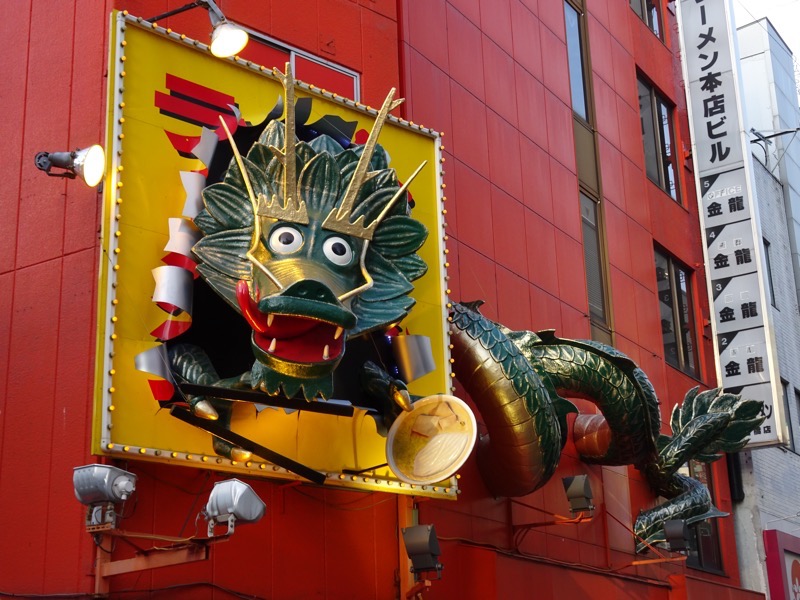 There seems to be no such thing as ‘overkill’ when it comes to creating signage for your shop or restaurant around here… there’s a definite, ‘more and bigger is better’ feel to all the street signage.
There seems to be no such thing as ‘overkill’ when it comes to creating signage for your shop or restaurant around here… there’s a definite, ‘more and bigger is better’ feel to all the street signage.

 After a couple more hours of wandering around, I was keen to find a bar and chill out until the sun went down. Managed to find a cute little izakaya bar tucked away down a small alleyway that had a cheap and cheerful menu and we got ourselves some sake, beer and a sashimi snack. The izakaya bars are similar to tapas bars in Spain – informal, people tend to order small amounts of food and drink, and then just keep ordering bits and pieces for as long as you want to stay there.
After a couple more hours of wandering around, I was keen to find a bar and chill out until the sun went down. Managed to find a cute little izakaya bar tucked away down a small alleyway that had a cheap and cheerful menu and we got ourselves some sake, beer and a sashimi snack. The izakaya bars are similar to tapas bars in Spain – informal, people tend to order small amounts of food and drink, and then just keep ordering bits and pieces for as long as you want to stay there.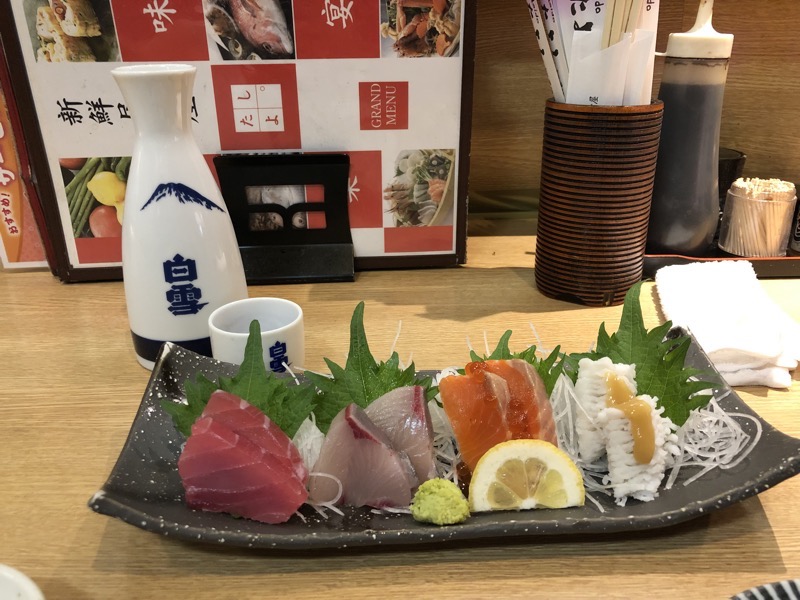
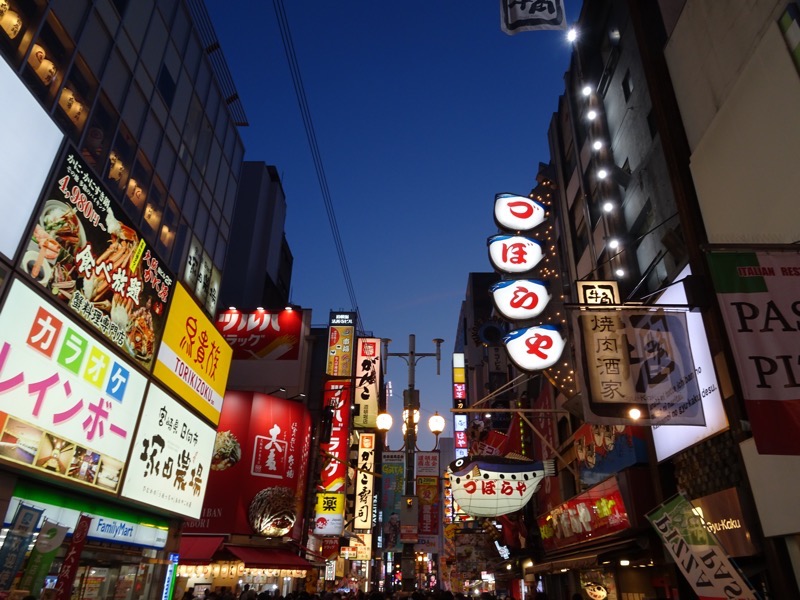
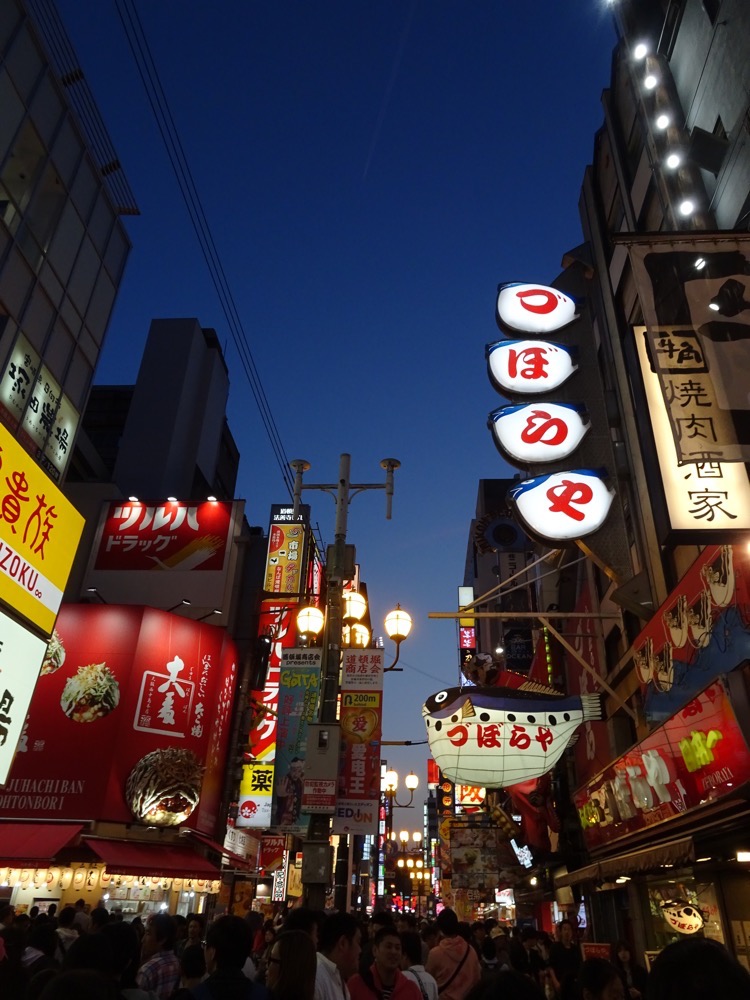
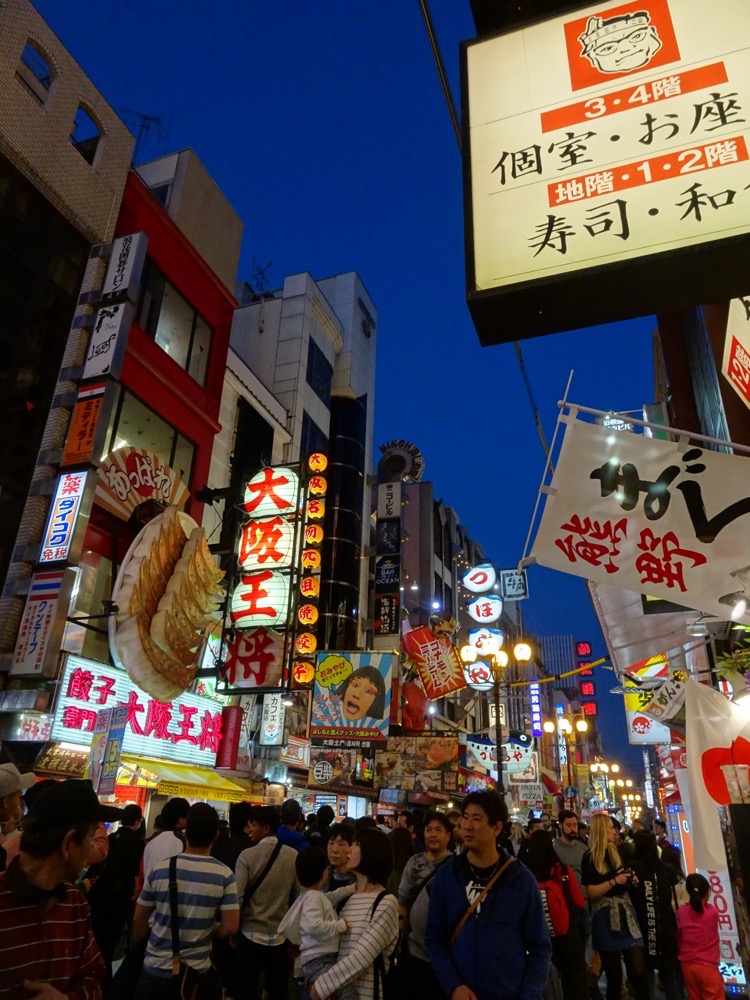 The canals look very cool all lit up at night.
The canals look very cool all lit up at night.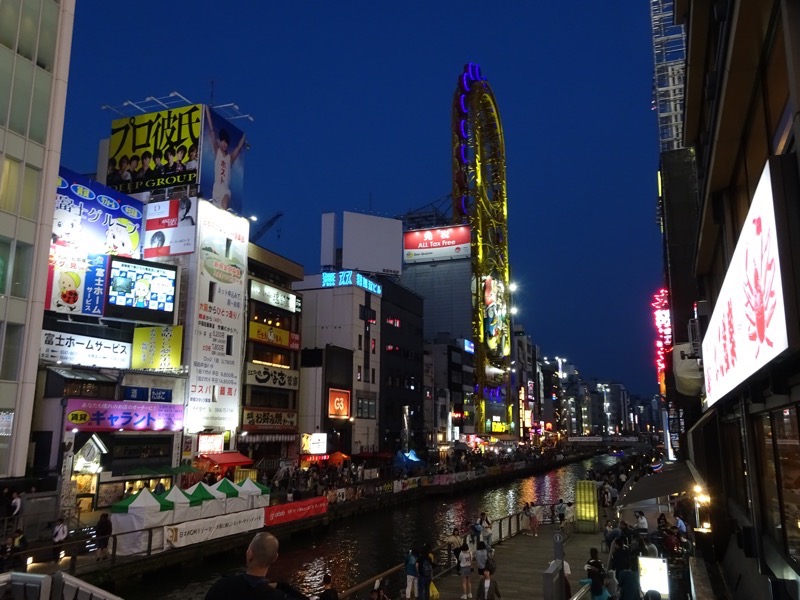 And the rabbit warren of little alleyway bars feels like something out of a movie.
And the rabbit warren of little alleyway bars feels like something out of a movie. 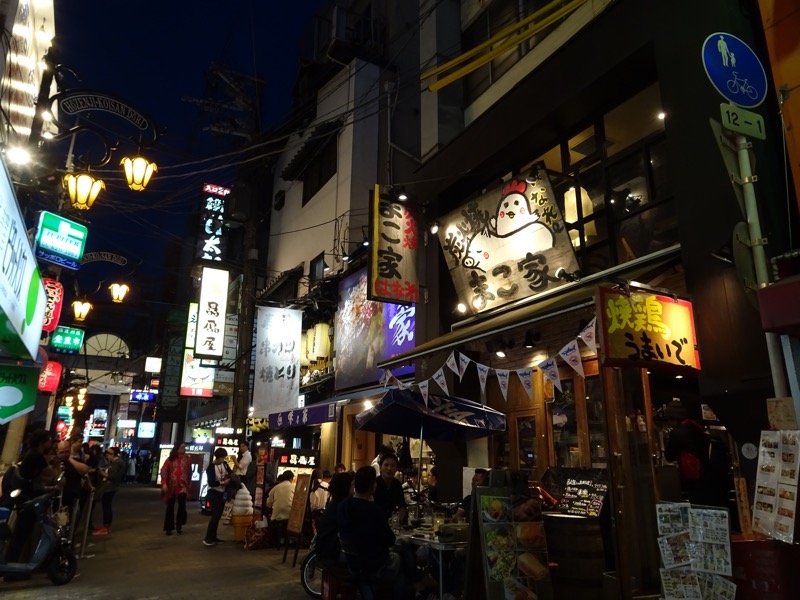 All up we had a pretty chill day which was much needed. We were back at the hotel at a reasonable hour in time for another soak and some more sake in the hot tub… which is starting to feel like a habit at this point!
All up we had a pretty chill day which was much needed. We were back at the hotel at a reasonable hour in time for another soak and some more sake in the hot tub… which is starting to feel like a habit at this point!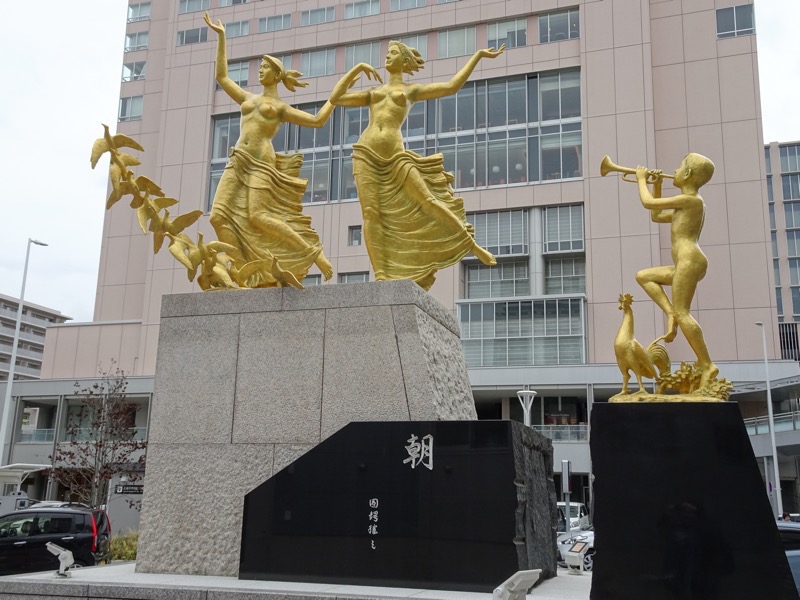 Our first stop was to Hiroshima Castle…
Our first stop was to Hiroshima Castle…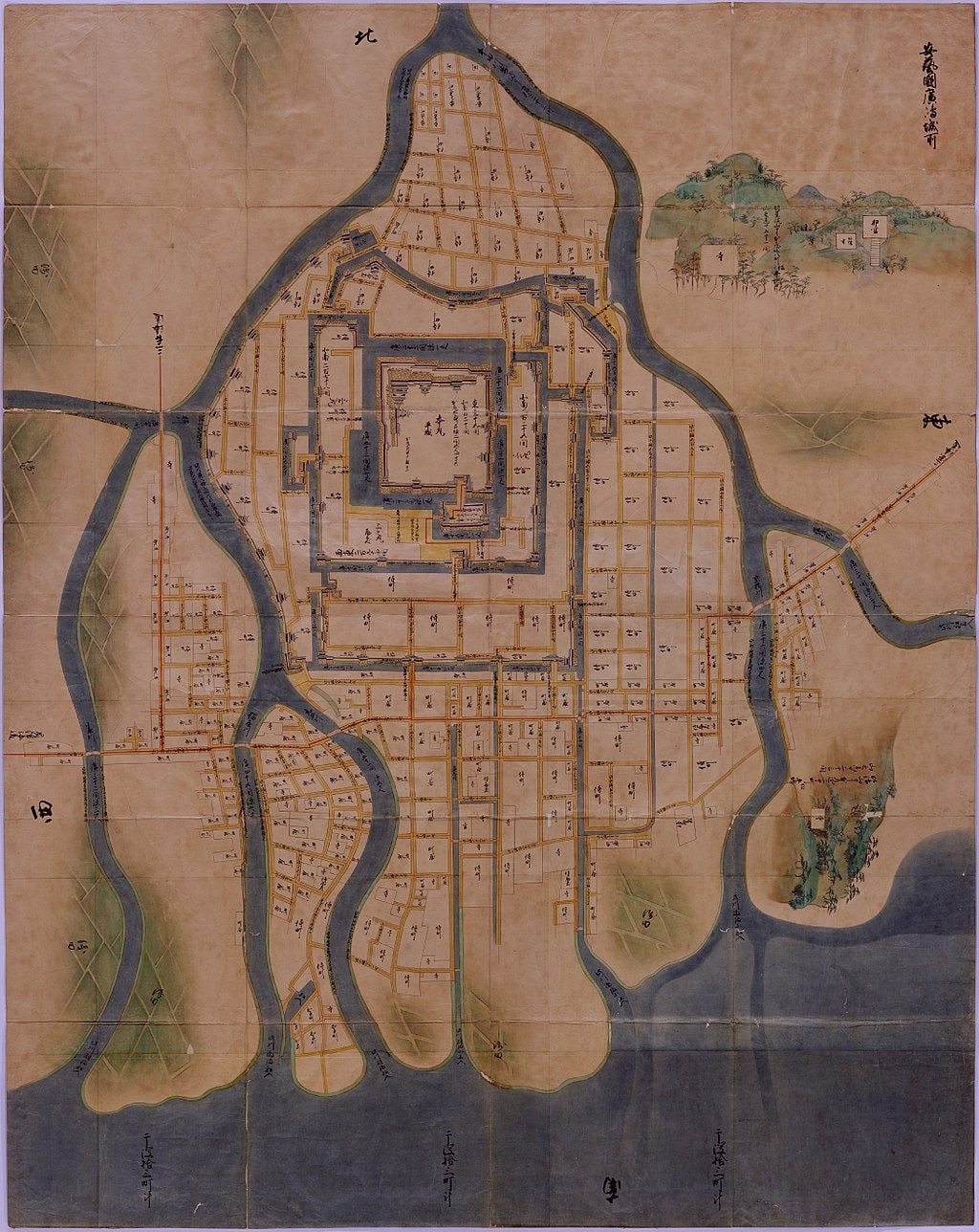
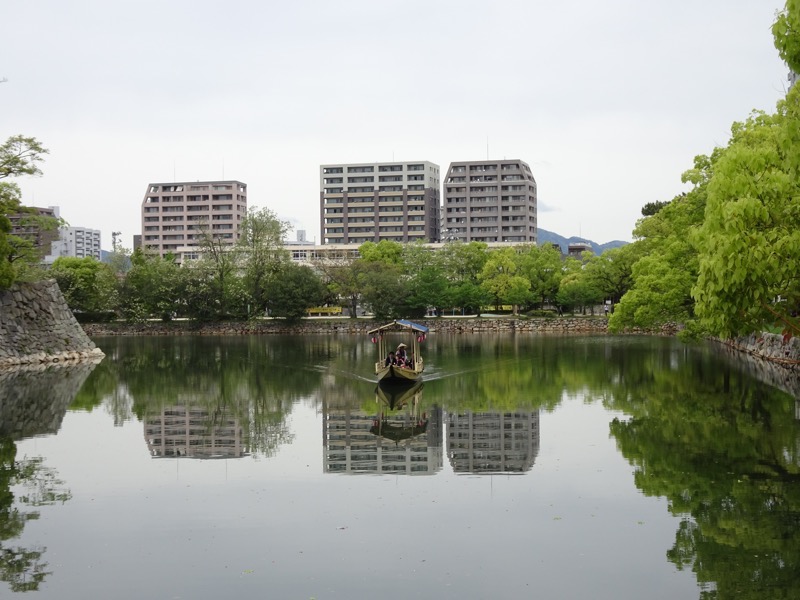

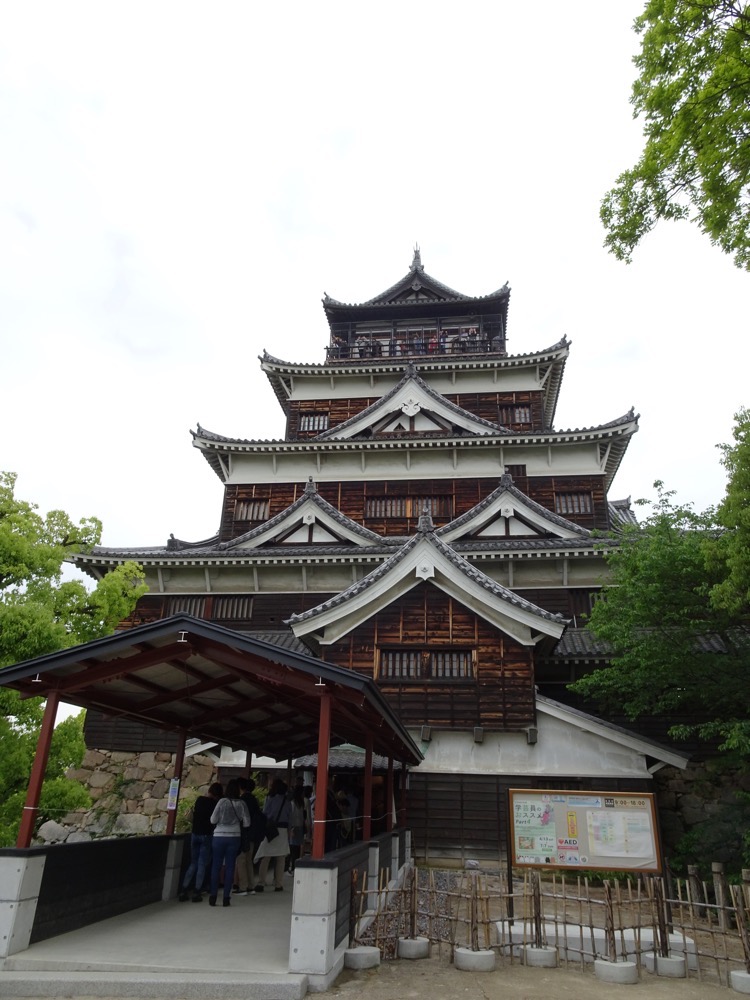
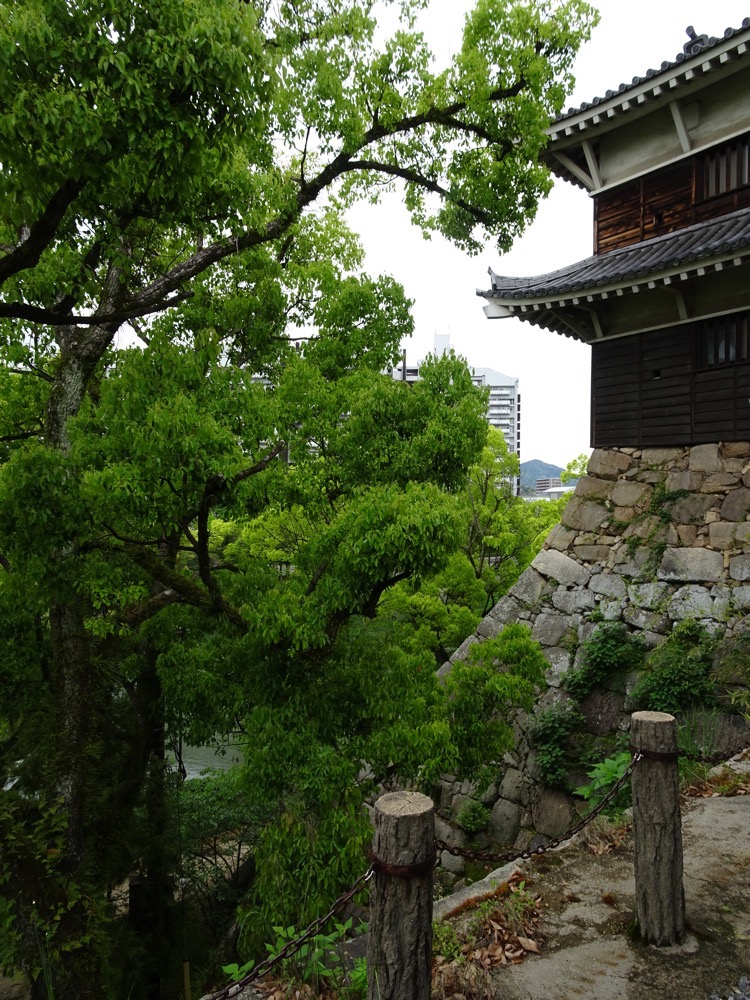 The Castle houses an extensive collection of pre-Reformation era displays – swords, armour, household objects and historical items, however, photography is prohibited and there is no English guidebooks, so I can not share most of what we saw inside.
The Castle houses an extensive collection of pre-Reformation era displays – swords, armour, household objects and historical items, however, photography is prohibited and there is no English guidebooks, so I can not share most of what we saw inside.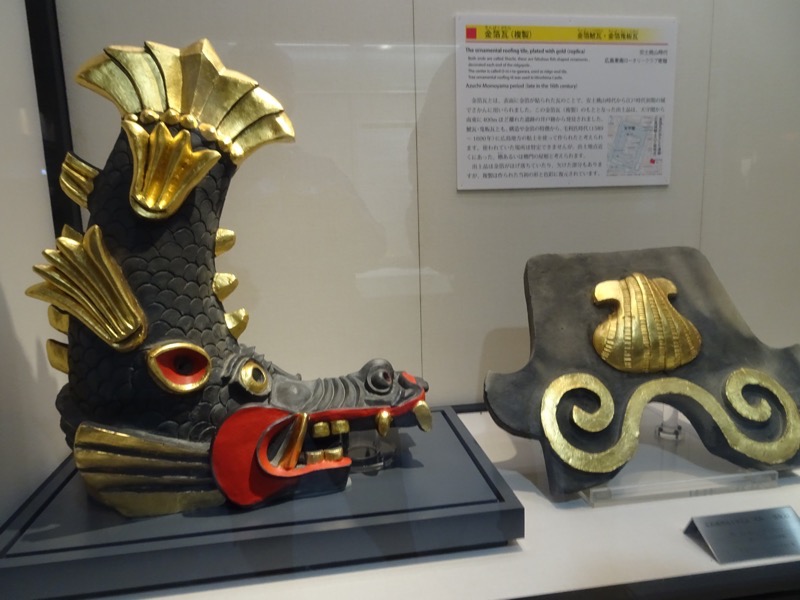
 Some reconstructed rooms as they would have been in the late 1500s when the Mōri family ruled the castle.
Some reconstructed rooms as they would have been in the late 1500s when the Mōri family ruled the castle.
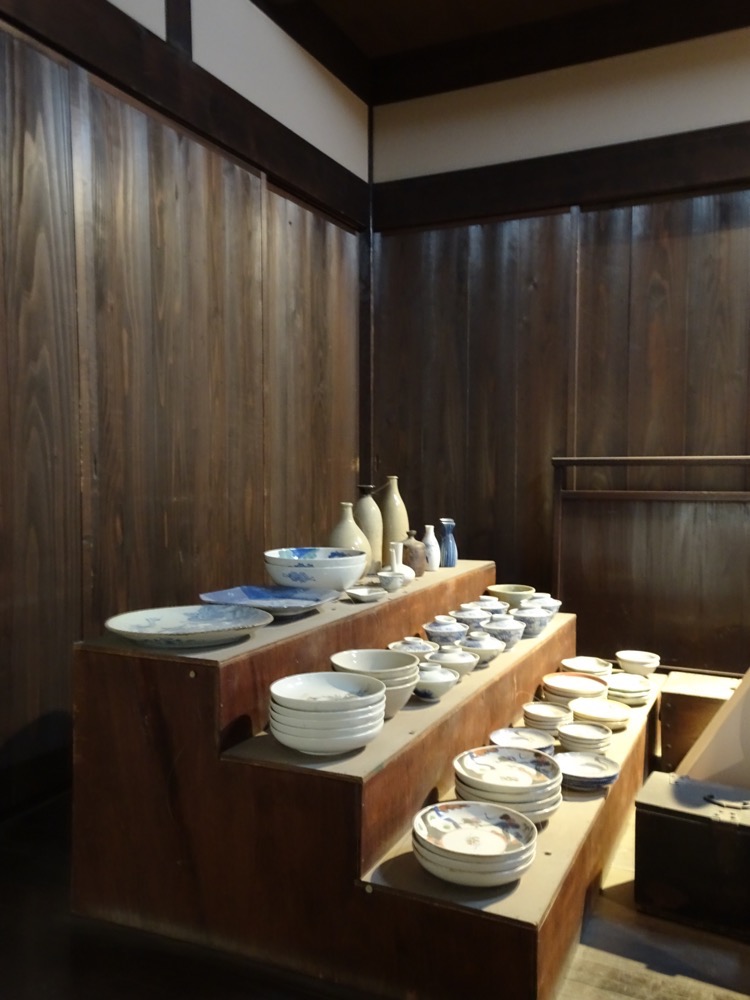
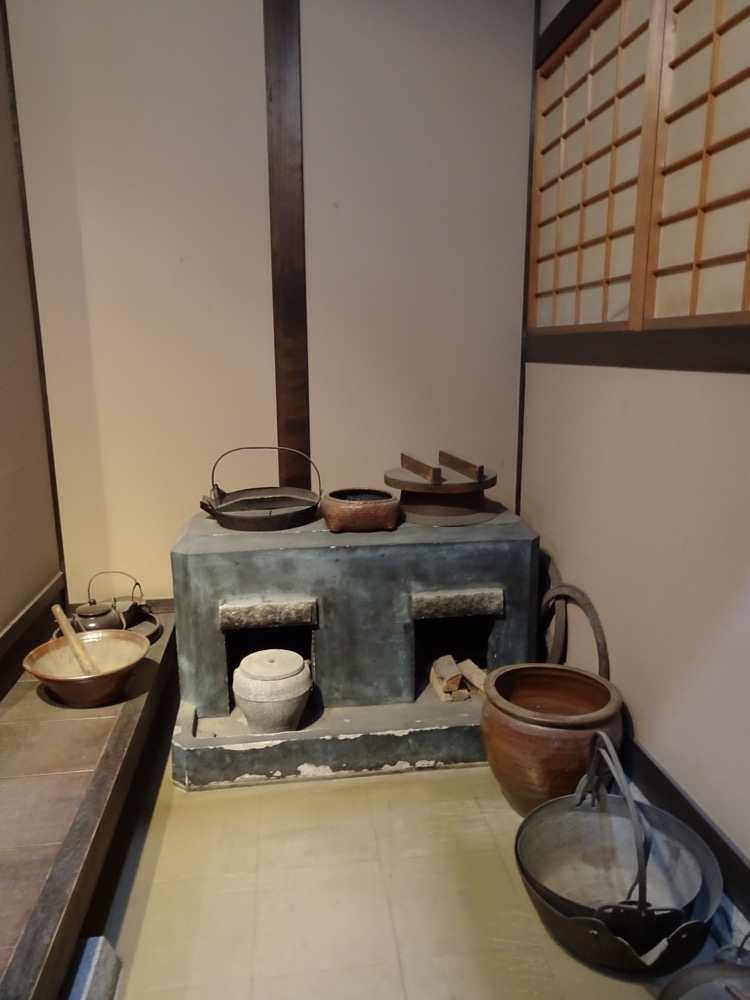 The views from the top of the castle are quite impressive – you can imagine how the advantage gained as the countryside was largely flat.
The views from the top of the castle are quite impressive – you can imagine how the advantage gained as the countryside was largely flat. 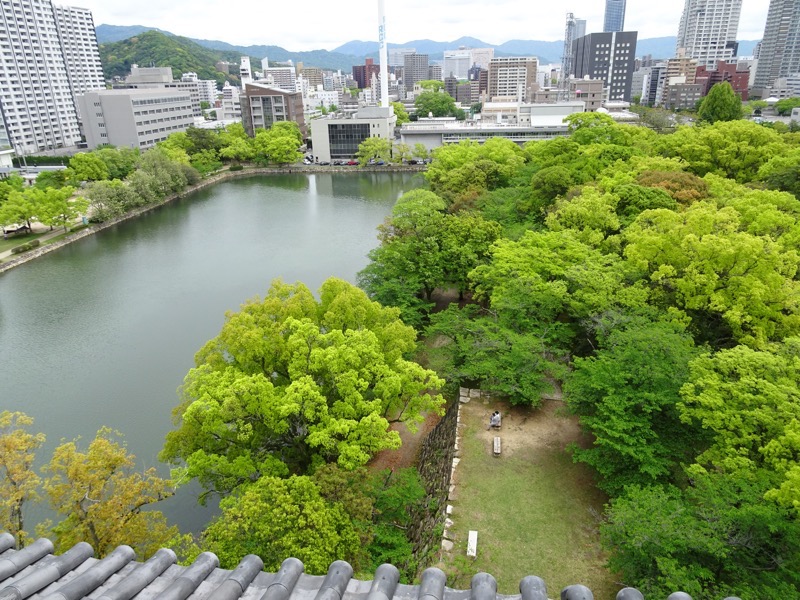
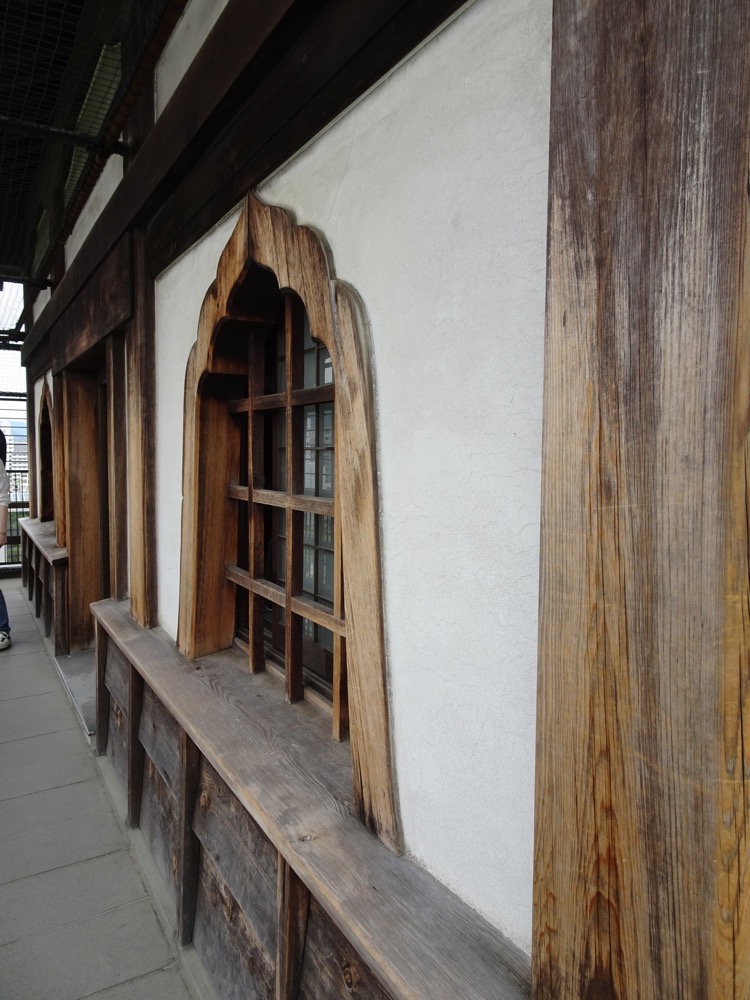

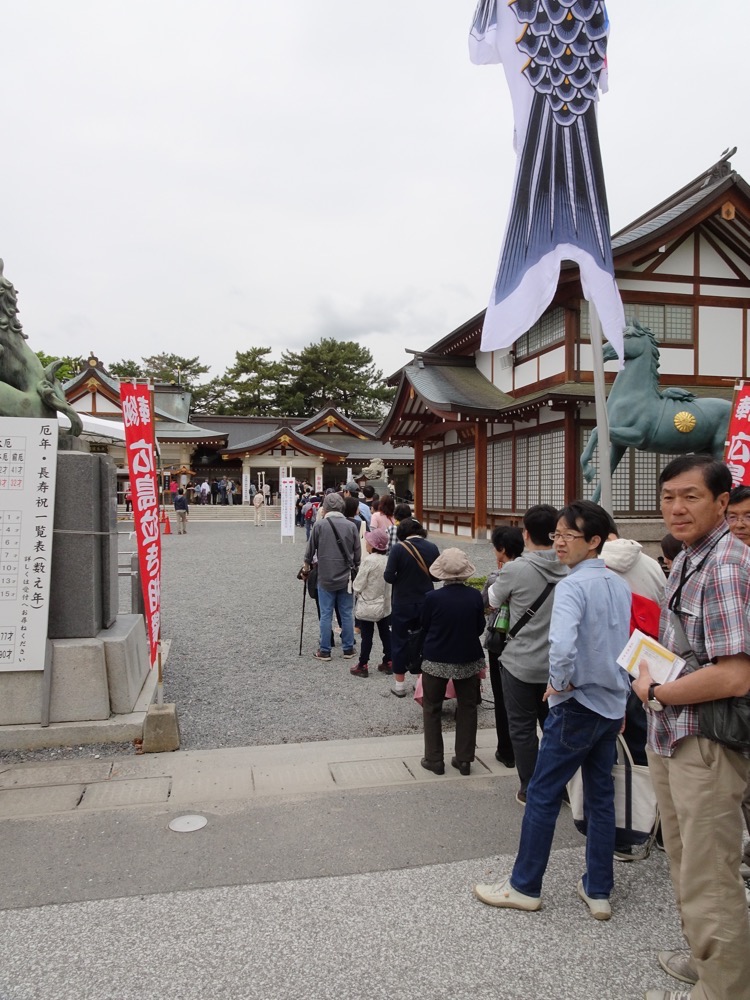 The queue to spend 30 seconds or some at the temple was inordinately long.
The queue to spend 30 seconds or some at the temple was inordinately long. Then I saw this sign and realised it was actually something to do with crying babies… but it didn’t make a whole lot more sense.
Then I saw this sign and realised it was actually something to do with crying babies… but it didn’t make a whole lot more sense. Eventually I found some information in English that read:
Eventually I found some information in English that read: Here is where you can find the famous statue of a Carp Swimming up a Waterfall. Hiroshima castle is also often called Carp Castle. The statue symbolises the following types of good luck:
Here is where you can find the famous statue of a Carp Swimming up a Waterfall. Hiroshima castle is also often called Carp Castle. The statue symbolises the following types of good luck: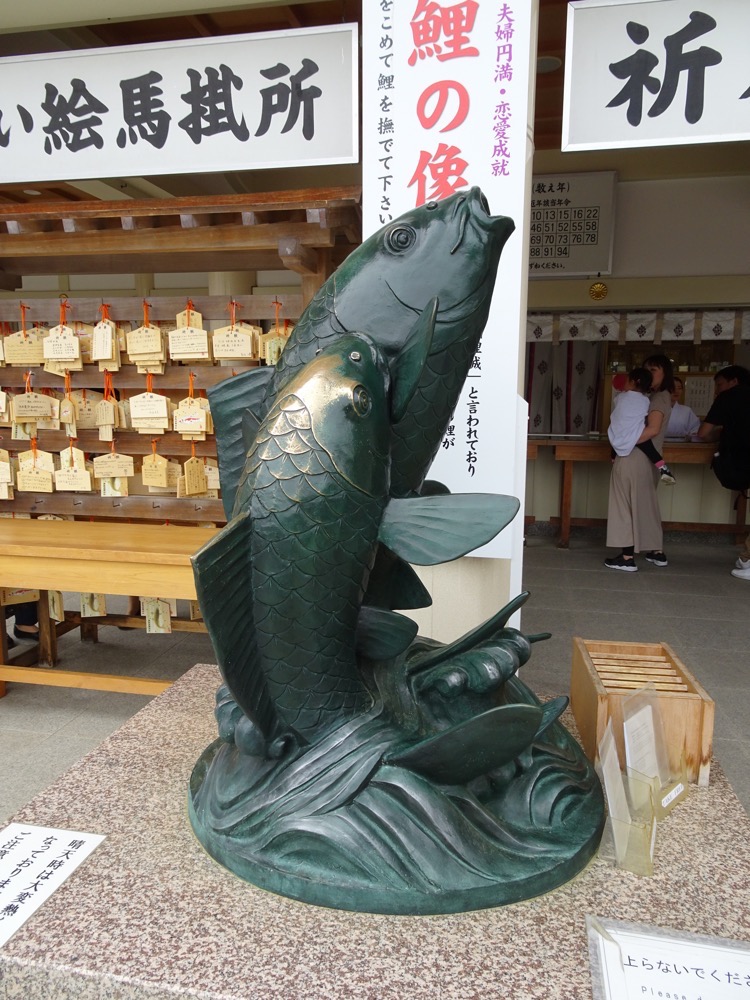 Votive plaques where visitors have written out their wishes for the future after visiting the shrine.
Votive plaques where visitors have written out their wishes for the future after visiting the shrine.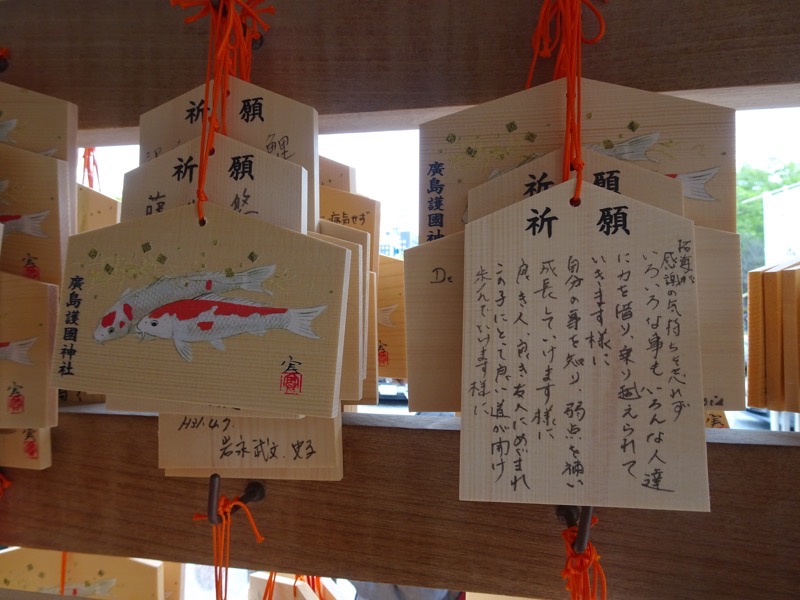

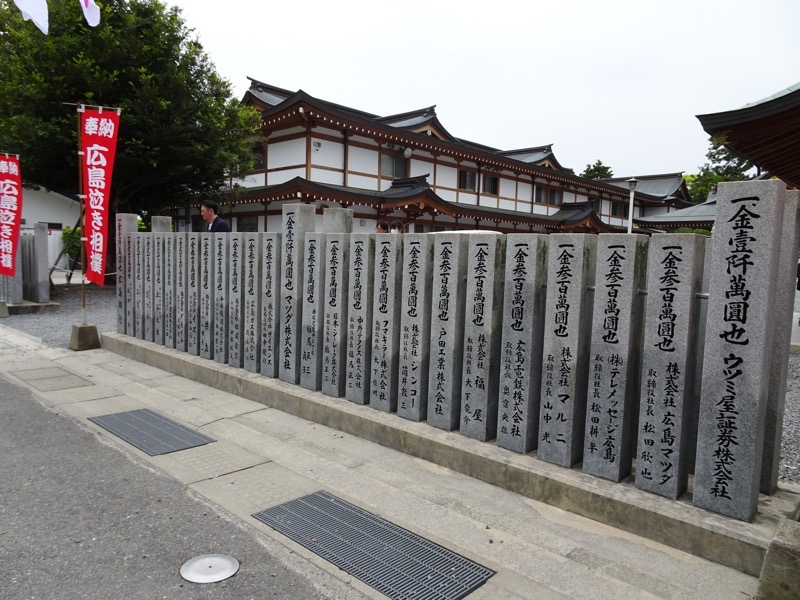 Close by is one of four known ‘atomic trees’, this one a pussy willow that survived the atomic blast in 1945. It is located 740m from the epicentre of the blast. It is quite remarkable that any trees remained given the buildings were completely flattened.
Close by is one of four known ‘atomic trees’, this one a pussy willow that survived the atomic blast in 1945. It is located 740m from the epicentre of the blast. It is quite remarkable that any trees remained given the buildings were completely flattened. The castle complex directly after the atomic bomb was dropped on August 6th, 1945… image (in a rather circuitous route) via the United States National Archives via japanairraids.org
The castle complex directly after the atomic bomb was dropped on August 6th, 1945… image (in a rather circuitous route) via the United States National Archives via japanairraids.org The outer keeps.
The outer keeps.
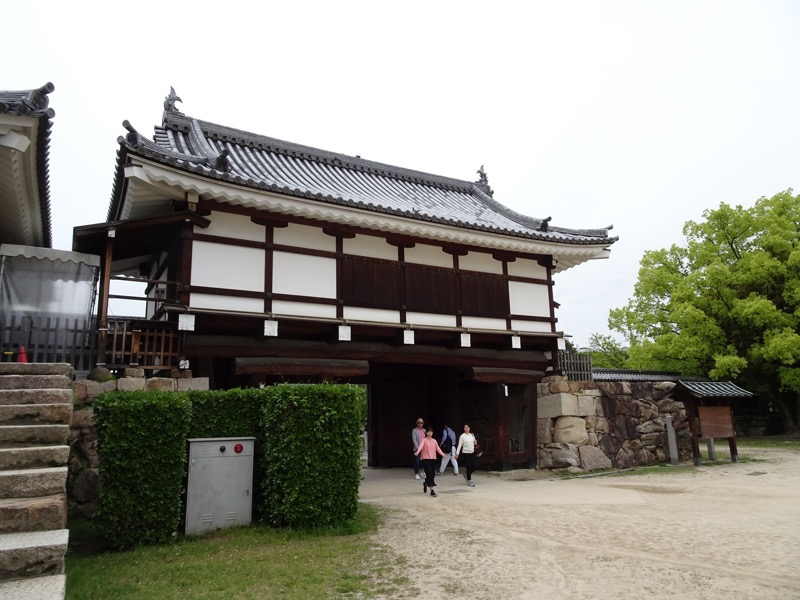

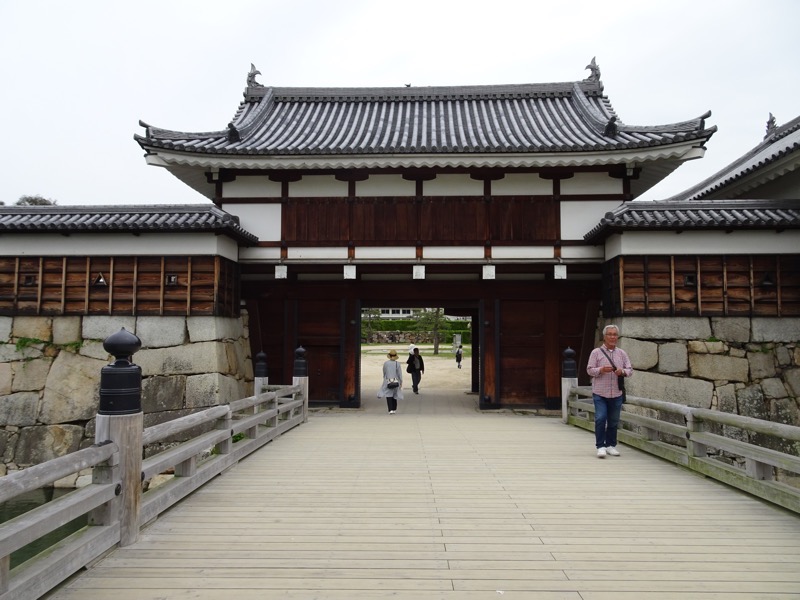

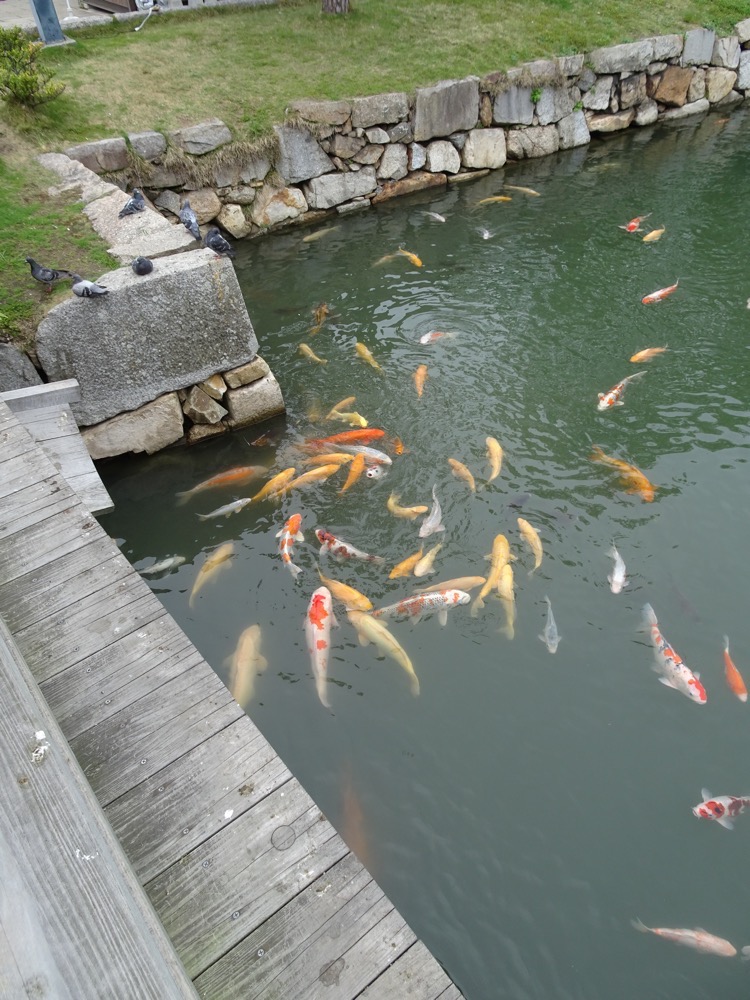 After we left the Castle complex we stopped momentarily at the Hiroshima Museum of Art, and were contemplating going in, but it turns out this museum was full of European artworks, so we merely stopped for a cup of Elderflower soda and some sake cake before moving on.
After we left the Castle complex we stopped momentarily at the Hiroshima Museum of Art, and were contemplating going in, but it turns out this museum was full of European artworks, so we merely stopped for a cup of Elderflower soda and some sake cake before moving on.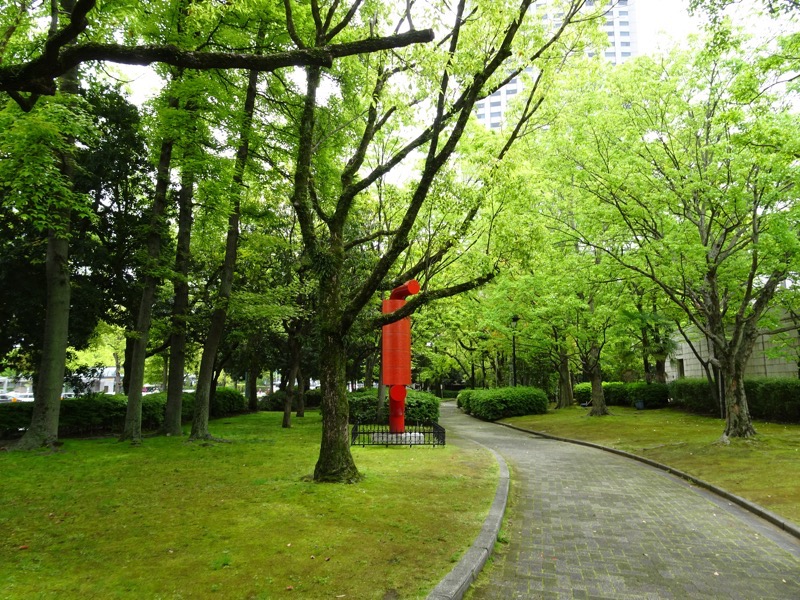
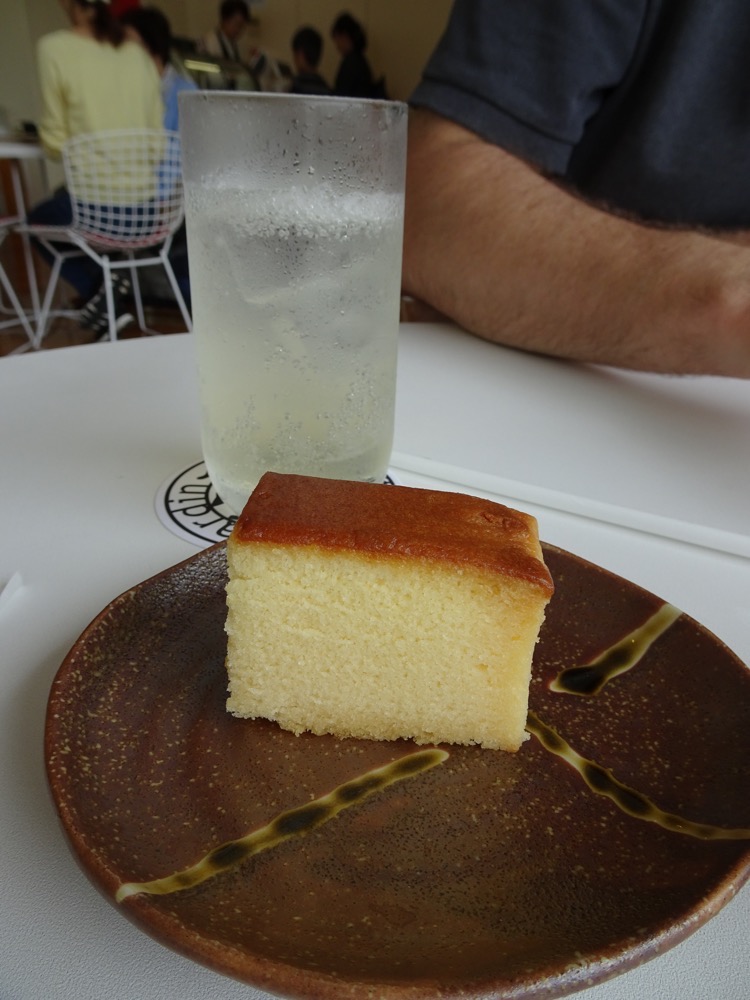
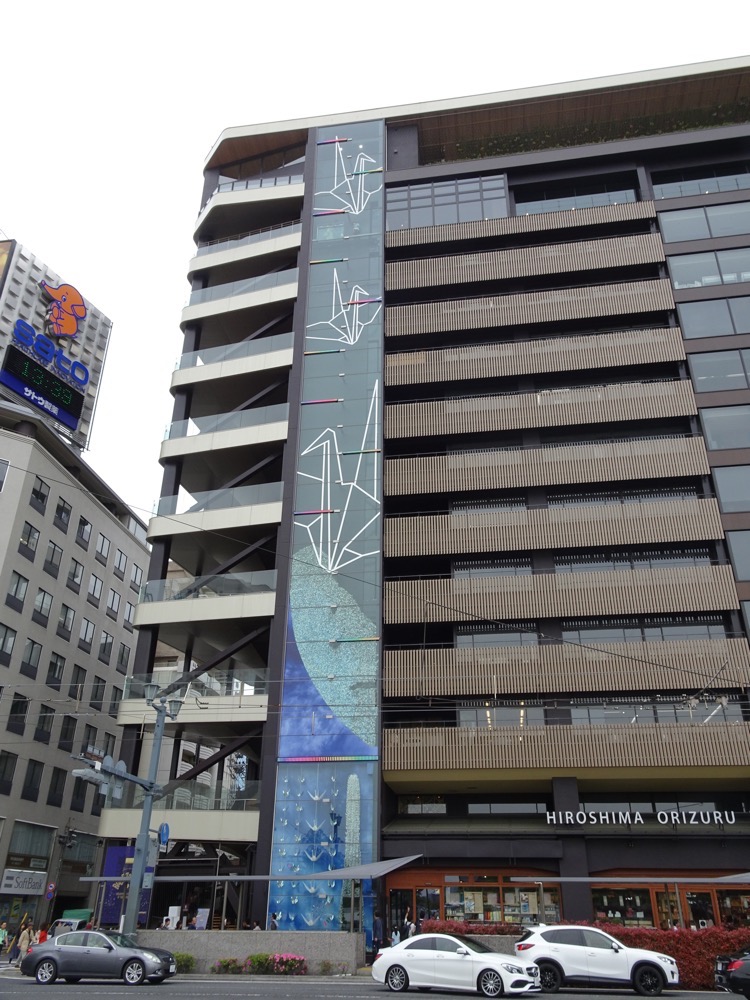
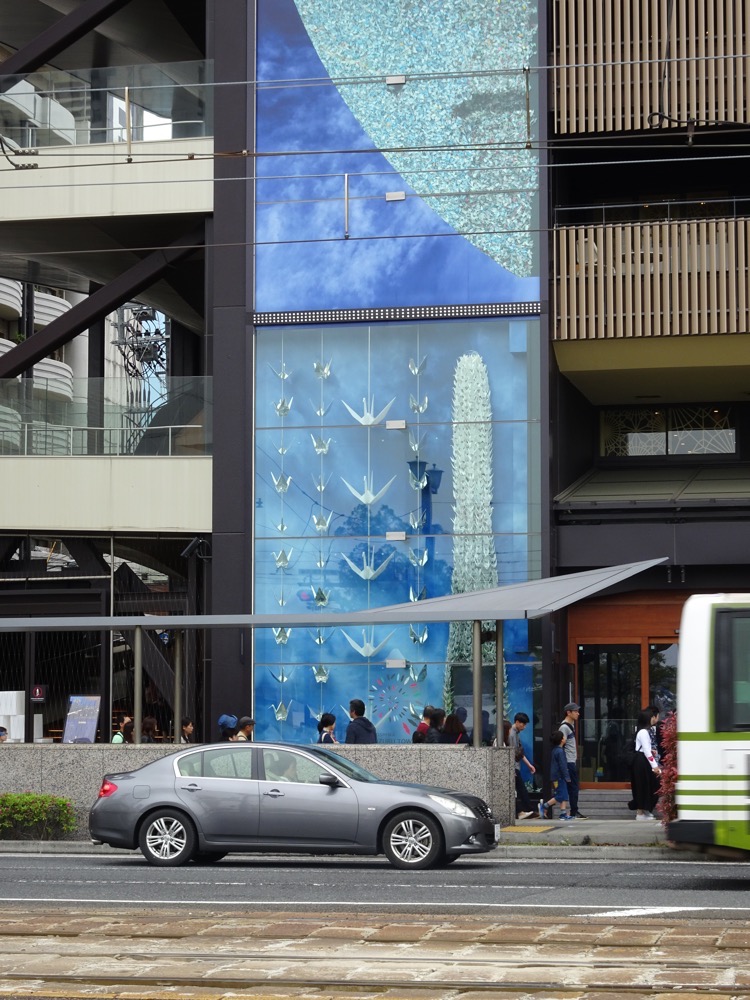
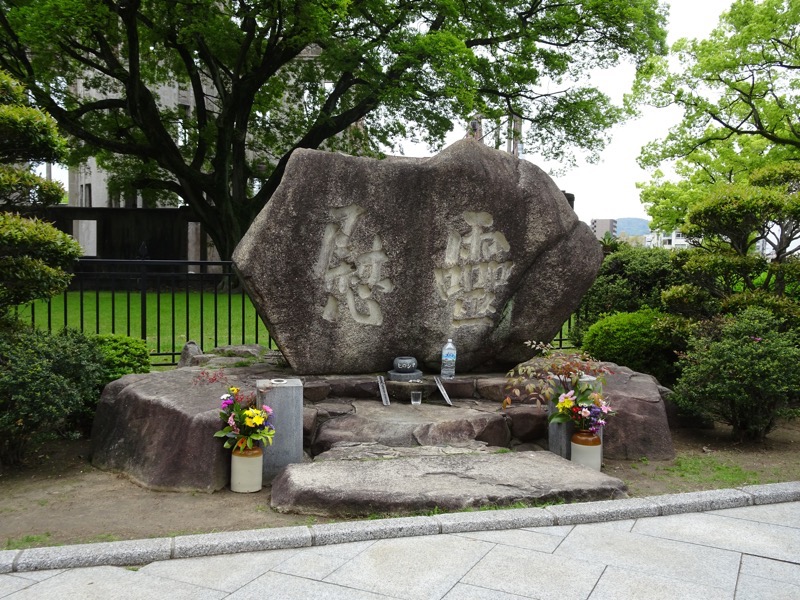 The Hiroshima Peace Memorial was originally the Hiroshima Prefectural Industrial Promotion Hall, and now commonly is more commonly known as the Genbaku Dome or the Atomic Bomb Dome. It is part of the Hiroshima Peace Memorial Park which was designated a UNESCO World Heritage Site in 1996. The ruin of the hall is a standing reminder to visitors of the people who were killed here in the atomic bombing of Hiroshima which precipitated the end of WWII. Over 70,000 people are reported to have been killed immediately and an another estimated 70,000 suffered fatal injuries from the radiation fallout.
The Hiroshima Peace Memorial was originally the Hiroshima Prefectural Industrial Promotion Hall, and now commonly is more commonly known as the Genbaku Dome or the Atomic Bomb Dome. It is part of the Hiroshima Peace Memorial Park which was designated a UNESCO World Heritage Site in 1996. The ruin of the hall is a standing reminder to visitors of the people who were killed here in the atomic bombing of Hiroshima which precipitated the end of WWII. Over 70,000 people are reported to have been killed immediately and an another estimated 70,000 suffered fatal injuries from the radiation fallout.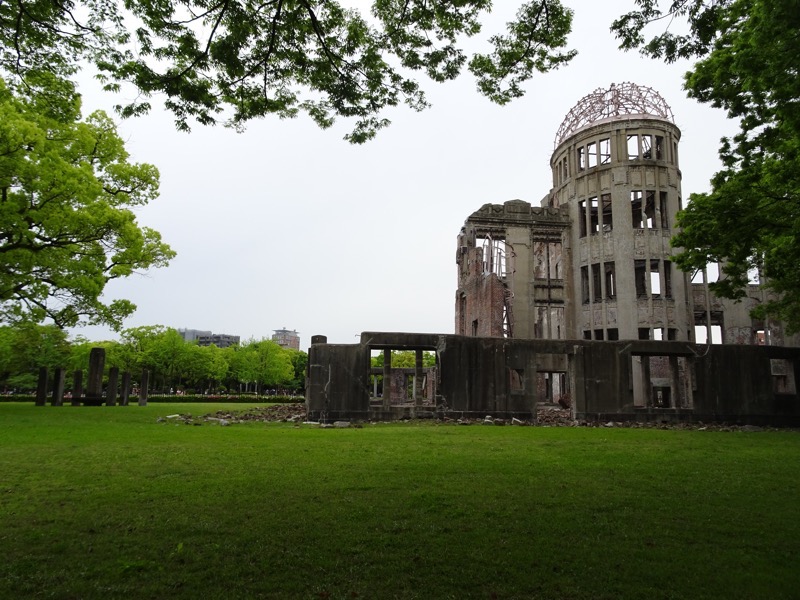
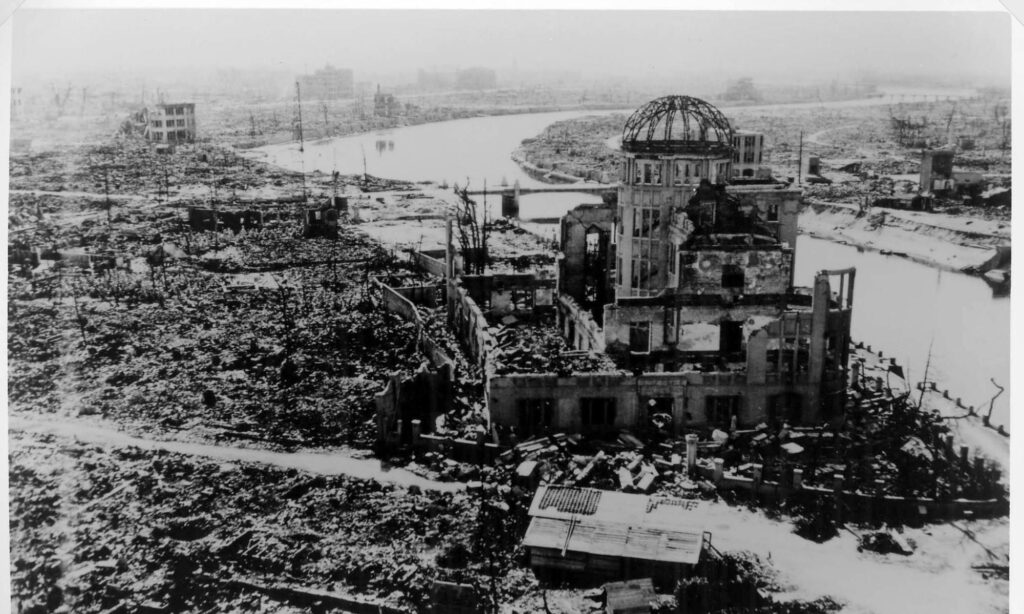
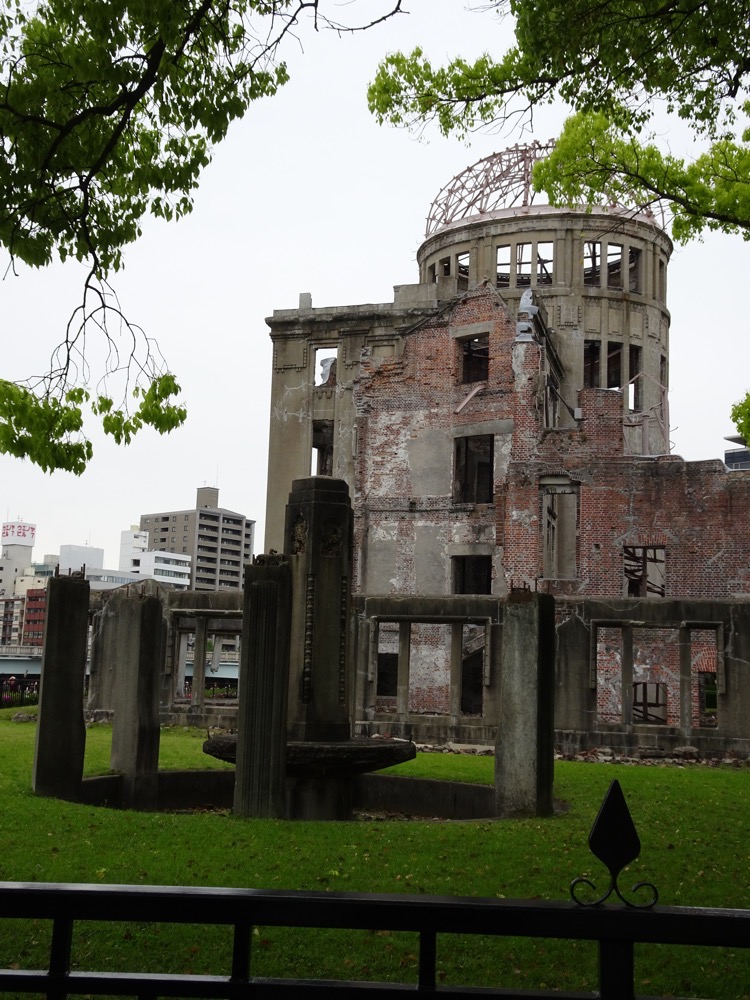 This small monument beside an ordinary apartment building marks the epicentre of the blast. The bomb was detonated 600m above the ground and the ensuing blast saw temperatures of 3000-4000C at ground level.
This small monument beside an ordinary apartment building marks the epicentre of the blast. The bomb was detonated 600m above the ground and the ensuing blast saw temperatures of 3000-4000C at ground level. 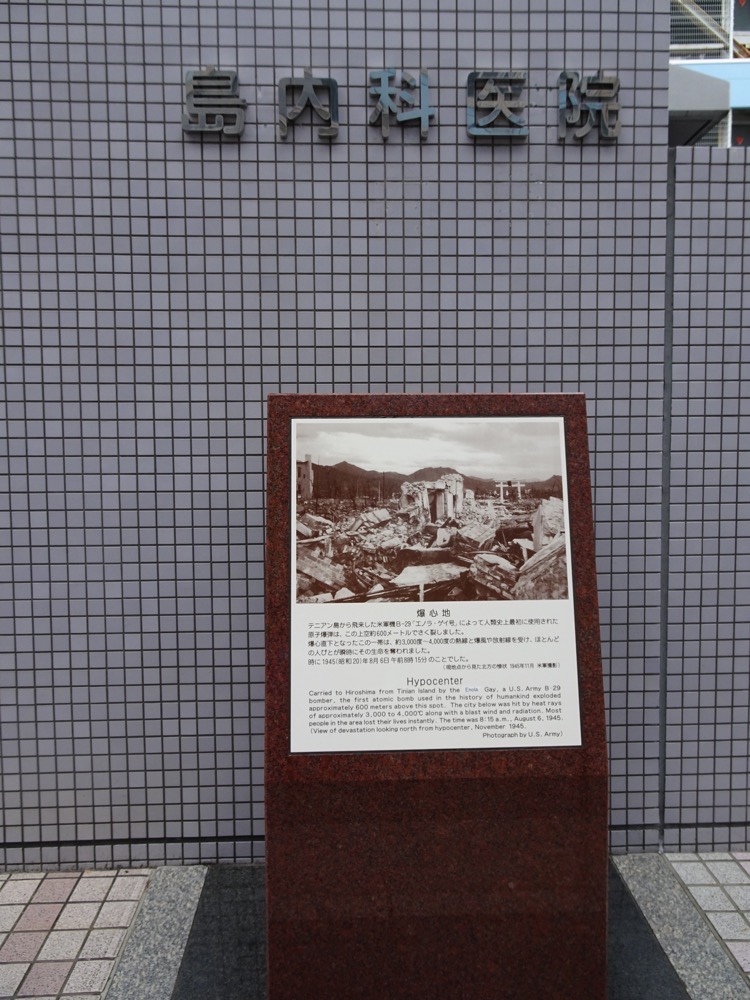 The Hiroshima bombing on 6th August 1945 which killed 70,000 did not see Japan immediately surrender their position in the war, causing the US forces to drop more atomic bombs in Nagasaki (where the Mitsubishi shipbuilding yards were located) on 9th August 1945 which killed up to an estimated 246,000 people, at which point Japan capitulated.
The Hiroshima bombing on 6th August 1945 which killed 70,000 did not see Japan immediately surrender their position in the war, causing the US forces to drop more atomic bombs in Nagasaki (where the Mitsubishi shipbuilding yards were located) on 9th August 1945 which killed up to an estimated 246,000 people, at which point Japan capitulated. Two aerial photos of atomic bomb mushroom clouds, over Hiroshima (left) and Nagasaki (right) in 1945.
Two aerial photos of atomic bomb mushroom clouds, over Hiroshima (left) and Nagasaki (right) in 1945.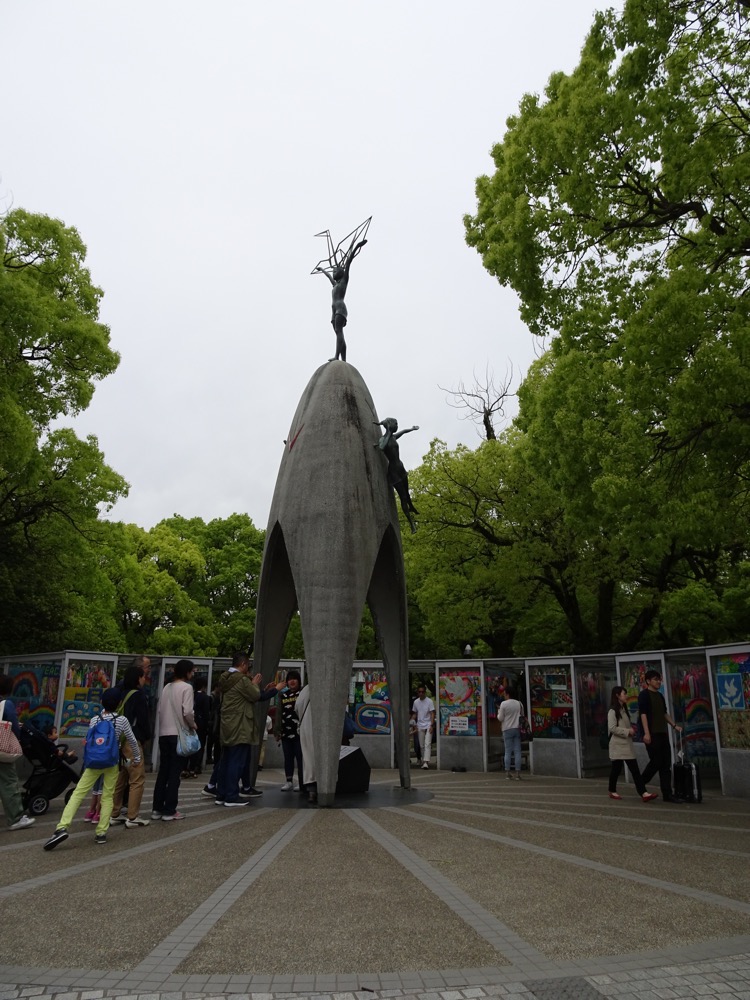 Children from all over Japan engage in making origami peace cranes and sending them to Nagasaki and Hiroshima. It is a mission/endeavour designed to remind people of the necessity for peace and to commemorate the loss of life in WWII.
Children from all over Japan engage in making origami peace cranes and sending them to Nagasaki and Hiroshima. It is a mission/endeavour designed to remind people of the necessity for peace and to commemorate the loss of life in WWII.
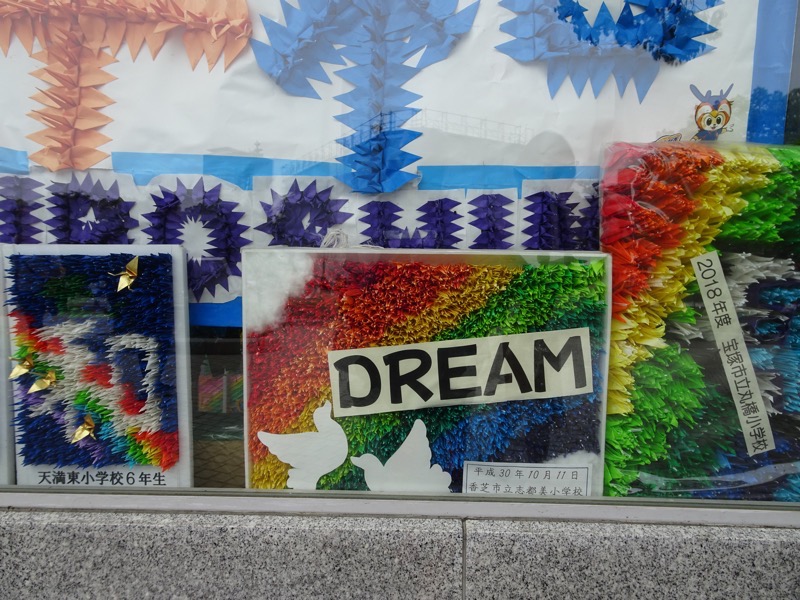
 Further down into the Peace Park is an eternal flame… not very visible in this image.
Further down into the Peace Park is an eternal flame… not very visible in this image.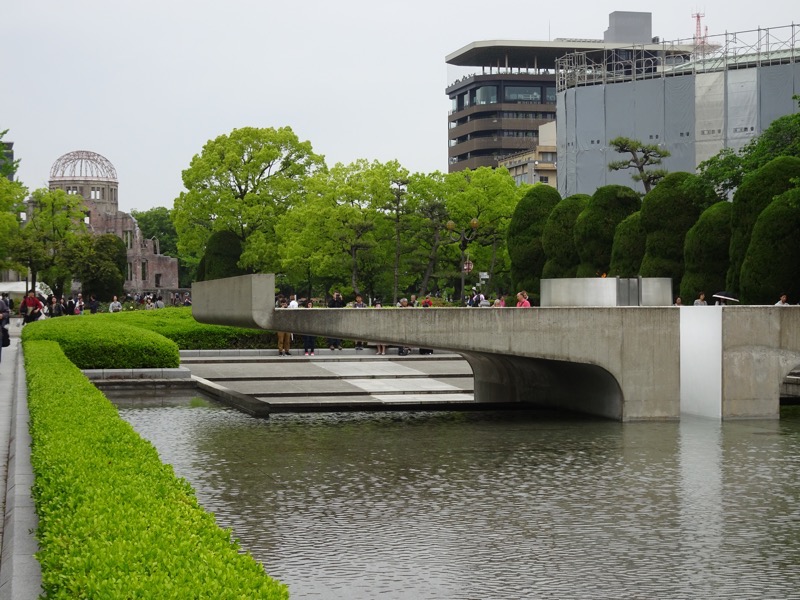
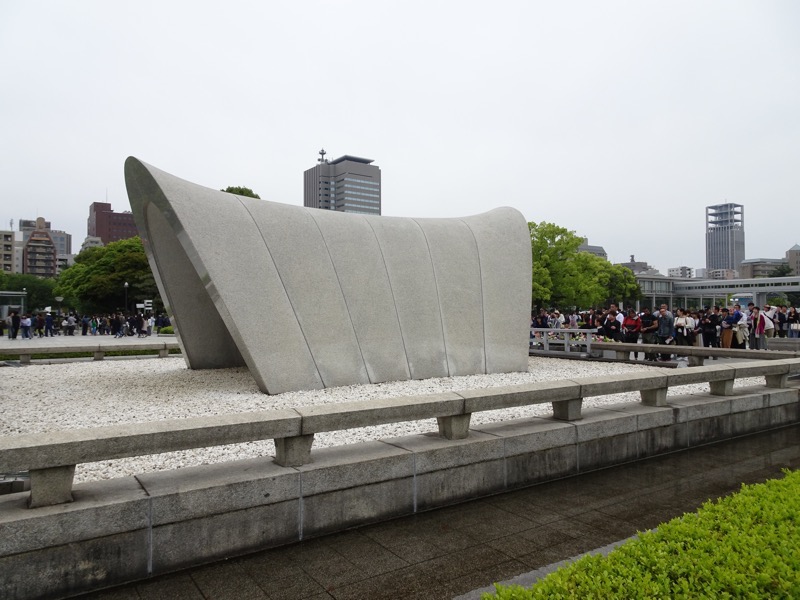

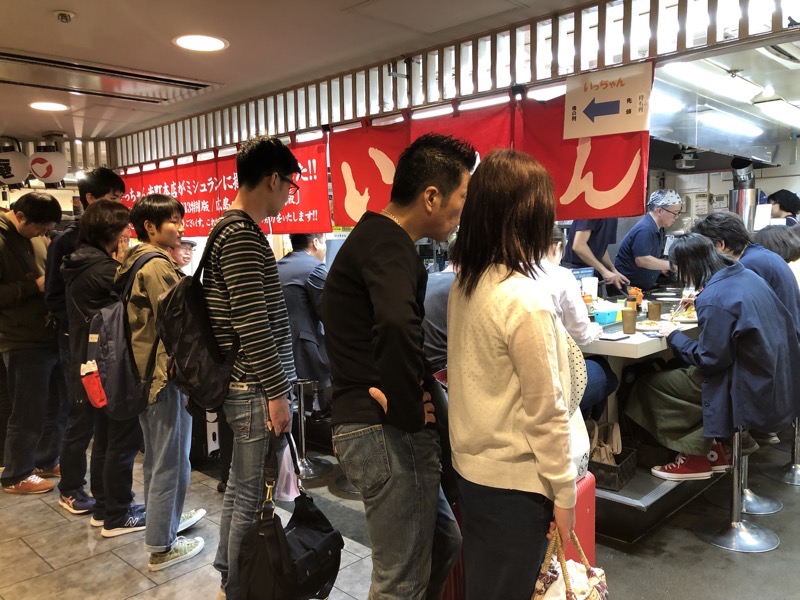

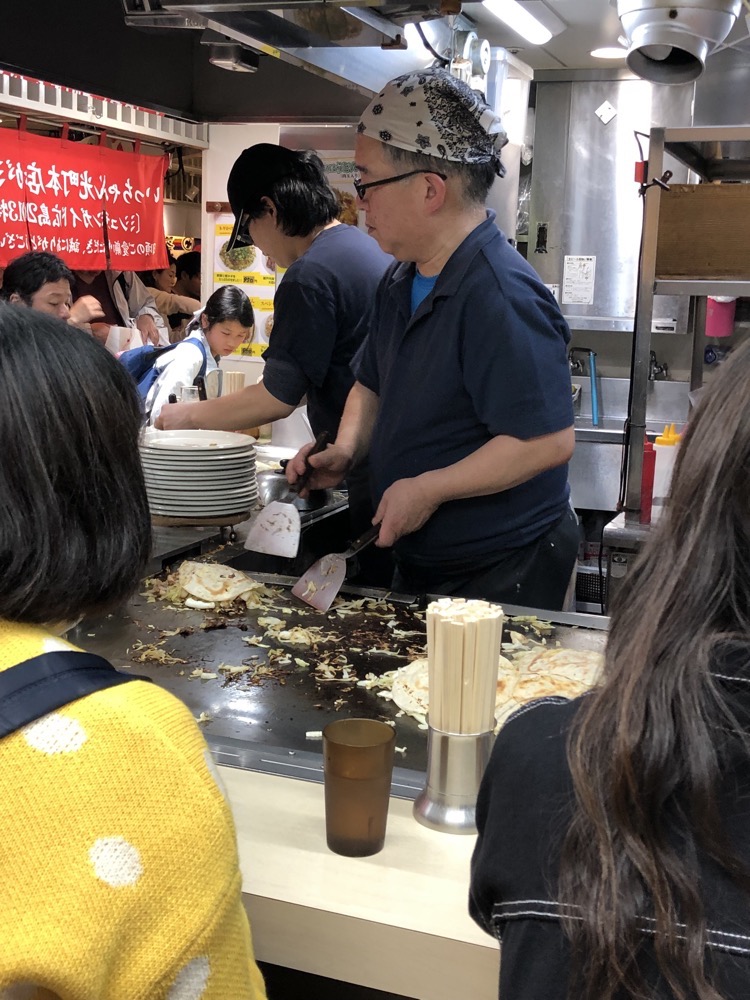 Shrimp and calamari Hiroshima style (soba noodles added) okonomiyaki. Very tasty and very filling. I couldn’t finish it, which no doubt pleased Mr K enormously.
Shrimp and calamari Hiroshima style (soba noodles added) okonomiyaki. Very tasty and very filling. I couldn’t finish it, which no doubt pleased Mr K enormously. While waiting in line at the 7/11 to buy some sake for the train ride, I saw this… Jump onto xe.com and check out the exchange rate, and weep a little. These are shitty convenience store at the train station prices too! We pay so much tax on alcohol in Australia.
While waiting in line at the 7/11 to buy some sake for the train ride, I saw this… Jump onto xe.com and check out the exchange rate, and weep a little. These are shitty convenience store at the train station prices too! We pay so much tax on alcohol in Australia.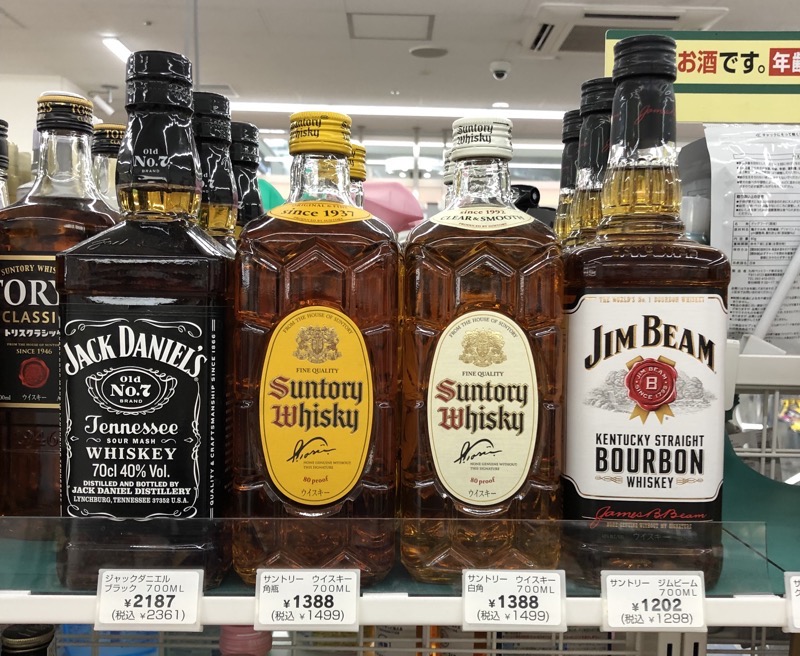 Also at the shopping centre near the train station – Hokkaido style cheese tarts with a local hint of Hiroshima lemony goodness! A special treat that I felt was well deserved after standing on the train this morning and walking over 12.5kms today on hard concrete pathways.
Also at the shopping centre near the train station – Hokkaido style cheese tarts with a local hint of Hiroshima lemony goodness! A special treat that I felt was well deserved after standing on the train this morning and walking over 12.5kms today on hard concrete pathways.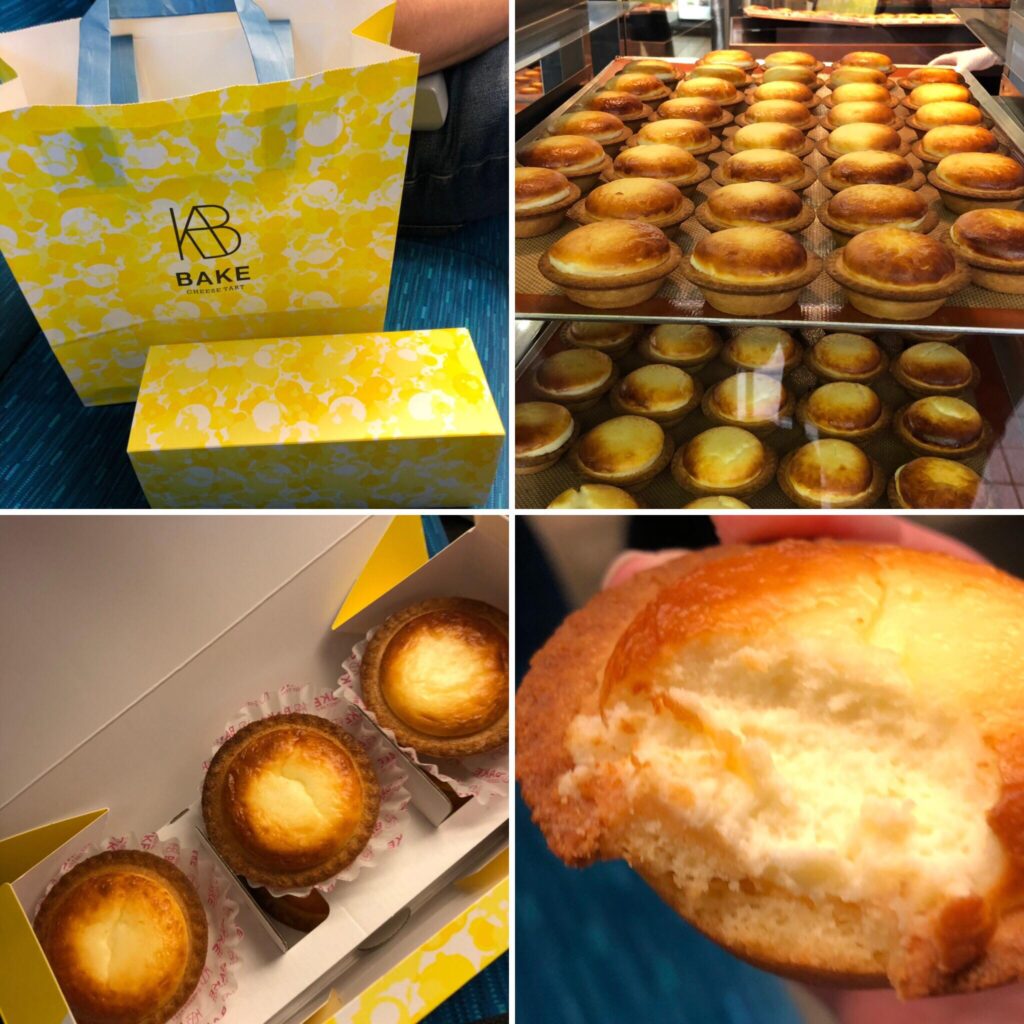 Then it was back onto the Shinkansen to head back to Osaka. We needed have worried about reserving me a seat, as it happens the trains heading back the other way were all largely empty, but I was eternally grateful that I had been carrying the knowledge around all day that I would not be tortured for hours by being forced to stand on the train ride back to Osaka.
Then it was back onto the Shinkansen to head back to Osaka. We needed have worried about reserving me a seat, as it happens the trains heading back the other way were all largely empty, but I was eternally grateful that I had been carrying the knowledge around all day that I would not be tortured for hours by being forced to stand on the train ride back to Osaka.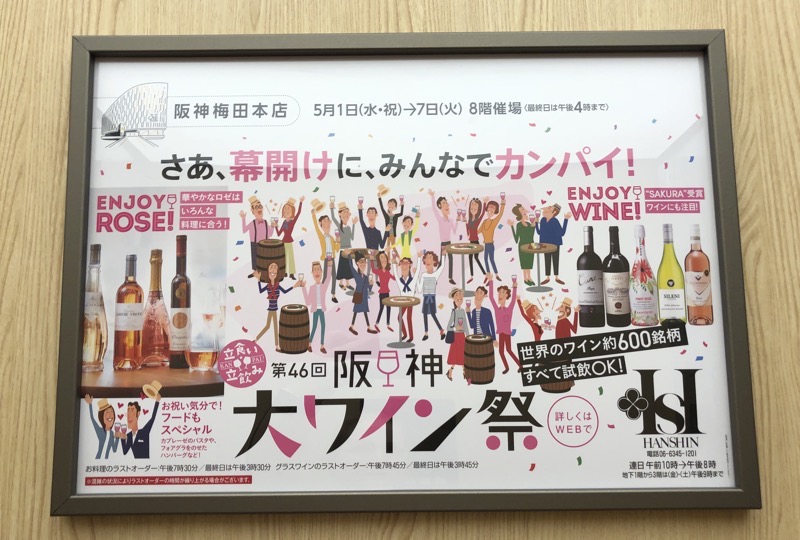

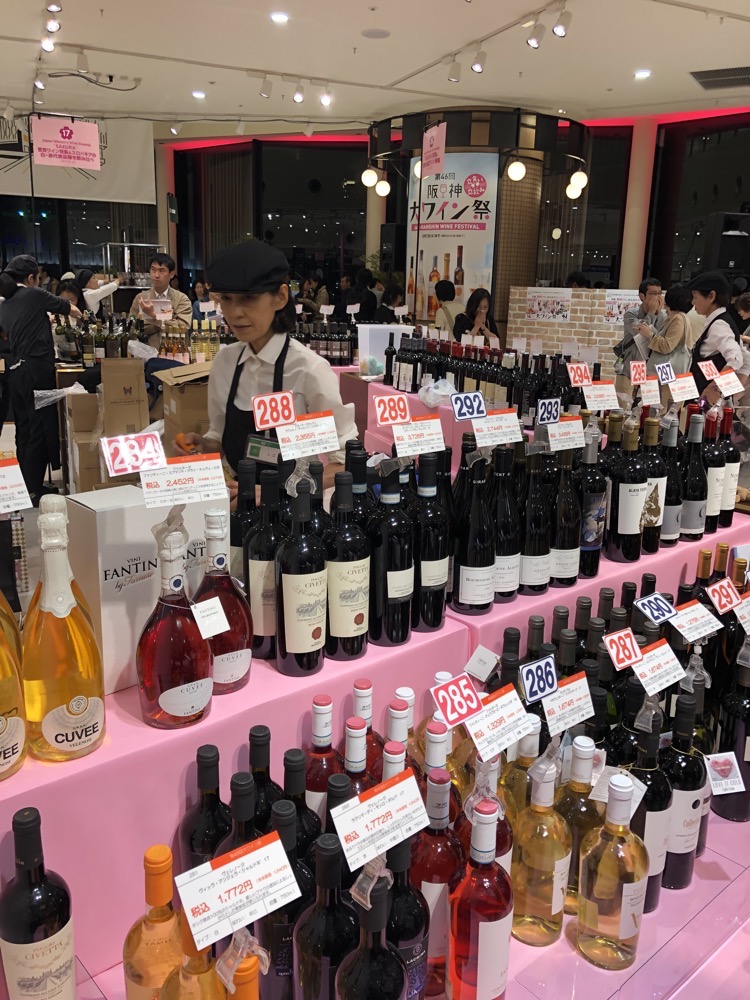 A couple of the vendors were asking me if I wanted to try any wines, but they rapidly gave up after hearing I was Australian… I have a feeling the event was designed for promotion, education and sales of international wines, and they probably assumed that flogging wine to travelling Australians might be a waste of time and effort.
A couple of the vendors were asking me if I wanted to try any wines, but they rapidly gave up after hearing I was Australian… I have a feeling the event was designed for promotion, education and sales of international wines, and they probably assumed that flogging wine to travelling Australians might be a waste of time and effort.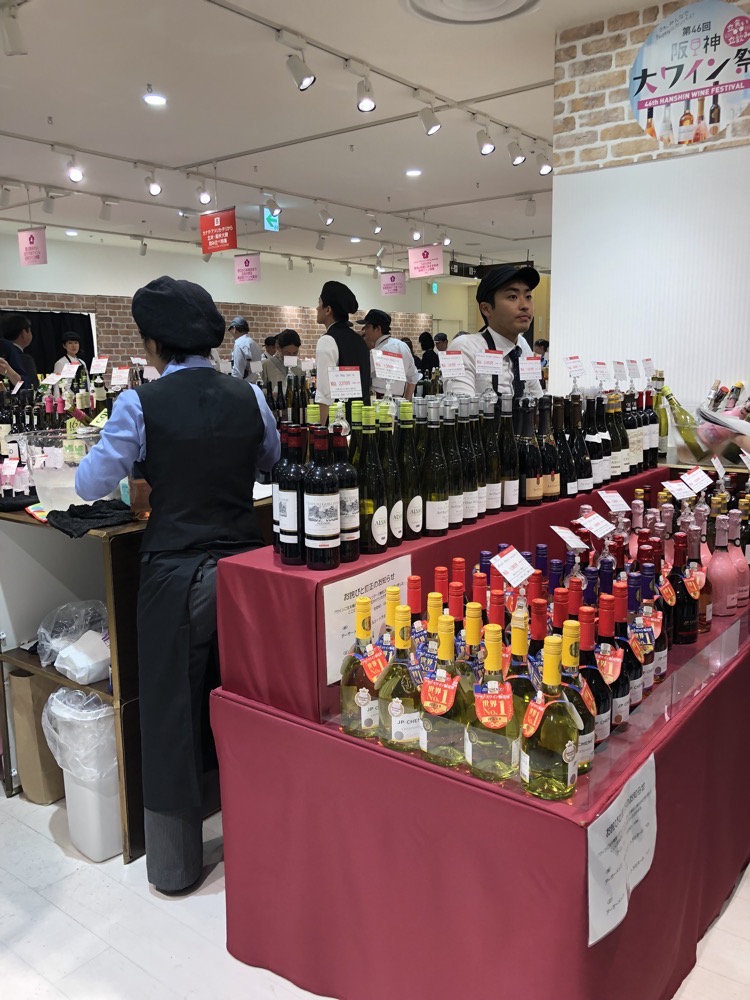 We eventually got back to our Hotel Samurai at about 9pm…? Ever such a long day and I was in soooo much pain. Thank you past me for the suite I booked came that complete with hot tub! So far, each evening has ended in a soak with sake. Tomorrow is another day – and likely one that won’t have an early start!
We eventually got back to our Hotel Samurai at about 9pm…? Ever such a long day and I was in soooo much pain. Thank you past me for the suite I booked came that complete with hot tub! So far, each evening has ended in a soak with sake. Tomorrow is another day – and likely one that won’t have an early start! A queue that stretched for about 250m BEFORE it got to the Disney-esque rope lines that were organising visitors into an orderly squish while they waited to line up and buy tickets. Well, as much as I love the fishes (probably most of which are pilfered from the Great Barrier Reef anyway) and of course the otters, there was no way I was standing in line for several hours to enter into exhibition halls full of overexcited children and semi-distraught, but amused, parents. So we did an about-face and decided to head to an art museum instead. So many little takoyaki stalls in/around the aquarium… come see the squids and jellyfishes, don’t forget to eat some before you leave?!
A queue that stretched for about 250m BEFORE it got to the Disney-esque rope lines that were organising visitors into an orderly squish while they waited to line up and buy tickets. Well, as much as I love the fishes (probably most of which are pilfered from the Great Barrier Reef anyway) and of course the otters, there was no way I was standing in line for several hours to enter into exhibition halls full of overexcited children and semi-distraught, but amused, parents. So we did an about-face and decided to head to an art museum instead. So many little takoyaki stalls in/around the aquarium… come see the squids and jellyfishes, don’t forget to eat some before you leave?! Given our late start to the day, we thought we would pop in for some lunch at a cute little curry place. I love how you order a small curry and you end up with a pile of stuff to try, some of it recognisable, some of it not so much!
Given our late start to the day, we thought we would pop in for some lunch at a cute little curry place. I love how you order a small curry and you end up with a pile of stuff to try, some of it recognisable, some of it not so much! The Yuki Art Museum is a small gallery dedicated to the objects used in traditional Japanese tea ceremonies. The Japanese tea ceremony, or the Way of Tea, is a cultural activity that involves a ritualized ceremonial preparation of matcha, a powdered green tea. This museum house many important Japanese cultural objects, predominantly from the Edo period (approximately 1600-1870), relating to the tea ceremonies (And yes! it was much quieter and more pleasant here than at the aquarium!)
The Yuki Art Museum is a small gallery dedicated to the objects used in traditional Japanese tea ceremonies. The Japanese tea ceremony, or the Way of Tea, is a cultural activity that involves a ritualized ceremonial preparation of matcha, a powdered green tea. This museum house many important Japanese cultural objects, predominantly from the Edo period (approximately 1600-1870), relating to the tea ceremonies (And yes! it was much quieter and more pleasant here than at the aquarium!)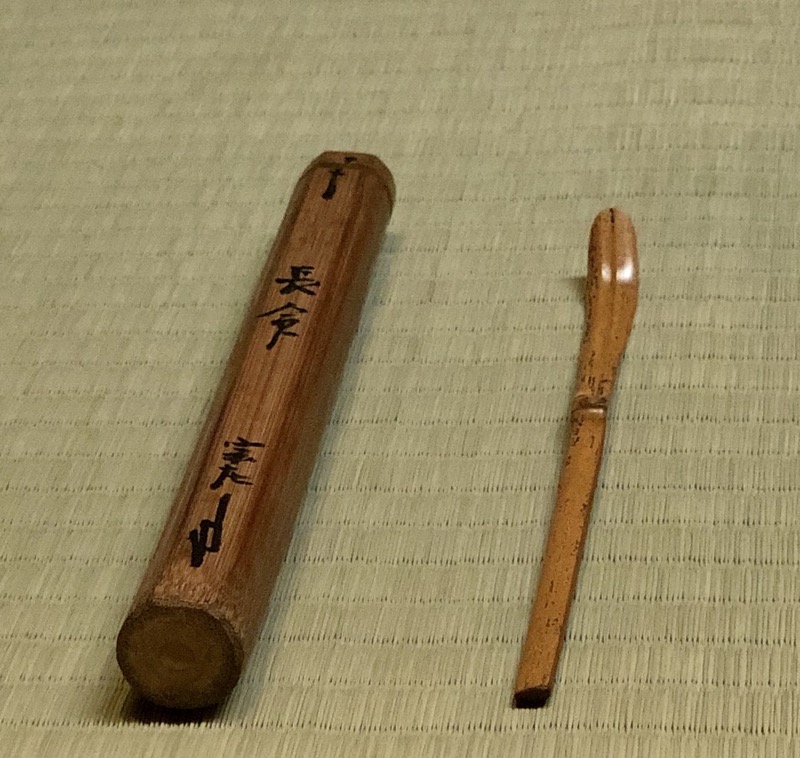 Gour used to bear hot water, late 1800s.
Gour used to bear hot water, late 1800s.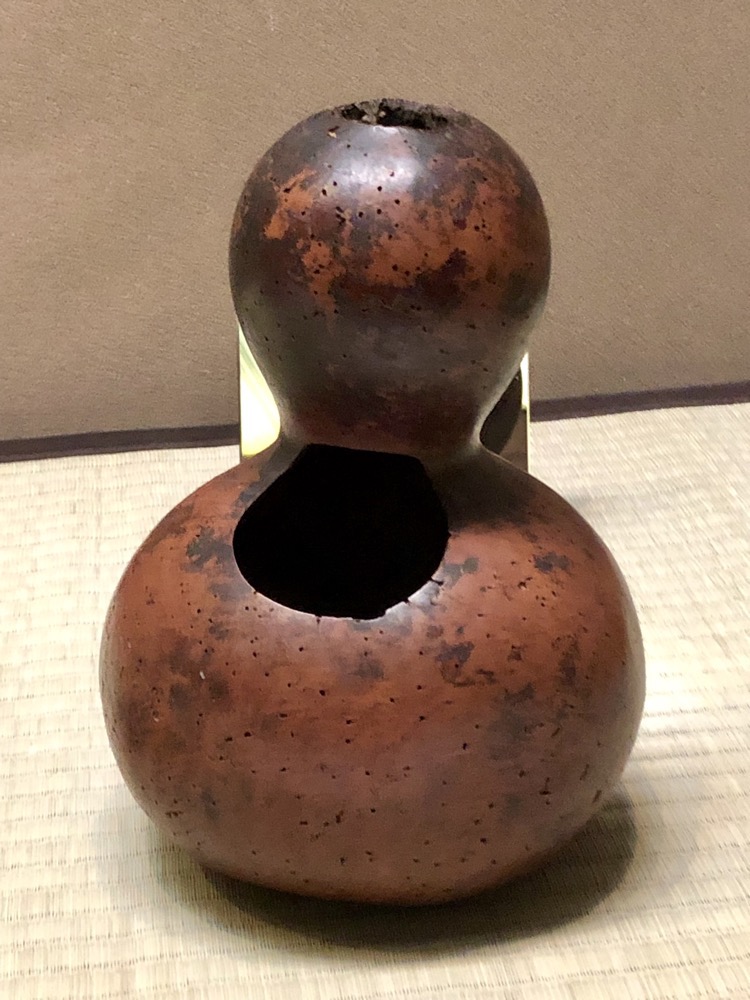 Water jar, Ryukyo-Suisya (Willow bridge and water wheel folding screens design) Ninsei studio, also Edo period, 17thC.
Water jar, Ryukyo-Suisya (Willow bridge and water wheel folding screens design) Ninsei studio, also Edo period, 17thC. 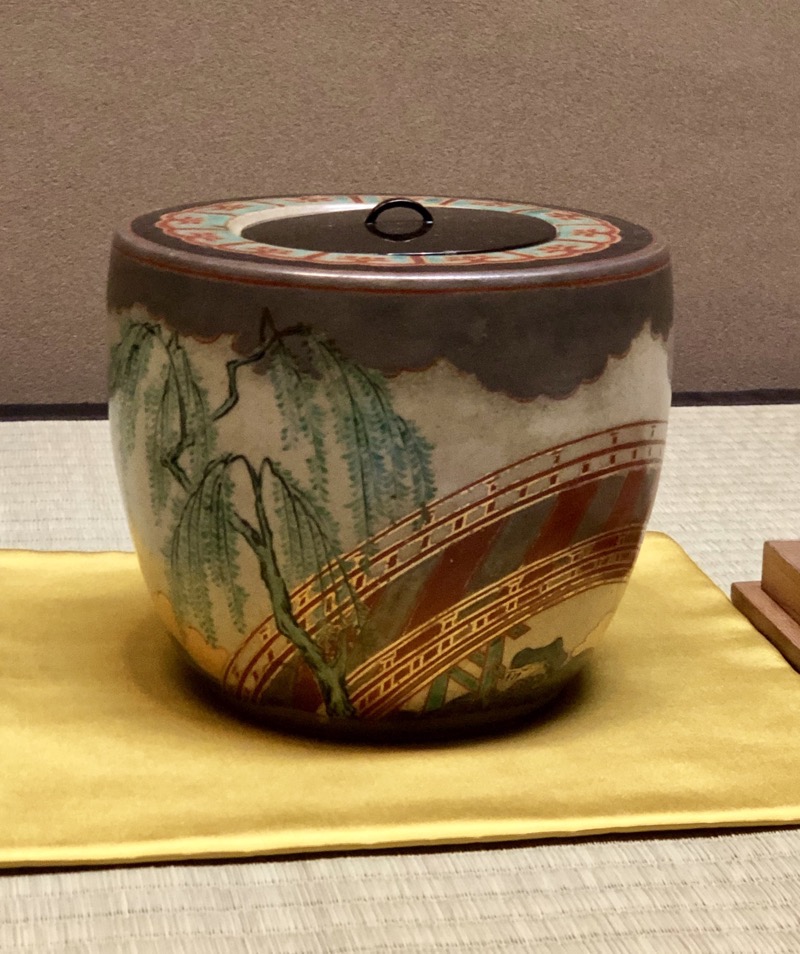 Water kettle – Yoho (square) type, by Yojiro. Muromachi period, 16th C.
Water kettle – Yoho (square) type, by Yojiro. Muromachi period, 16th C. Tea bowl and dishes used in Japanese tea ceremony.
Tea bowl and dishes used in Japanese tea ceremony.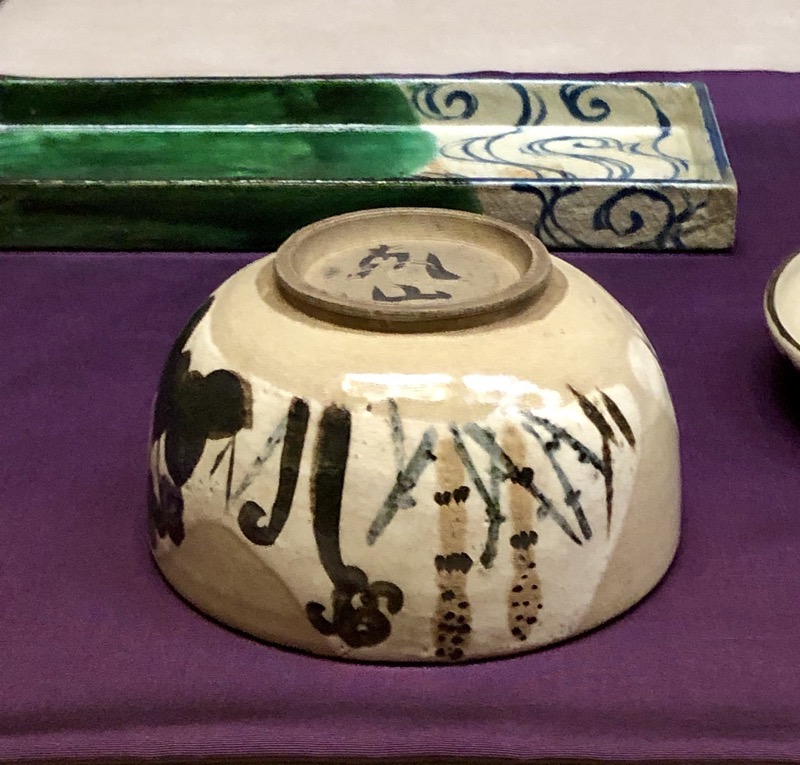
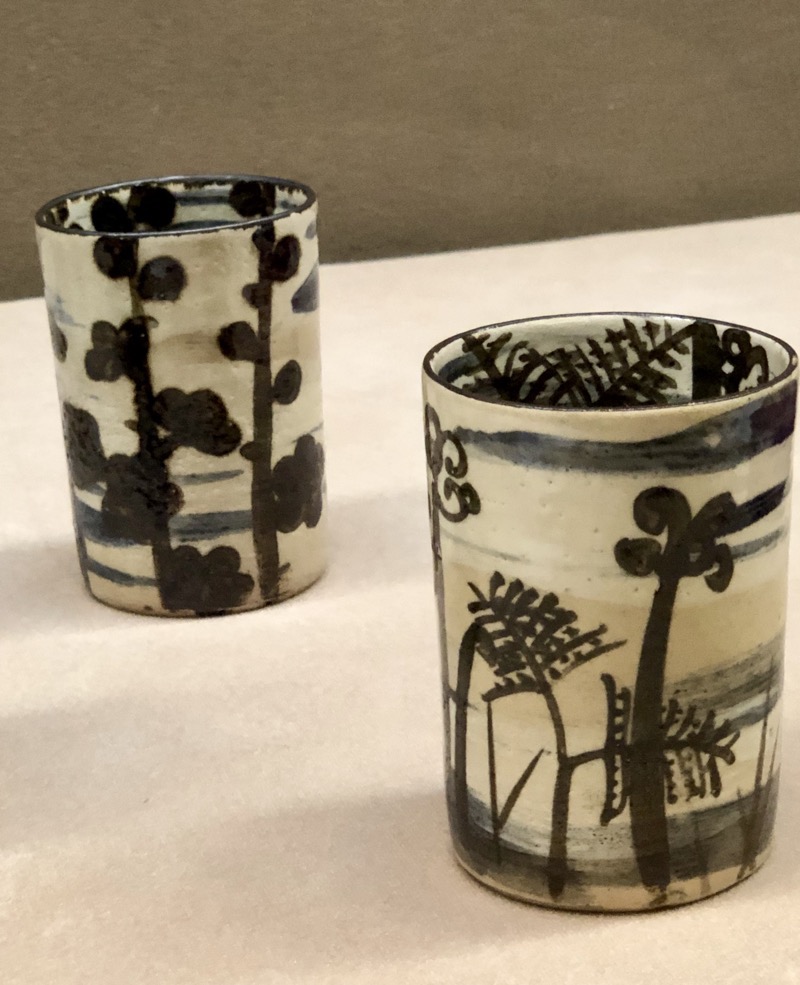 Tea bowl, mountain and river design, late Edo period, studio of Kenzan, c.1860s.
Tea bowl, mountain and river design, late Edo period, studio of Kenzan, c.1860s.

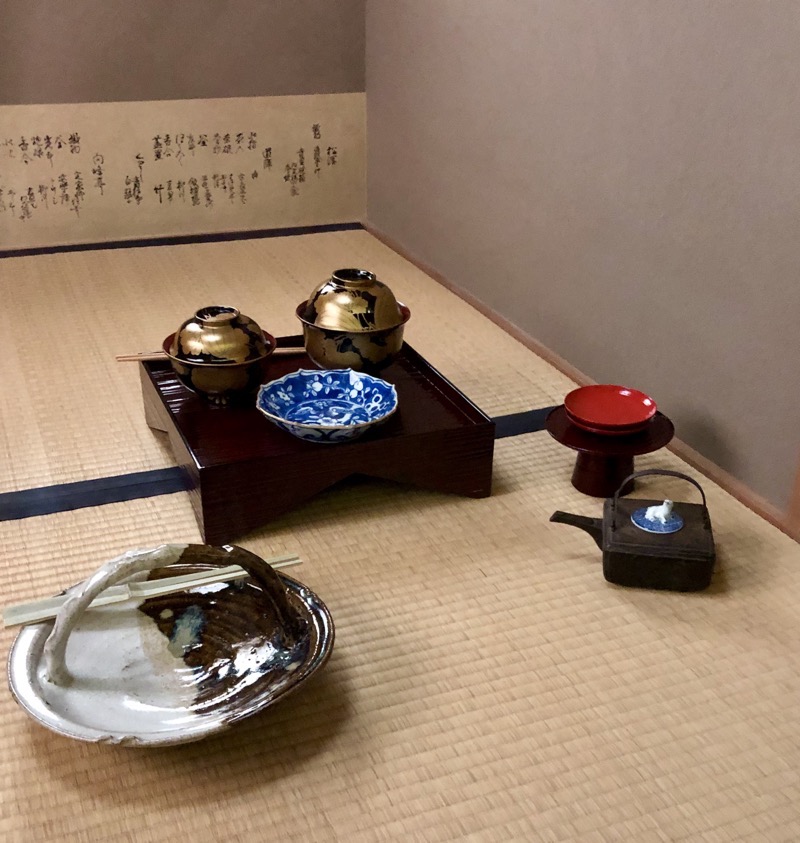 Intricately pierced lacquerware trays, late Edo period 19thC.
Intricately pierced lacquerware trays, late Edo period 19thC. Tea caddies, Katatsuki (square shouldered type), Seto ware known as Shunzan-Asei, Edo period 17th C.
Tea caddies, Katatsuki (square shouldered type), Seto ware known as Shunzan-Asei, Edo period 17th C.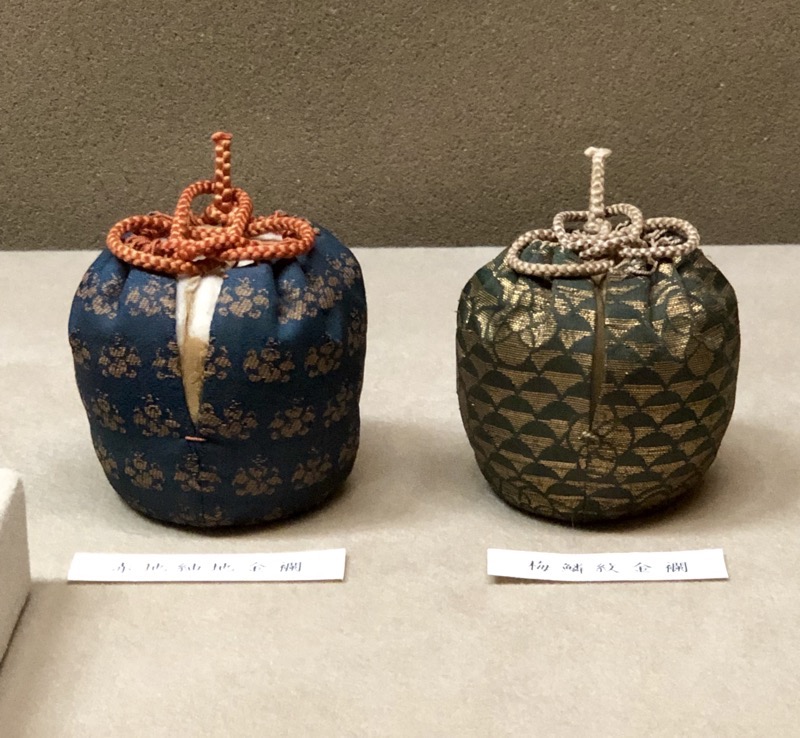

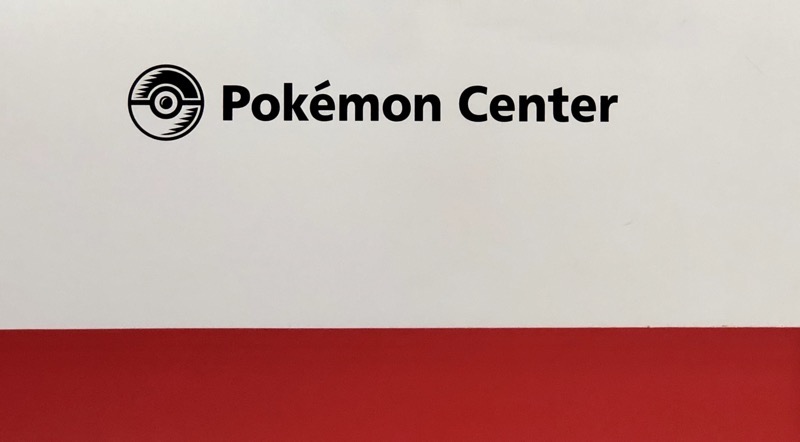 So much plush – must resist the urge to tidy it!
So much plush – must resist the urge to tidy it!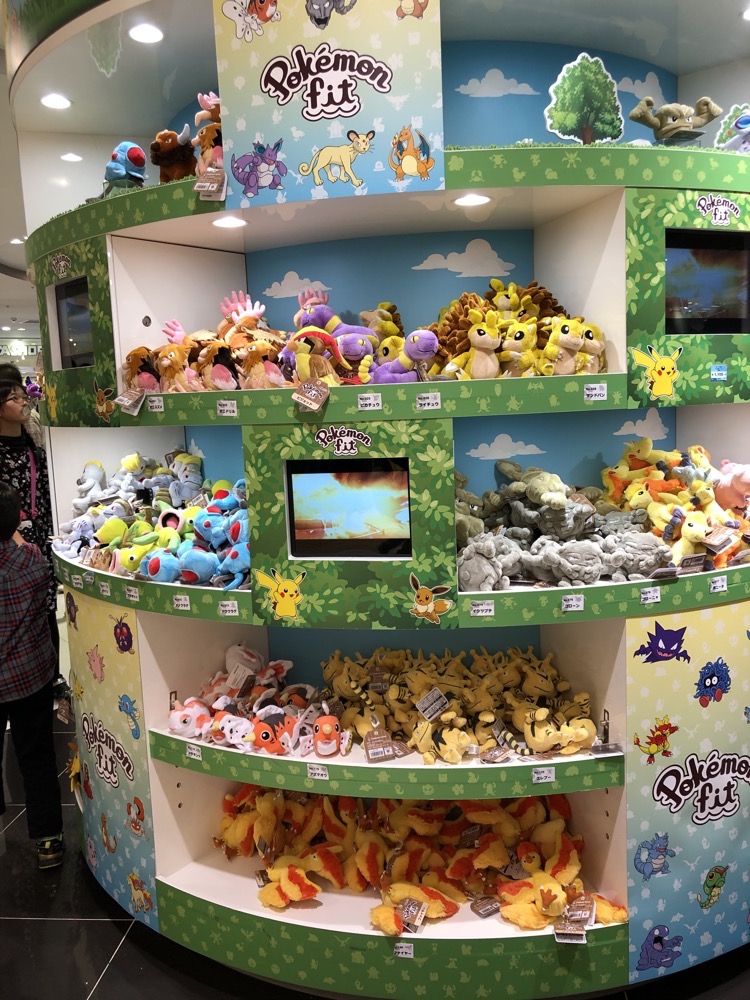
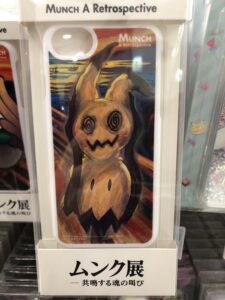 This Pokemon Centre appears to be the same as the Tokyo one, though slightly more toys and stuff crammed into slightly less space. I feel like Nintendo are really missing opportunities to properly merchandise their crap though. Most of their stuff is aimed at small kids, yet it’s overpriced and usually quite poor quality. The whole thing feels a bit weird, especially given the global popularity of Pokemon Go. Most small kids lost interest in Pokemon Go fairly quickly – you need to be mobile and have lots of time out of the house to be effective to play it… many kids relying on parents to ferry them to battles and events eventually gave up. The result of which is that the average Pokemon player seems to be in the 20s-40s and they effectively walking wallets… but come in here, and there is very limited merchandise aimed at this audience. I’m quite surprised at this oversight, as Nintendo already have the perfect model in Disney to make sure they are covering all their bases and maximising their exposure and profits. It feels like they just don’t known or care to cater to their older customers.*shrug*
This Pokemon Centre appears to be the same as the Tokyo one, though slightly more toys and stuff crammed into slightly less space. I feel like Nintendo are really missing opportunities to properly merchandise their crap though. Most of their stuff is aimed at small kids, yet it’s overpriced and usually quite poor quality. The whole thing feels a bit weird, especially given the global popularity of Pokemon Go. Most small kids lost interest in Pokemon Go fairly quickly – you need to be mobile and have lots of time out of the house to be effective to play it… many kids relying on parents to ferry them to battles and events eventually gave up. The result of which is that the average Pokemon player seems to be in the 20s-40s and they effectively walking wallets… but come in here, and there is very limited merchandise aimed at this audience. I’m quite surprised at this oversight, as Nintendo already have the perfect model in Disney to make sure they are covering all their bases and maximising their exposure and profits. It feels like they just don’t known or care to cater to their older customers.*shrug* 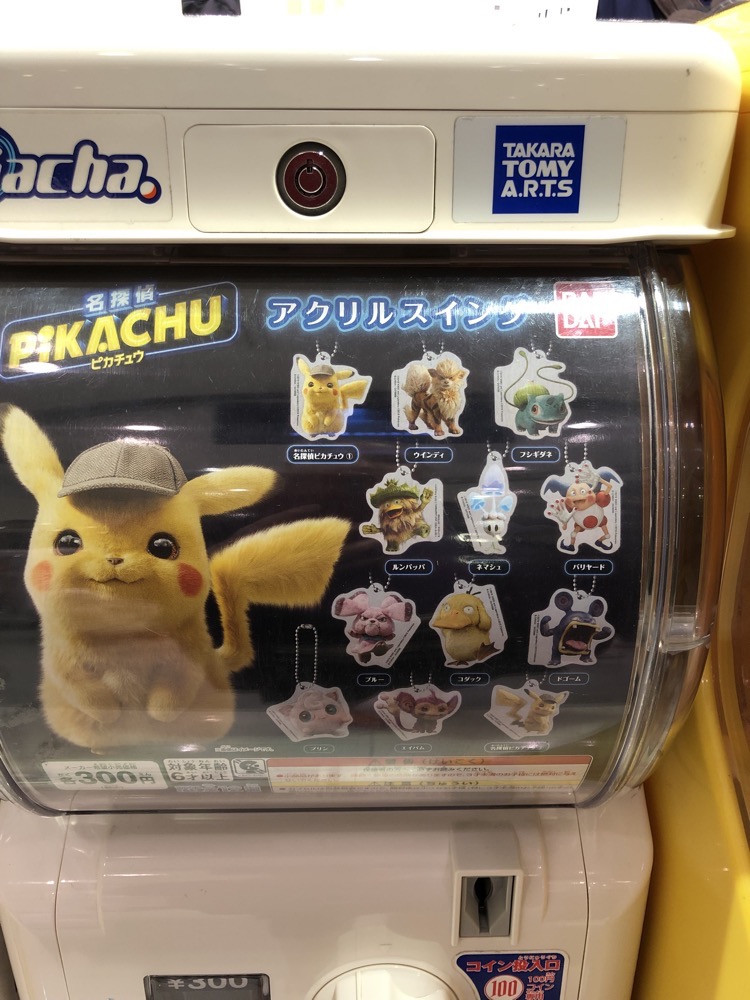 While we were at the Pokemon Centre, there was a Pokemon Trading Card game tournaments happening – there must have been 150 kids and adults all playing the trading card games. Some having a lot of fun and smiling and not taking it too seriously, and some looking very studious. Having never been to a game tournament like this, I thought it was very interesting.
While we were at the Pokemon Centre, there was a Pokemon Trading Card game tournaments happening – there must have been 150 kids and adults all playing the trading card games. Some having a lot of fun and smiling and not taking it too seriously, and some looking very studious. Having never been to a game tournament like this, I thought it was very interesting.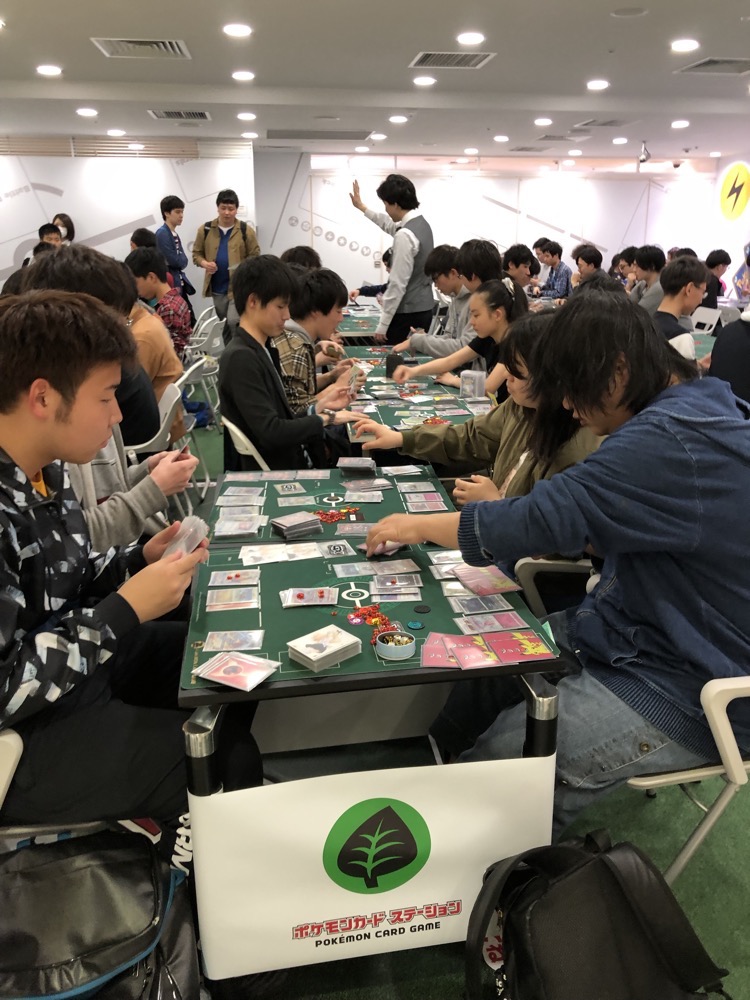 I have no idea how the game is played or what’s involved, but I couldn’t help but wonder if this little kid was kicking arse! 😉
I have no idea how the game is played or what’s involved, but I couldn’t help but wonder if this little kid was kicking arse! 😉 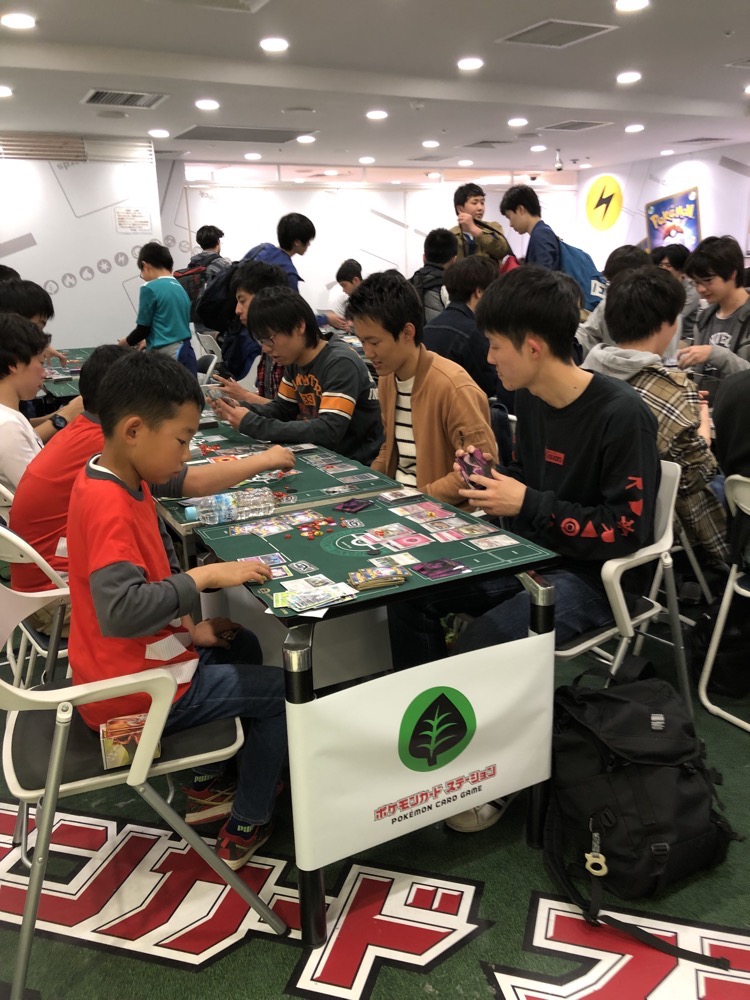 After this stop, we did some general shopping and ended up calling it a day. Navigating Osaka in the crowds is somewhat harrowing at the best of times, navigating the trains during Golden Week is crazy – mind you, even though everywhere seems to be packed full of domestic tourists at the moment, everything feels orderly, friendly and super polite. I can’t imagine this many people being this well behaved anywhere else in the world. ‘take
After this stop, we did some general shopping and ended up calling it a day. Navigating Osaka in the crowds is somewhat harrowing at the best of times, navigating the trains during Golden Week is crazy – mind you, even though everywhere seems to be packed full of domestic tourists at the moment, everything feels orderly, friendly and super polite. I can’t imagine this many people being this well behaved anywhere else in the world. ‘take